Woke up in our odd little B&B and were getting ready to head out to find a cafe for breakfast, when our host turned up with a picnic basket full of breads, and cheese, salami, tomatoes, jam, yoghurt, juice and all good things! I am pretty sure we told him we didn’t need breakfast – but it was awesome nonetheless (yep, also pretty sure it’ll be on the bill!).
Stepped outside onto the streets of Vilnius and discovered it’s a little chilly, about 7C but Icleand seems to recalibrated my idea of ‘cold’, so I was happy in just a light longsleeved top and a light (Brisbane summer evening) jumper, while people everywhere were wearing puffy jackets, scarves and hats.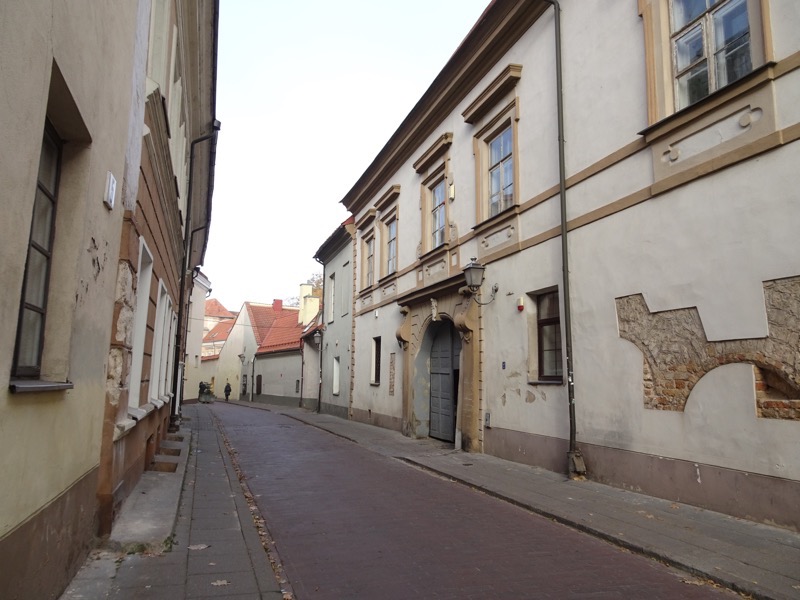 First area we head towards was towards the Vilnius Cathedral where we first encountered Gediminas. I thought he was King Gediminas but apparently no, he was Grand Duke Gediminas of Lithuania (c1275 – 1341) which is a pretty fancy title imho. Gediminas is believed to have founded the political entity that was Lithuania and is credited with expanding its territories from the Baltic to the Black Sea. He is one of the most important persons in early Lithuanian histor – he built the capital, Vilnius, and establishing a dynasty that at one point ruled over parts of Poland, Hungary and Bohemia.
First area we head towards was towards the Vilnius Cathedral where we first encountered Gediminas. I thought he was King Gediminas but apparently no, he was Grand Duke Gediminas of Lithuania (c1275 – 1341) which is a pretty fancy title imho. Gediminas is believed to have founded the political entity that was Lithuania and is credited with expanding its territories from the Baltic to the Black Sea. He is one of the most important persons in early Lithuanian histor – he built the capital, Vilnius, and establishing a dynasty that at one point ruled over parts of Poland, Hungary and Bohemia.
Bad lighting; cool statue though: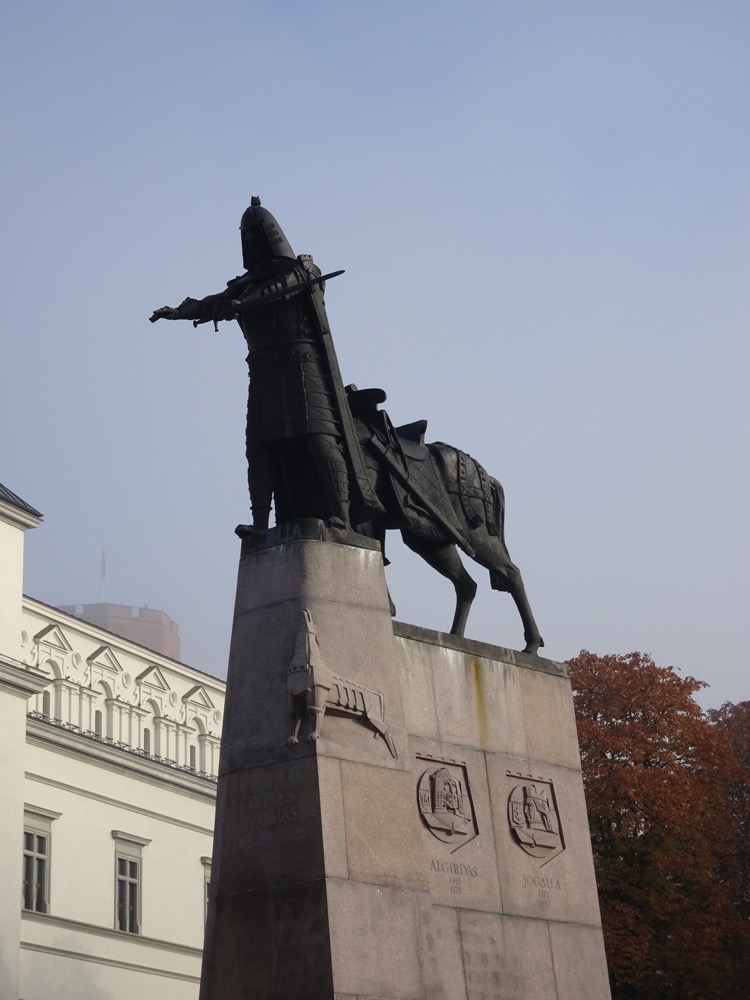 Nearby is the The Cathedral Basilica of St Stanislaus and St Ladislaus of Vilnius or the Vilnius Cathedral which is the main Roman Catholic Cathedral of Lithuania and considered the heart of the church and Catholicism Lithuania.
Nearby is the The Cathedral Basilica of St Stanislaus and St Ladislaus of Vilnius or the Vilnius Cathedral which is the main Roman Catholic Cathedral of Lithuania and considered the heart of the church and Catholicism Lithuania.
The coronations of the Grand Dukes of Lithuania took place here (of which there were many!), and most of them ended up buried here in its crypts and catacombs too. Weirdly the heart of the Polish king, Władysław IV Vasa was buried here but the rest of his body is at Wawel Cathedral in Kraków (been there!). The chapel has a rather imposing Renaissance facade (due to the construction that ‘stuck’ being done in the 1500s)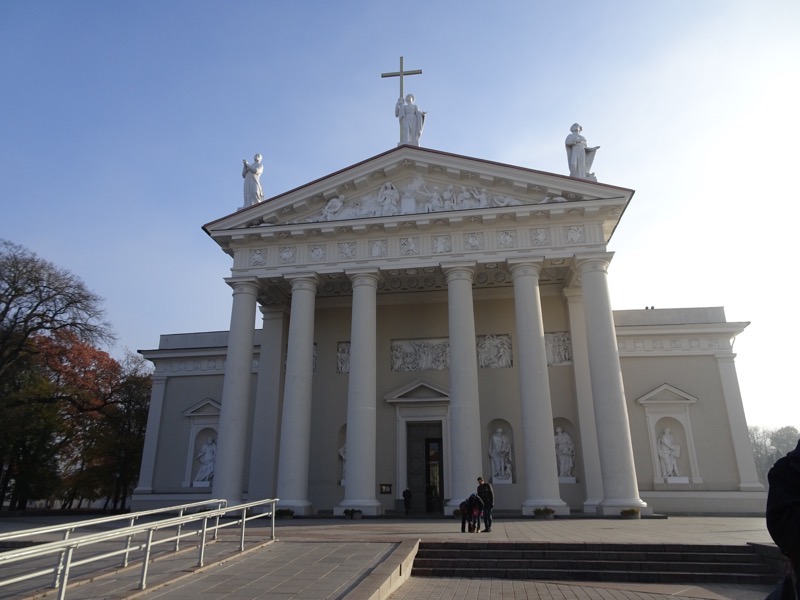
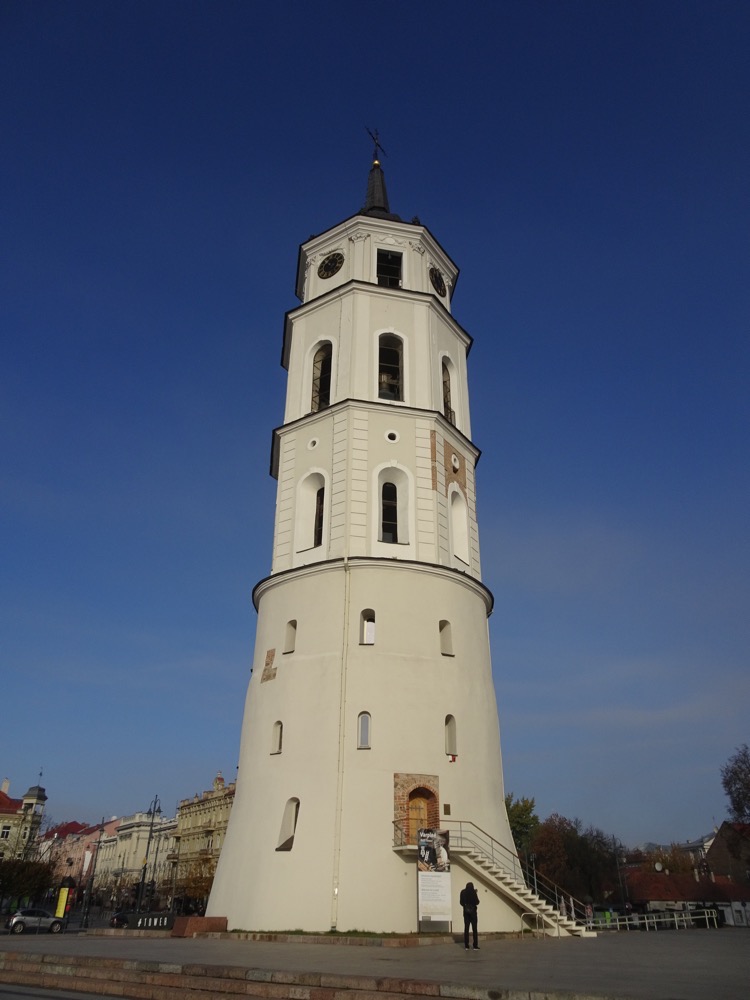
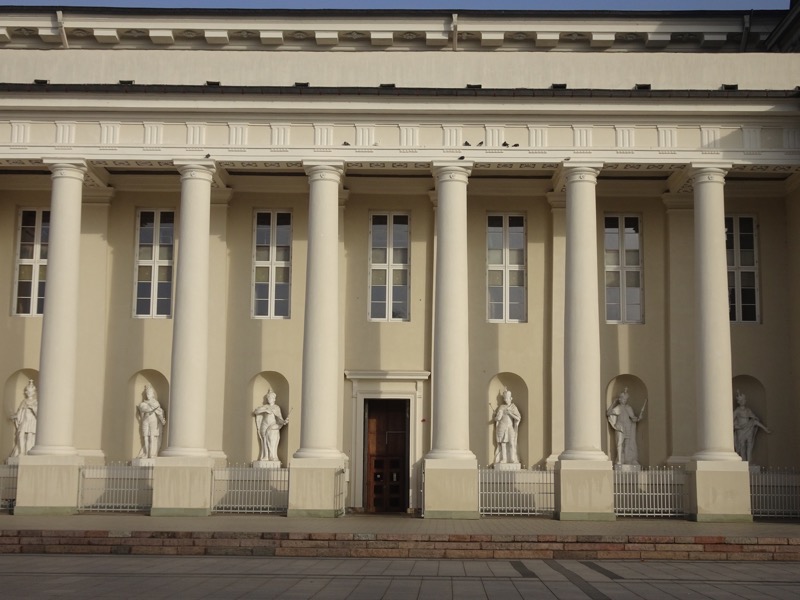
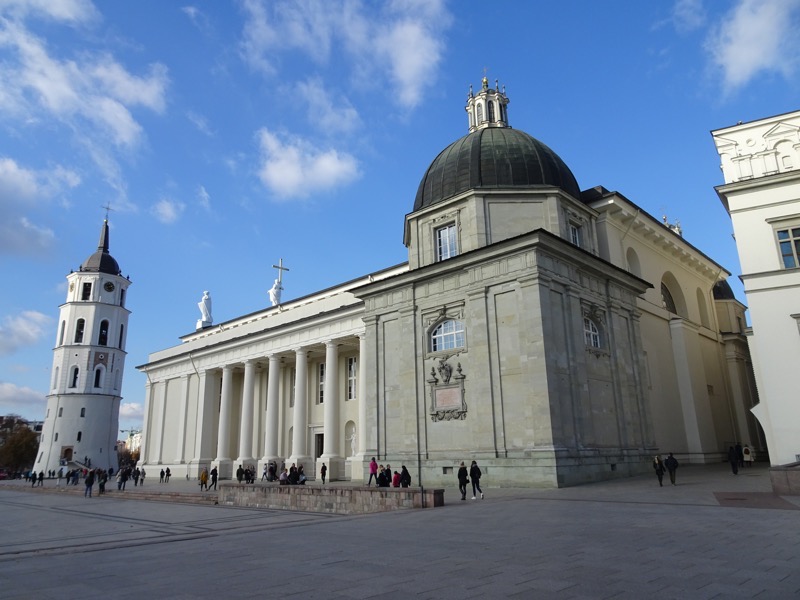 It is thought that the Lithuanian King Mindaugas (he first known Grand Duke of Lithuania and the only King of Lithuania) ordered the construction of the first cathedral on this site in 1251, after he converted to Christianity and appointed a bishop to Lithuania. Remains of an archaic quadratic church with three naves and massive buttresses were discovered beneath the current structure in the late 20th century. After Mindaugas karked it however, in 1263, that cathedral went back to being a place of pagan worship again.
It is thought that the Lithuanian King Mindaugas (he first known Grand Duke of Lithuania and the only King of Lithuania) ordered the construction of the first cathedral on this site in 1251, after he converted to Christianity and appointed a bishop to Lithuania. Remains of an archaic quadratic church with three naves and massive buttresses were discovered beneath the current structure in the late 20th century. After Mindaugas karked it however, in 1263, that cathedral went back to being a place of pagan worship again. 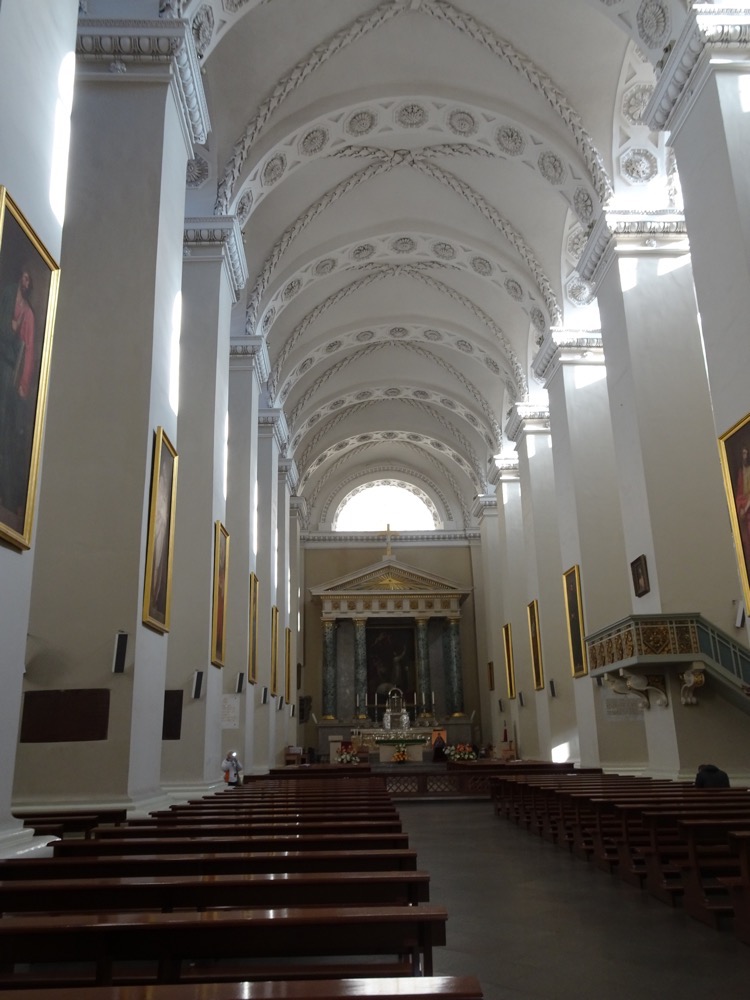 This being Europe and all, the cathedral has a convoluted history. Around 1387, Lithuania officially converted to Christianity, they started building a second larger Gothic cathedral with five separate chapels. This one burnt down in 1419 and they planned a new larger Gothic cathedral in 1429 for the coronation of Vytautas who was suppposed to become King of Lithuania. His coronation never happened but the walls and pillars of that third Cathedral have survived to today and it has three naves and four circular towers at its corners. In 1522, the cathedral was renovated, and a bell tower was built outside on top of an old castle defensive tower. Another fire destroyed the cathedral in 1530, so it was rebuilt again around1534 – 1557 and more chapels and crypts were added. The cathedral was burnt again, built again, fell to Russian troops, was destroyed and restored several more times by more famous dukes and kings… and all that before the Soviets got hold of it in the 20th century.
This being Europe and all, the cathedral has a convoluted history. Around 1387, Lithuania officially converted to Christianity, they started building a second larger Gothic cathedral with five separate chapels. This one burnt down in 1419 and they planned a new larger Gothic cathedral in 1429 for the coronation of Vytautas who was suppposed to become King of Lithuania. His coronation never happened but the walls and pillars of that third Cathedral have survived to today and it has three naves and four circular towers at its corners. In 1522, the cathedral was renovated, and a bell tower was built outside on top of an old castle defensive tower. Another fire destroyed the cathedral in 1530, so it was rebuilt again around1534 – 1557 and more chapels and crypts were added. The cathedral was burnt again, built again, fell to Russian troops, was destroyed and restored several more times by more famous dukes and kings… and all that before the Soviets got hold of it in the 20th century.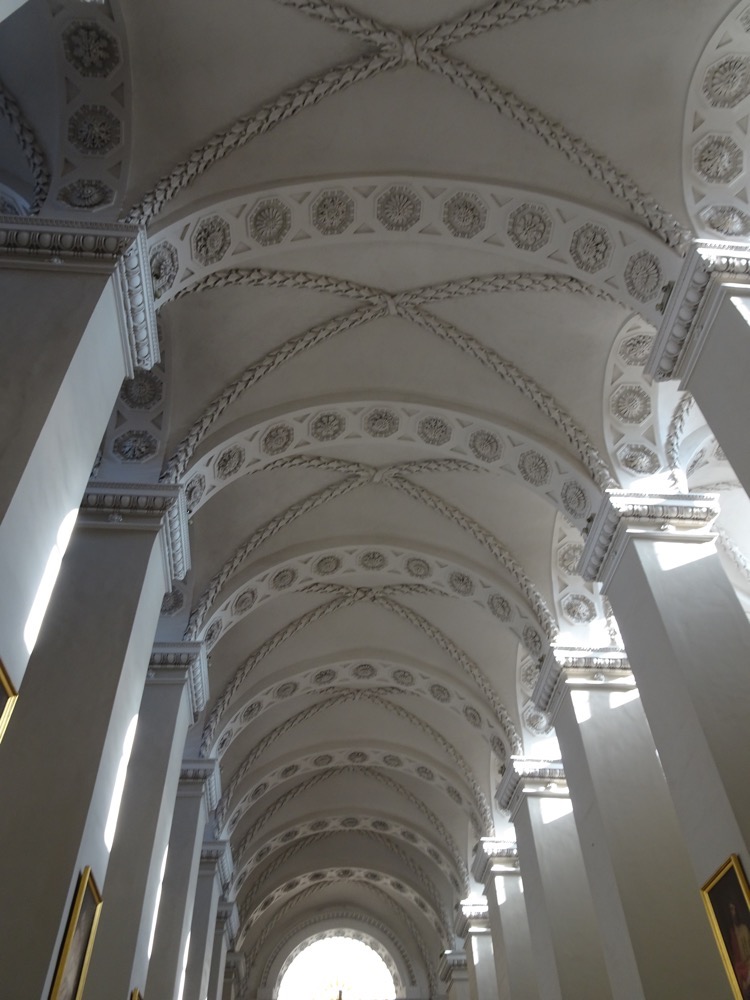 Chapel of Saint Casimir:
Chapel of Saint Casimir: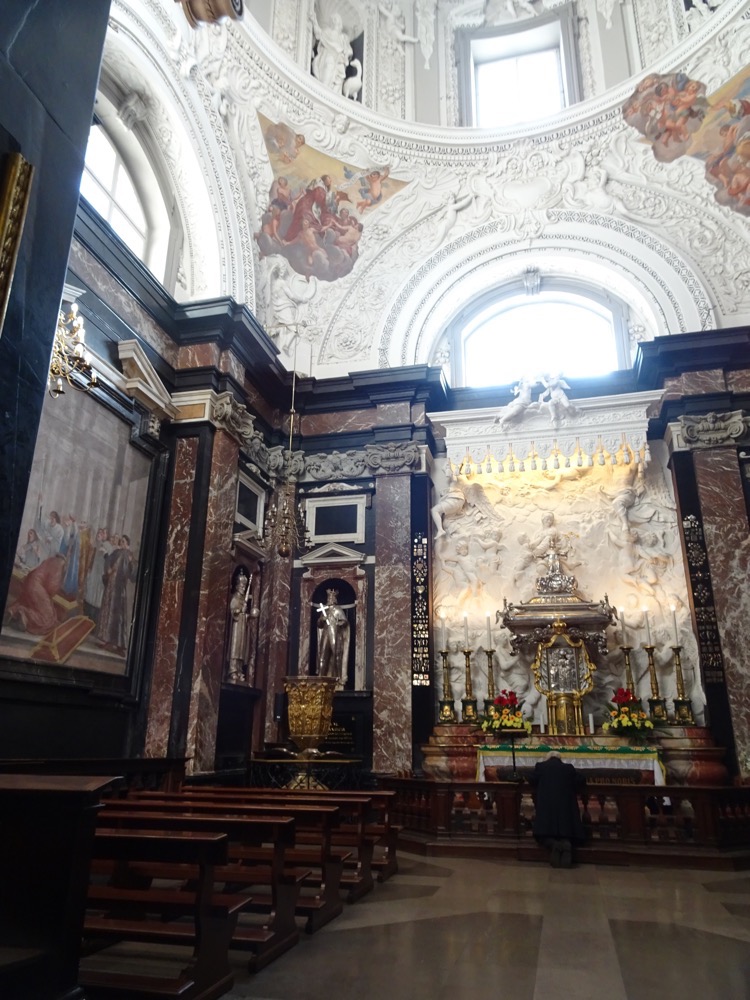
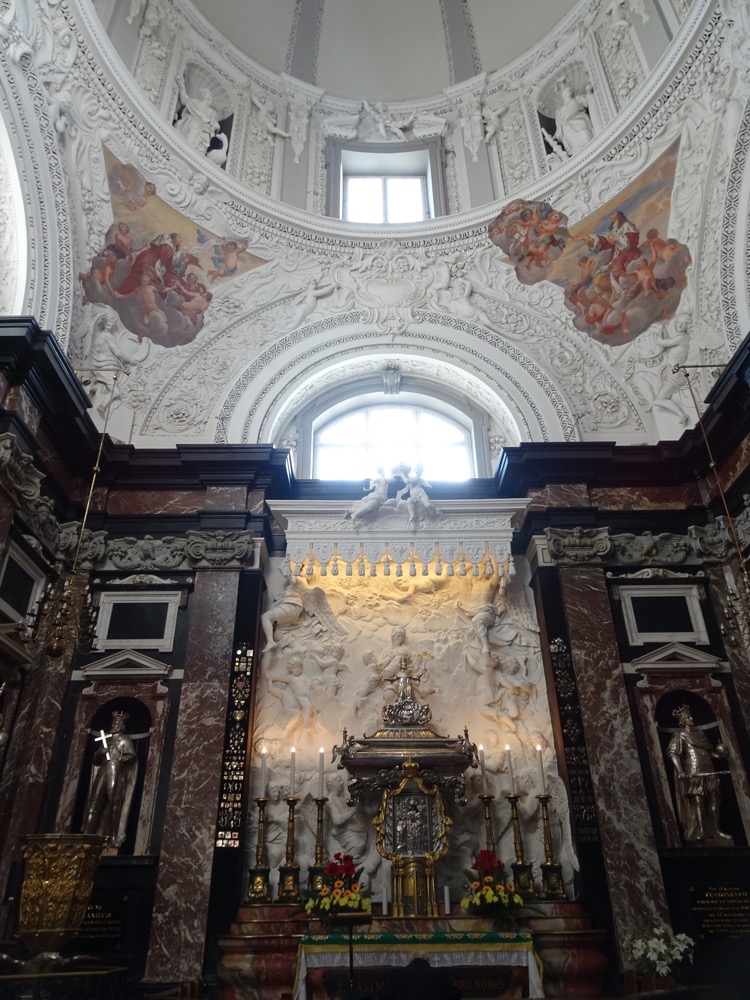 During the Soviet regime the cathedral was converted into a warehouse of all things, and masses were not celebrated here again until 1988. In 1989 its offical status as a cathedral was restored and it has been Vilnius’ main cathedral since that time.
During the Soviet regime the cathedral was converted into a warehouse of all things, and masses were not celebrated here again until 1988. In 1989 its offical status as a cathedral was restored and it has been Vilnius’ main cathedral since that time.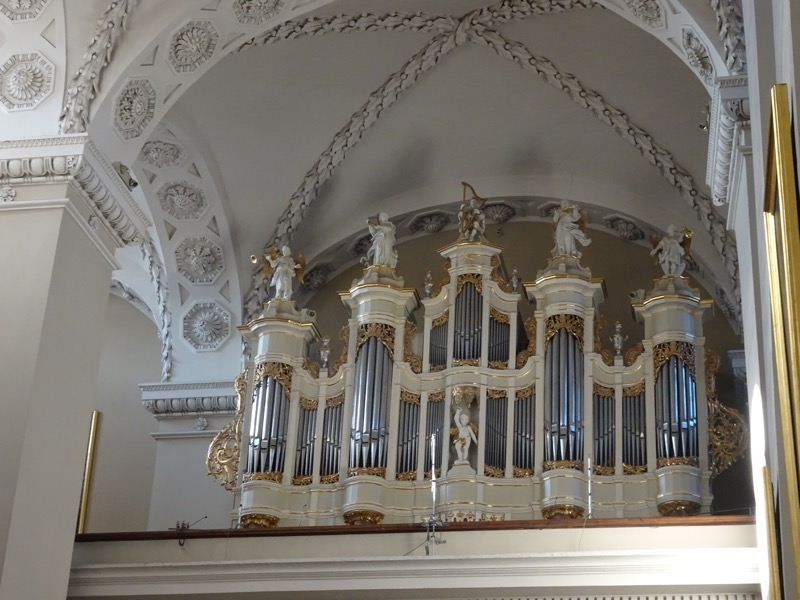
Outside the cathedral is a marker of the ‘Batlic Way’ which was a 1989 demonstration also known as the ‘Chain of Freedom’. The Baltic Way was a peaceful pro-independence political demonstration that occured on August 23 1989 and consisted of approximately 2,000,000 people joining hands to form a human chain that spanned 675kms across three Baltic countries – Lithuania, Latvia and Estonia – that were still constituent republics of the Soviet Union. The aim was draw international attention to the popular desire for independence for each of these three states, to demonstrate solidarity between the nations and to push back against the Soviet rule. The Soviets reponded with strong rhetoric but did not take any punitive actions agasint the protestors – within seven months, Lithuania becaem the first state to declare independence from being a Soviet republic.
There is apparently matching bronzed feet in Tallinn and Riga, so we will have to keep an eyes out for those.
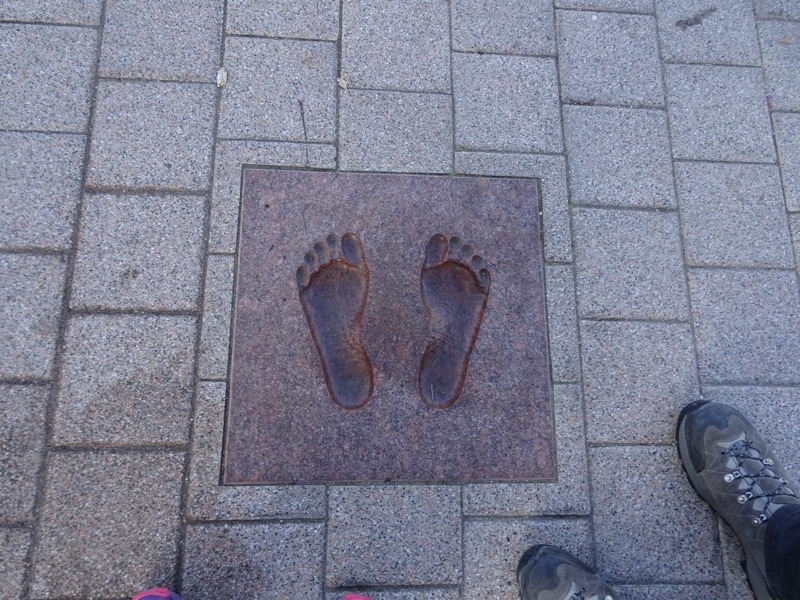
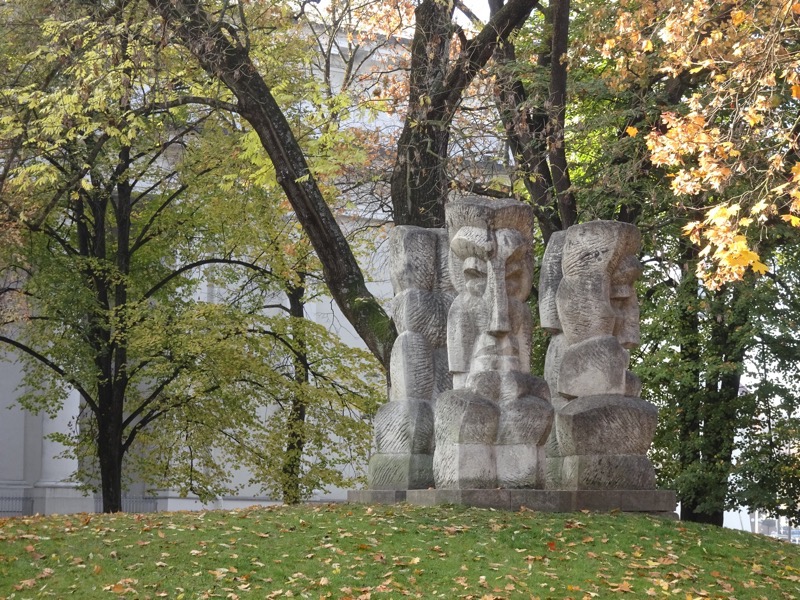
Around the corner from the Vilnius Cathedral is the National Museum locaed in the New Arsenal, which is one of the oldest and largest museums in Lithuania, ‘containing rich material about the history of the state and the national culture.’ The building itself is interesting and combines different styles. The slightly curved main facade is 130m long and follows the line of the original 14th century city wall which is was built on. 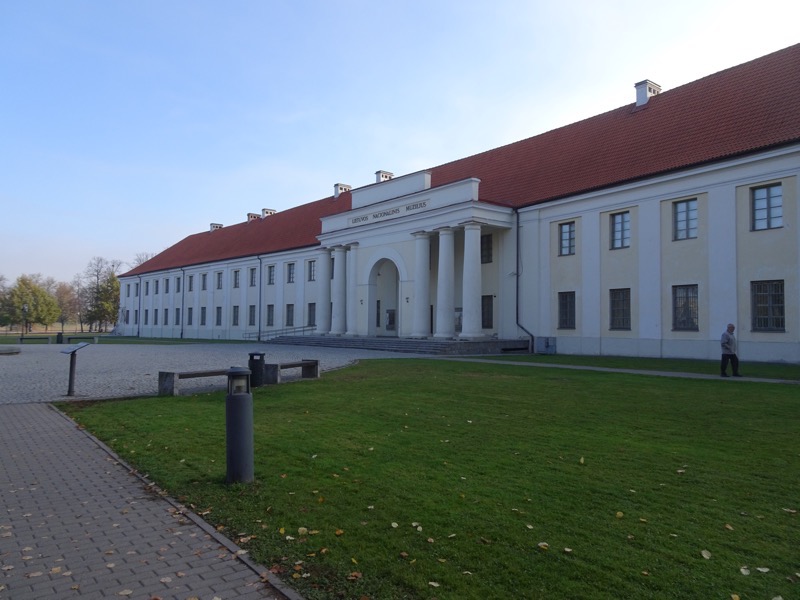 In the square in the front of the musuem is a monument to King Mindaugas, the founder of the Lithuanian state.
In the square in the front of the musuem is a monument to King Mindaugas, the founder of the Lithuanian state.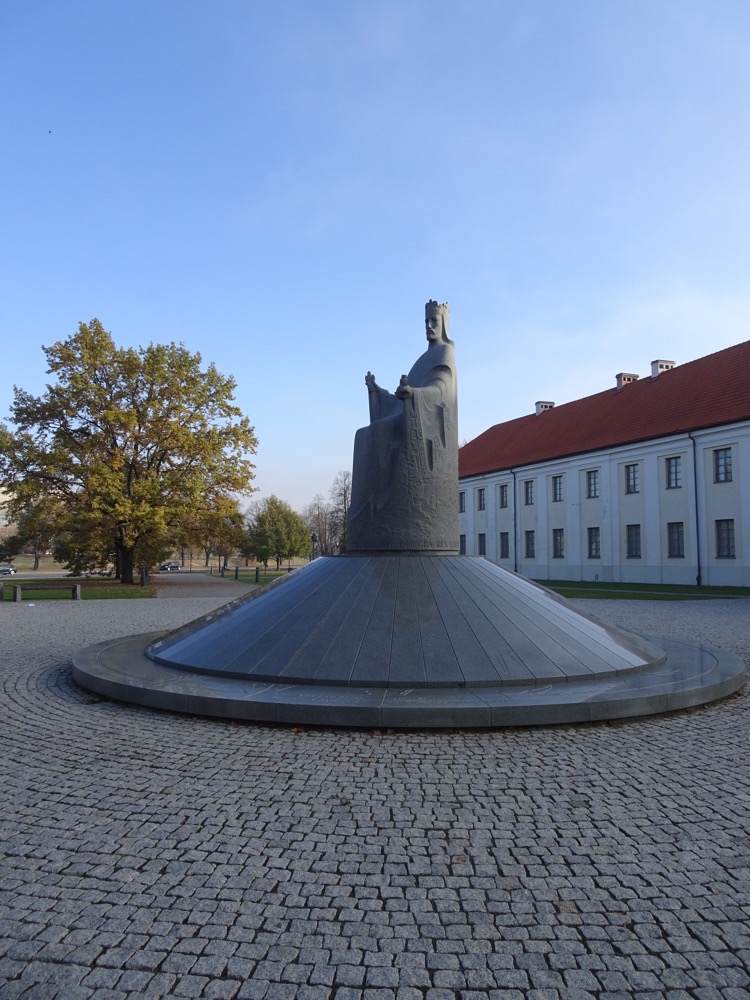 Inside we discovered many antiques, antiquities and odd things, none of which seemed to have been curated with any real theme? intent? or cohesion? It was all very odd.
Inside we discovered many antiques, antiquities and odd things, none of which seemed to have been curated with any real theme? intent? or cohesion? It was all very odd.
17th Lithuanian timber bench: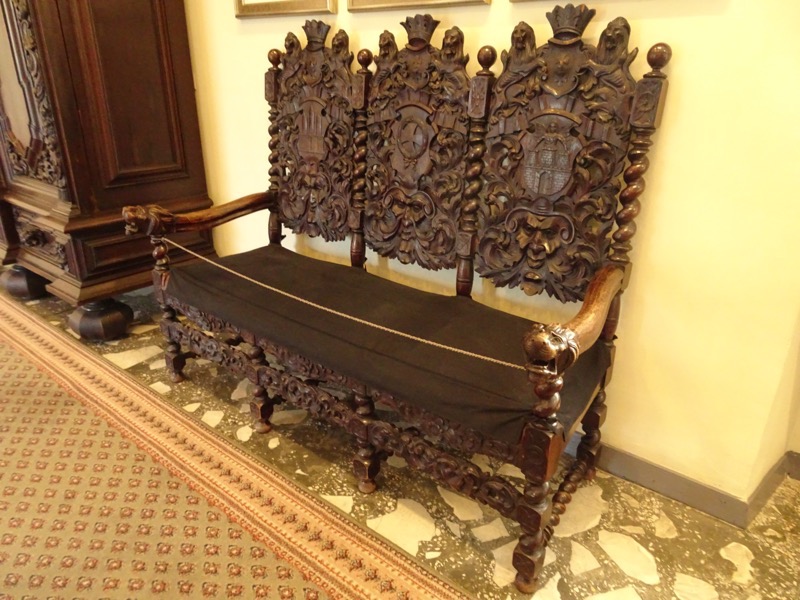 Urn, 4th century, Southern Italy:
Urn, 4th century, Southern Italy: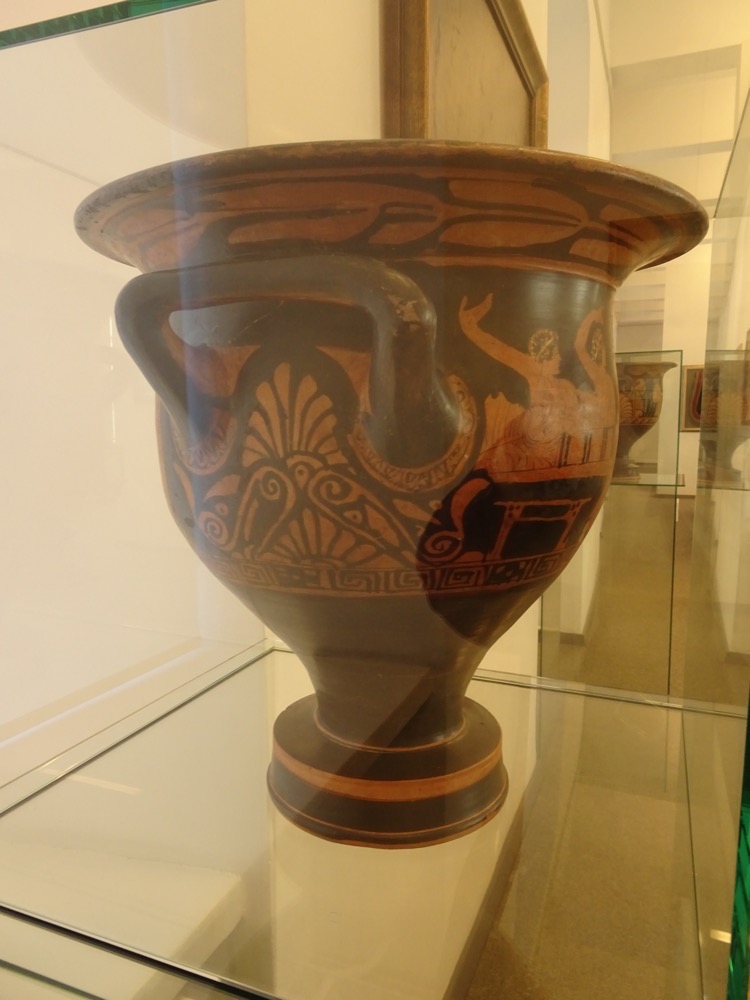
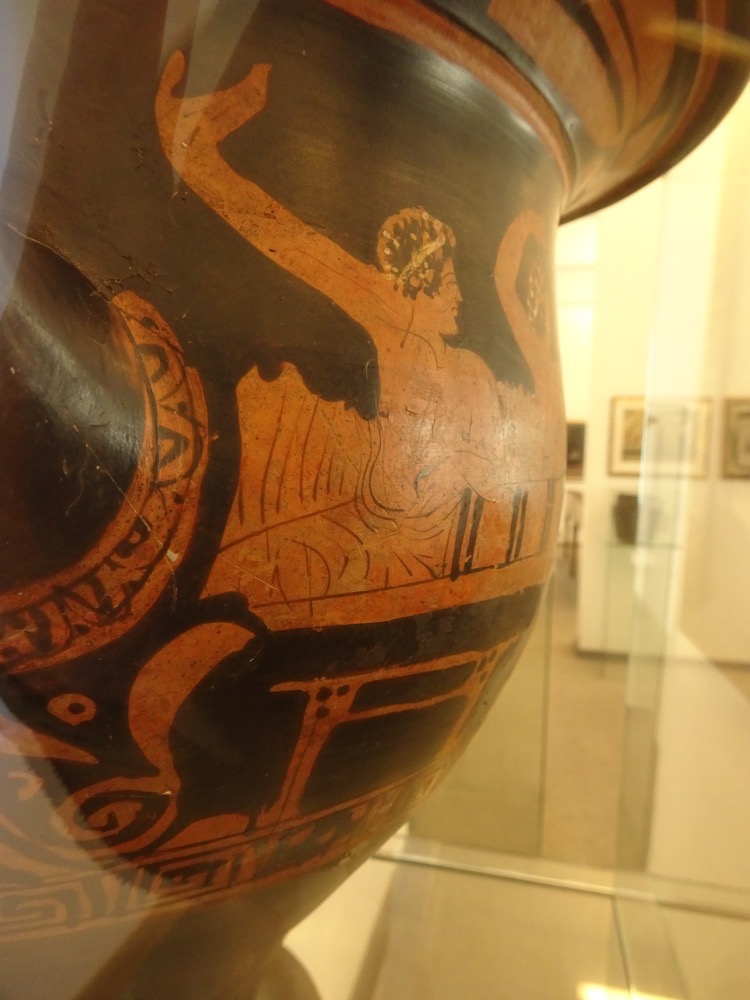 Lithuanian sledge, c.1700-1750.
Lithuanian sledge, c.1700-1750.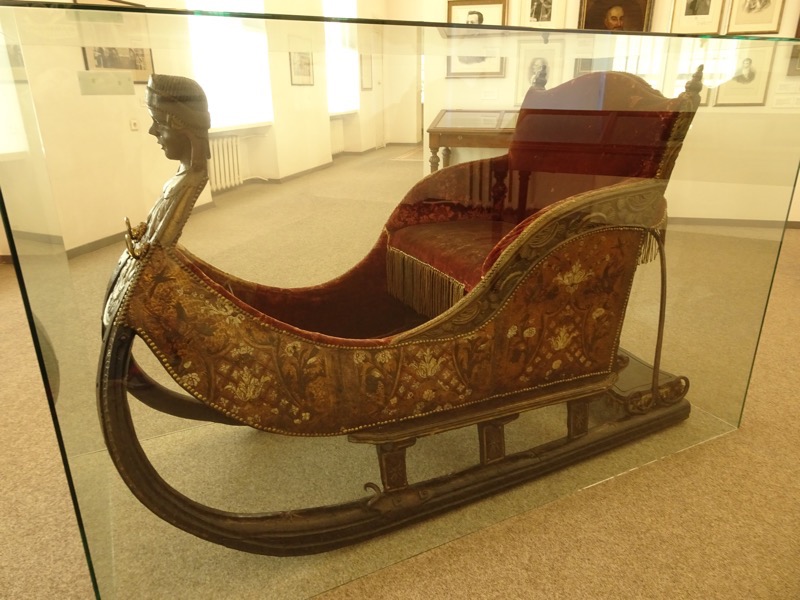 Sarcophagus received as a gift by Museum of Antiquities in 1899 from Prince Chlodwig Karl Viktor Hohenlohe, then German Chancellor. Originates from Egypt (obviously) but no mention of date, location or what tomb it came from?
Sarcophagus received as a gift by Museum of Antiquities in 1899 from Prince Chlodwig Karl Viktor Hohenlohe, then German Chancellor. Originates from Egypt (obviously) but no mention of date, location or what tomb it came from?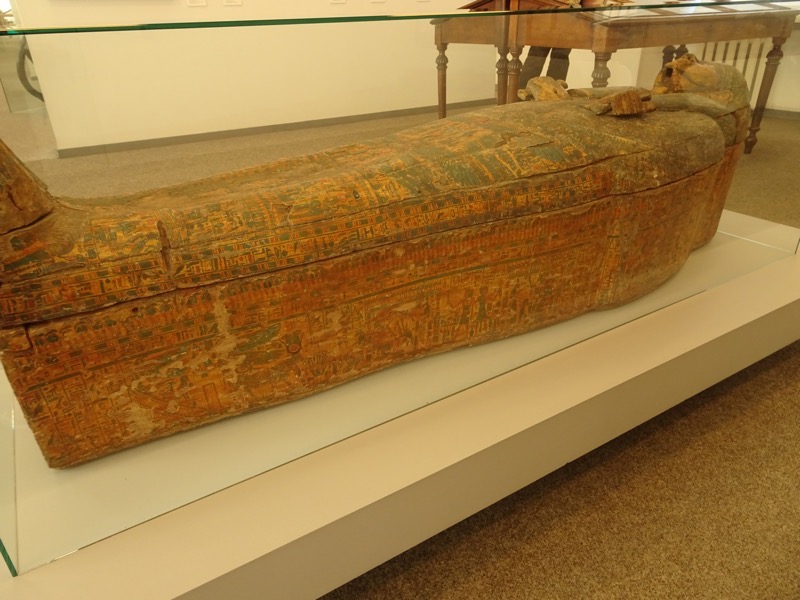
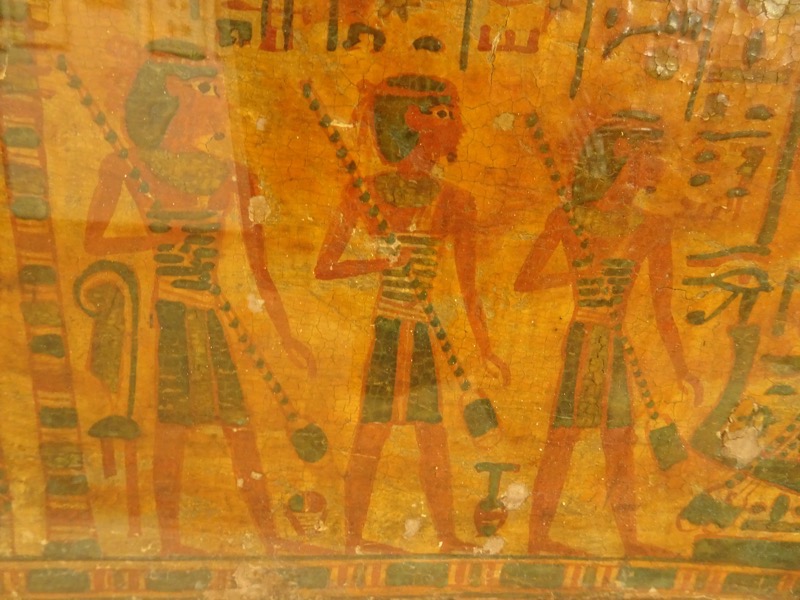 Obelisk with samples of Russian materials, 19th century.
Obelisk with samples of Russian materials, 19th century.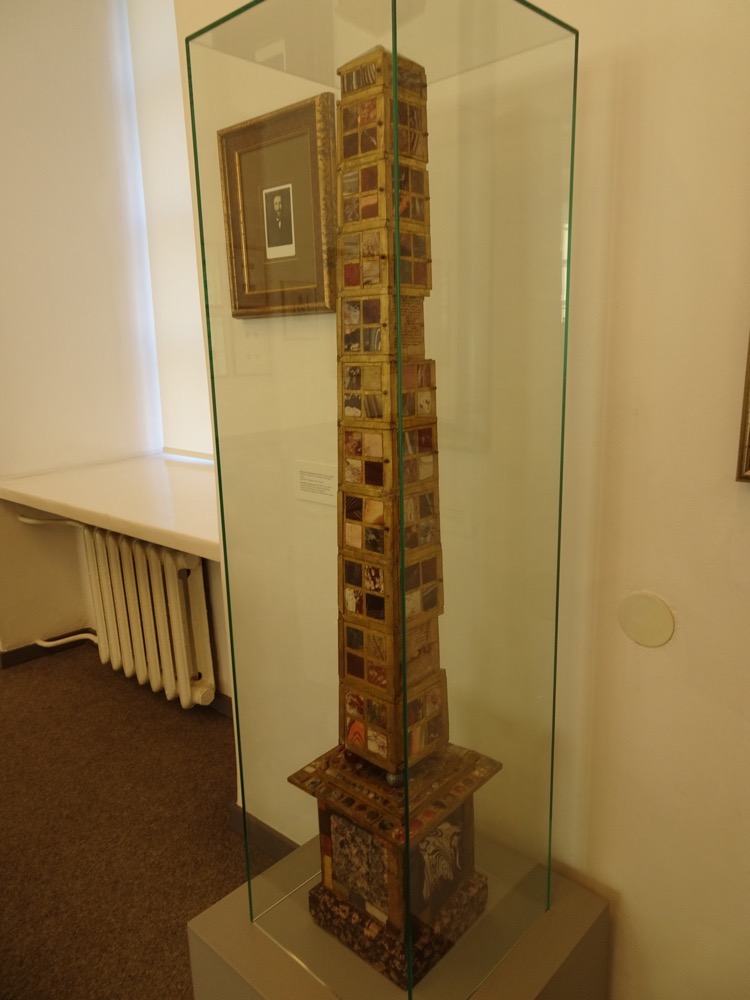
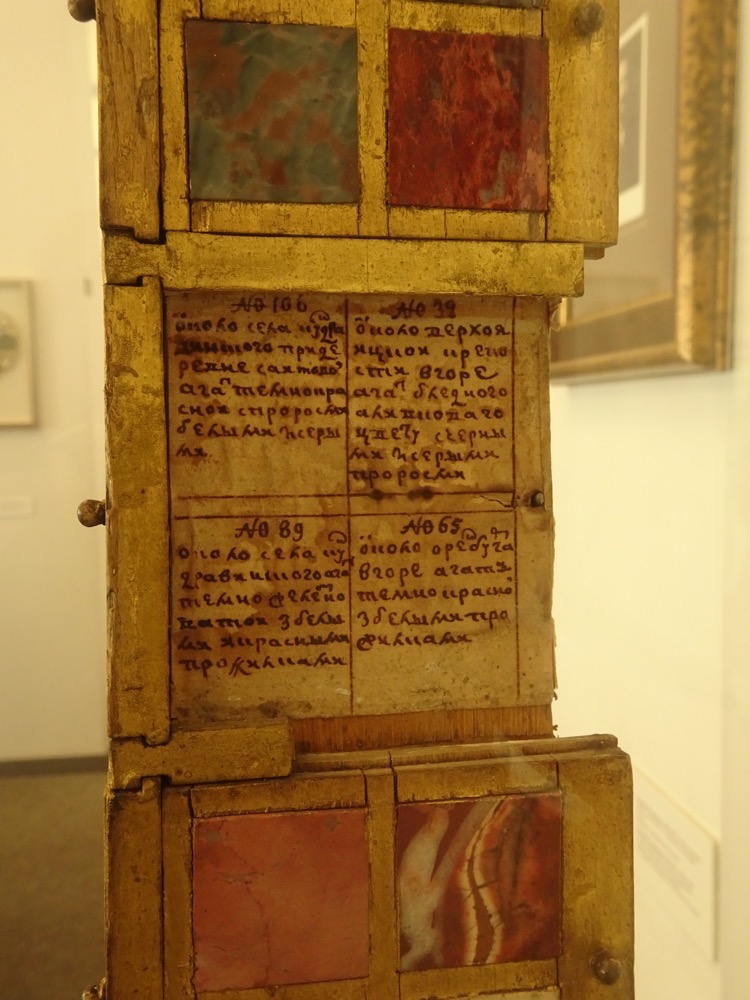 Maria Mnishek (1588-1614, wife of the Czars of Russia, Lzhedmirty I and Lzhedmirty II (did she remarry his brother? her son? his cousin? who knows?) Unknown artist, 1609.
Maria Mnishek (1588-1614, wife of the Czars of Russia, Lzhedmirty I and Lzhedmirty II (did she remarry his brother? her son? his cousin? who knows?) Unknown artist, 1609.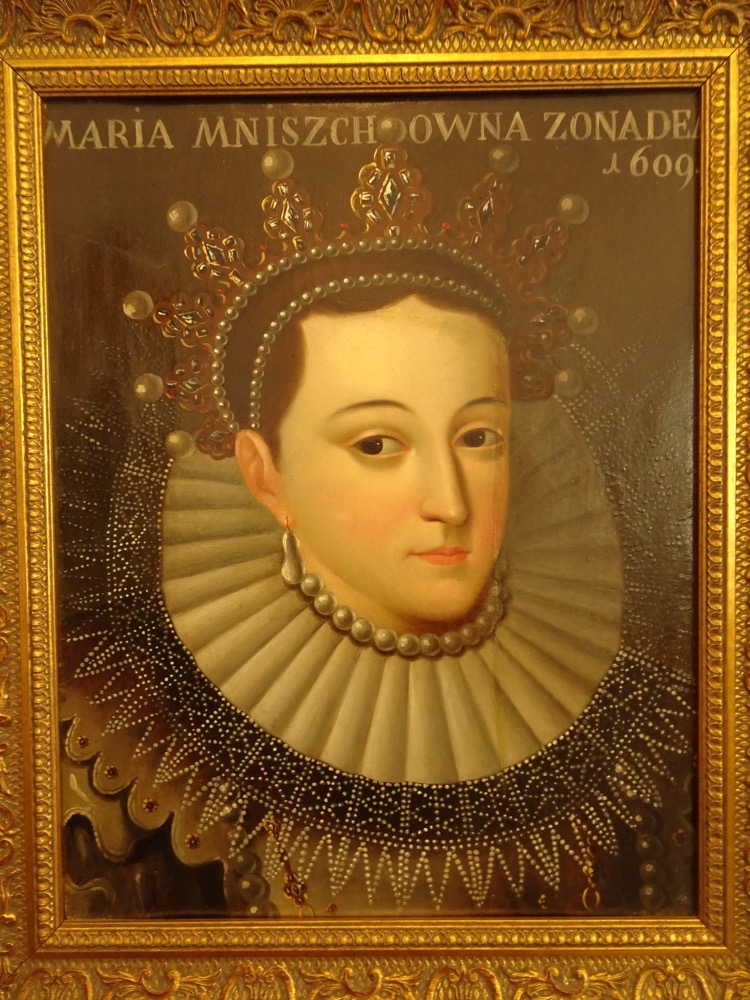 Vytautas the Great, Grand Duke of Lithuania from 1401 to 1430.
Vytautas the Great, Grand Duke of Lithuania from 1401 to 1430.
Sculptor Vytautas Kasuba, 1939 (gypsum covered with aluminium powder)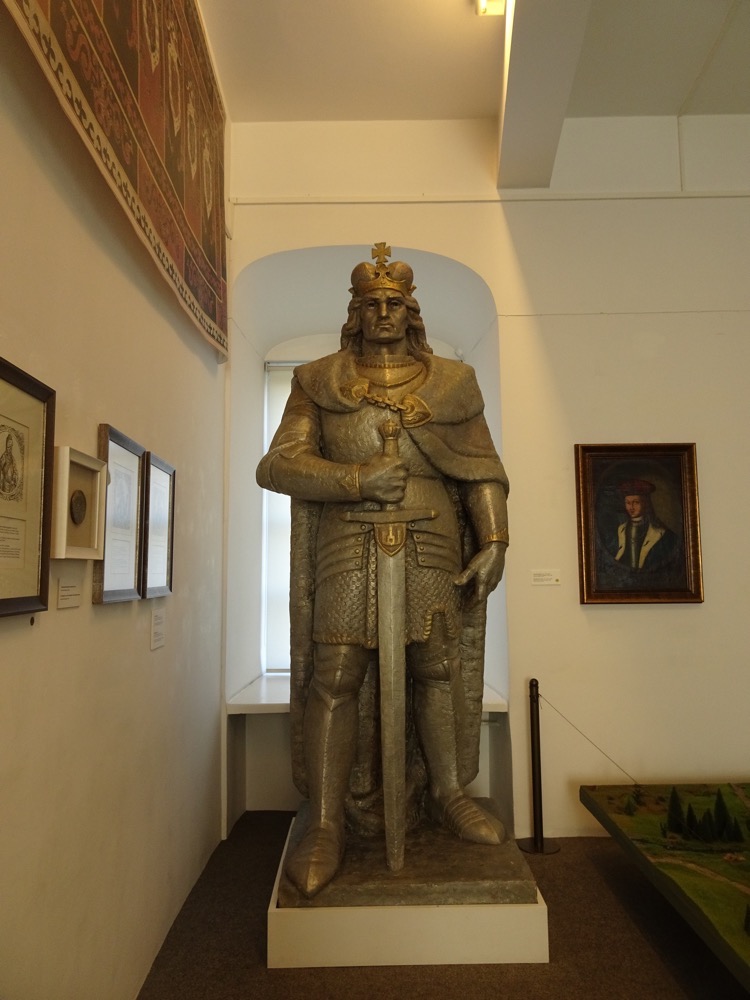 Iron window bars, Lithuanian 16th century (no idea where from?).
Iron window bars, Lithuanian 16th century (no idea where from?).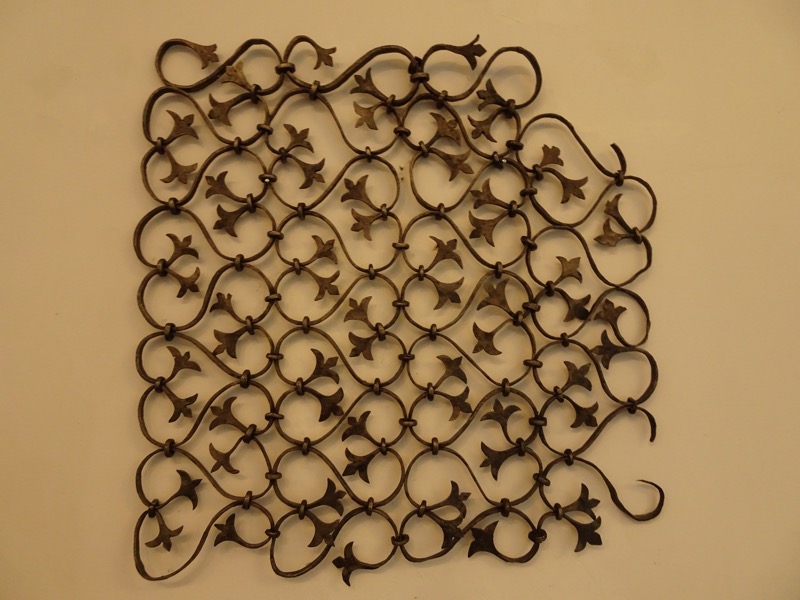
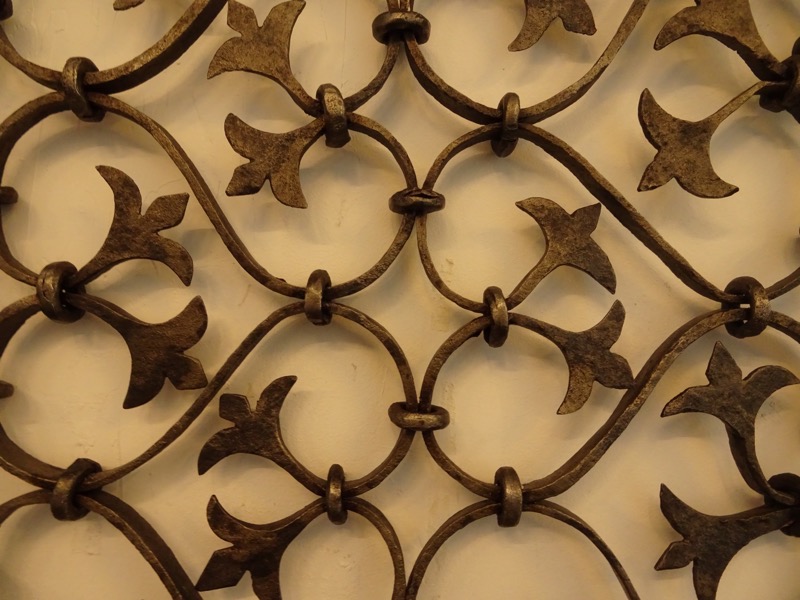 Guild’s chest (which guild?!), Lithuanian 17th century.
Guild’s chest (which guild?!), Lithuanian 17th century.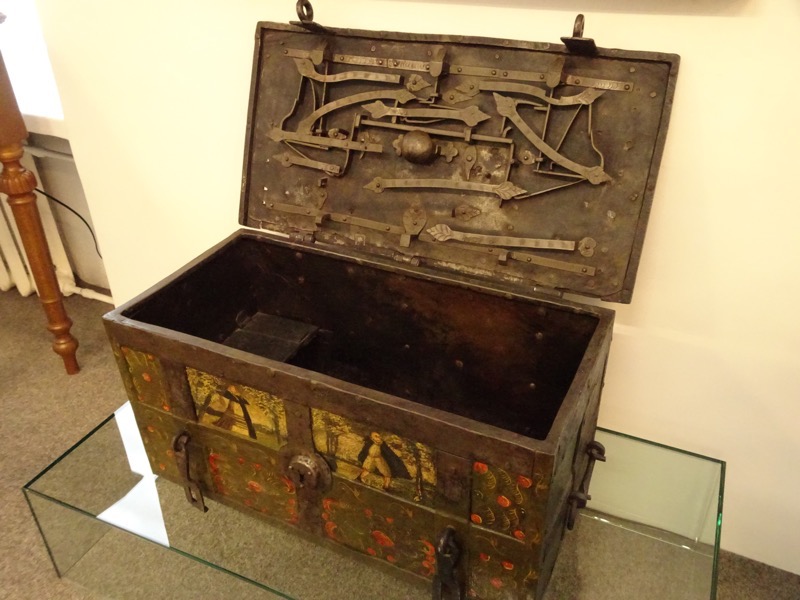
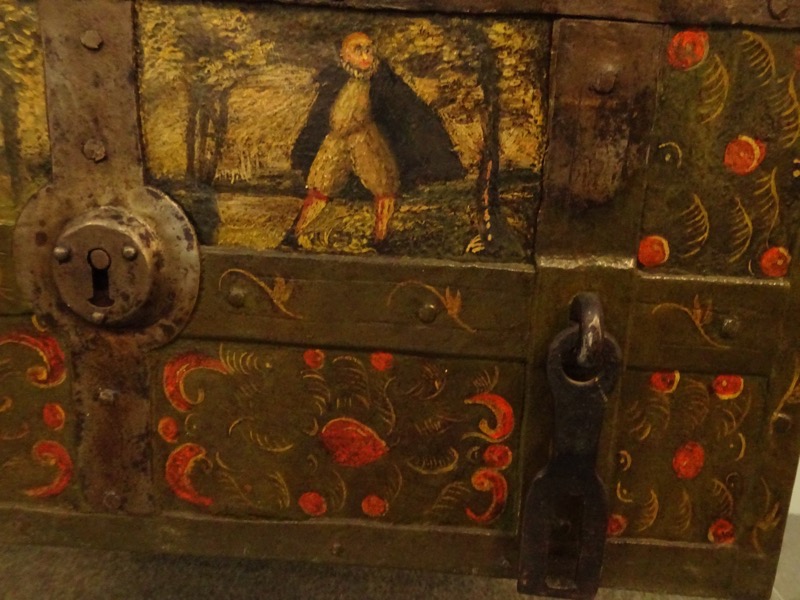
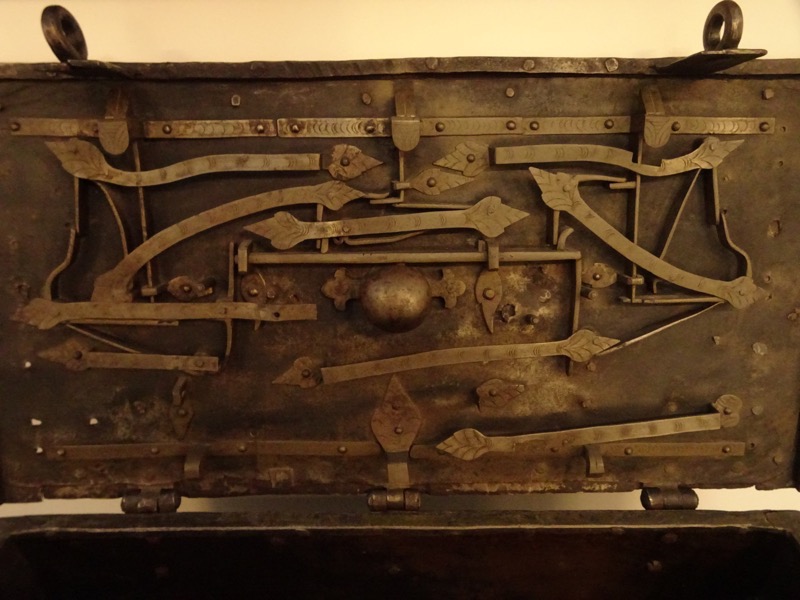 Banner of the Immaculate Conception Fraternity at the Vilnius Bernadine Church, 1600-1650s… in bad need of conservation and repair.
Banner of the Immaculate Conception Fraternity at the Vilnius Bernadine Church, 1600-1650s… in bad need of conservation and repair.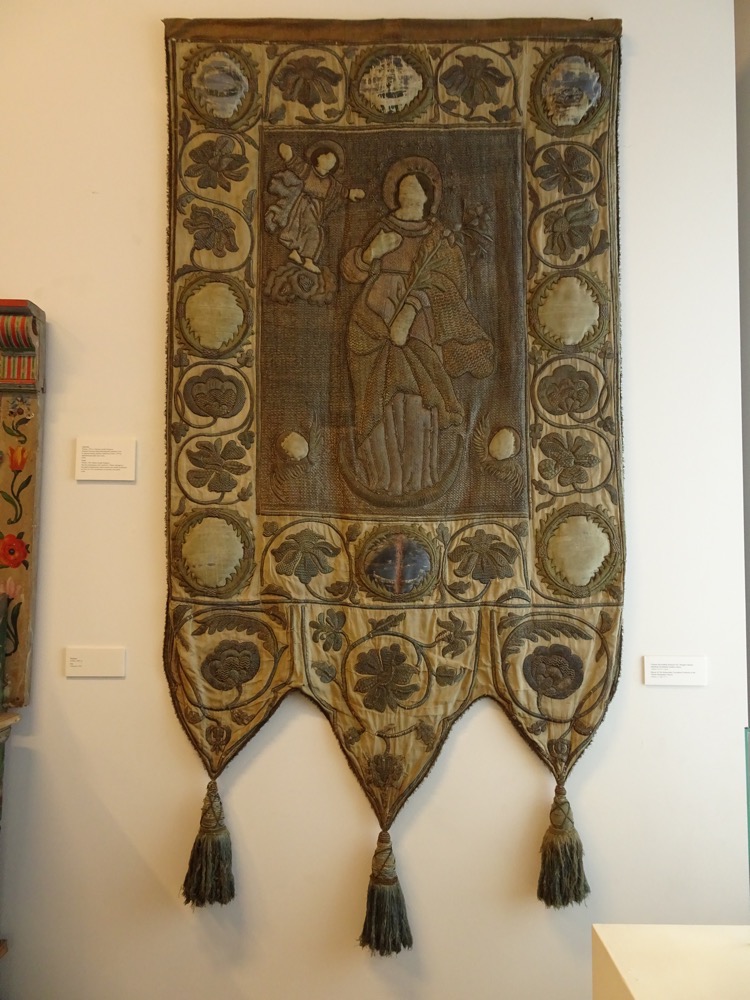
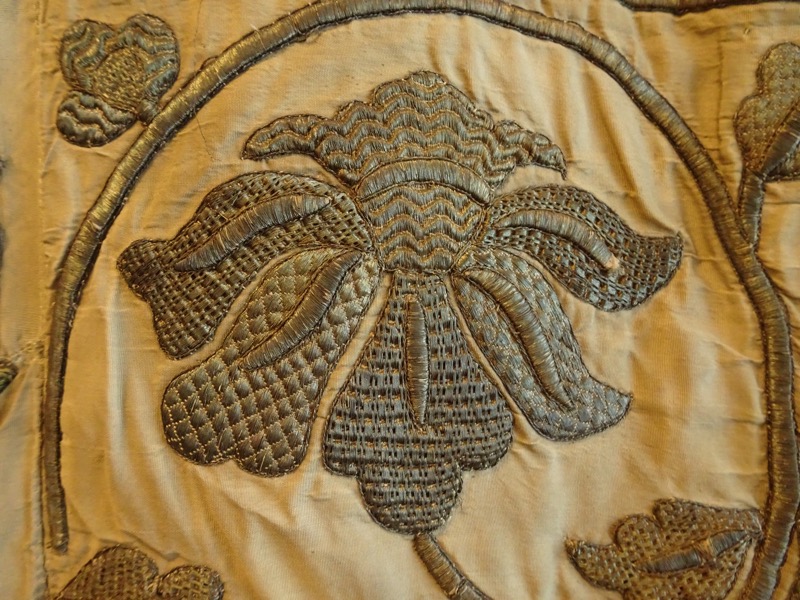 Lithuanian pew, 1683
Lithuanian pew, 1683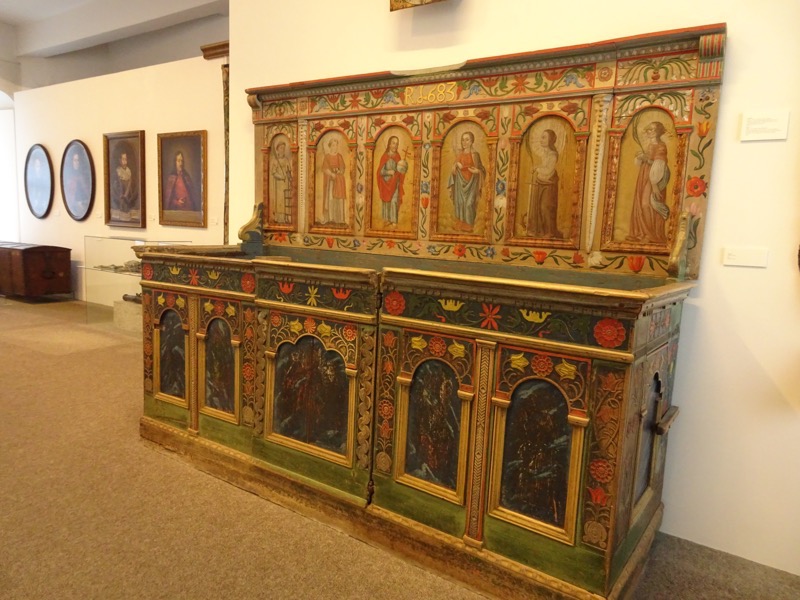
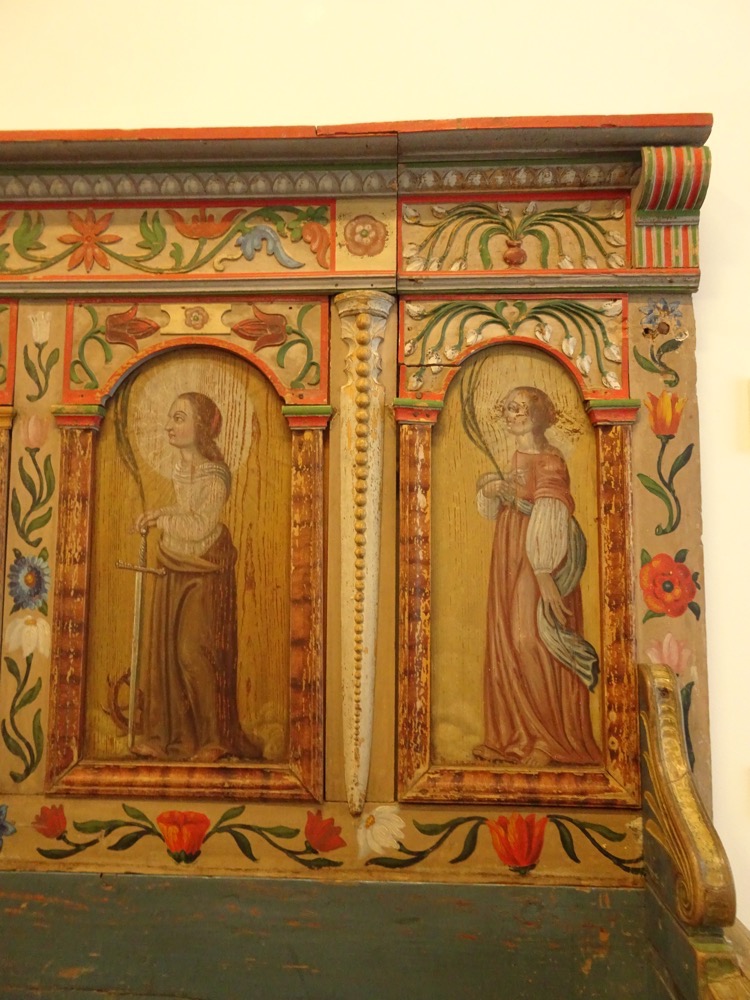 Chest with heraldic device of the Korff and Osten-Sacken families, Latvian c.1680.
Chest with heraldic device of the Korff and Osten-Sacken families, Latvian c.1680.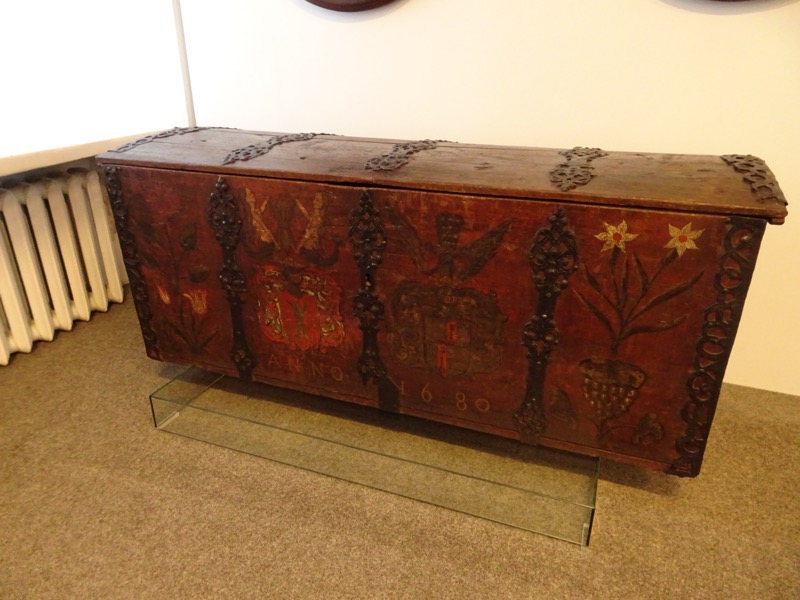 Hook to Drag Plague Victims, Vilnius, earl 18th century… no other information about plague?!
Hook to Drag Plague Victims, Vilnius, earl 18th century… no other information about plague?!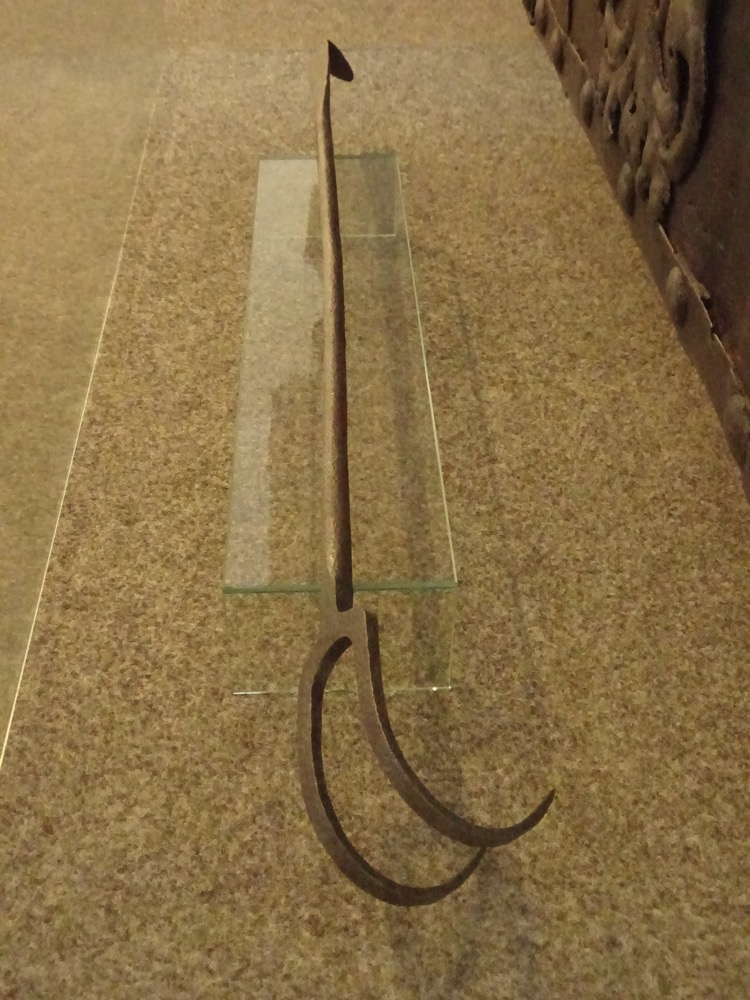 Persian helmet, Turkey, 17th – 18th centuries.
Persian helmet, Turkey, 17th – 18th centuries.
w~ swords, karacena armour, Polish-Lithuania Commonwealth, 17th – 18th centuries.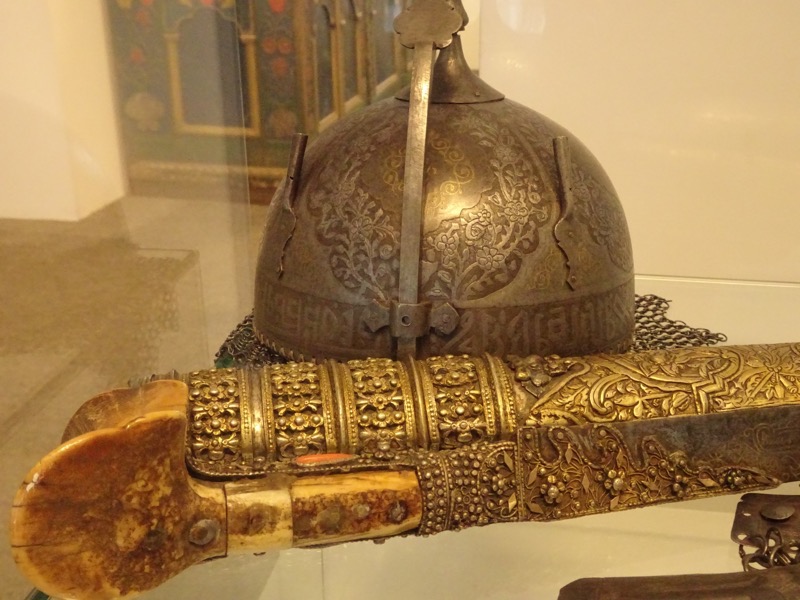 Chair, first half of the 17th century.
Chair, first half of the 17th century. 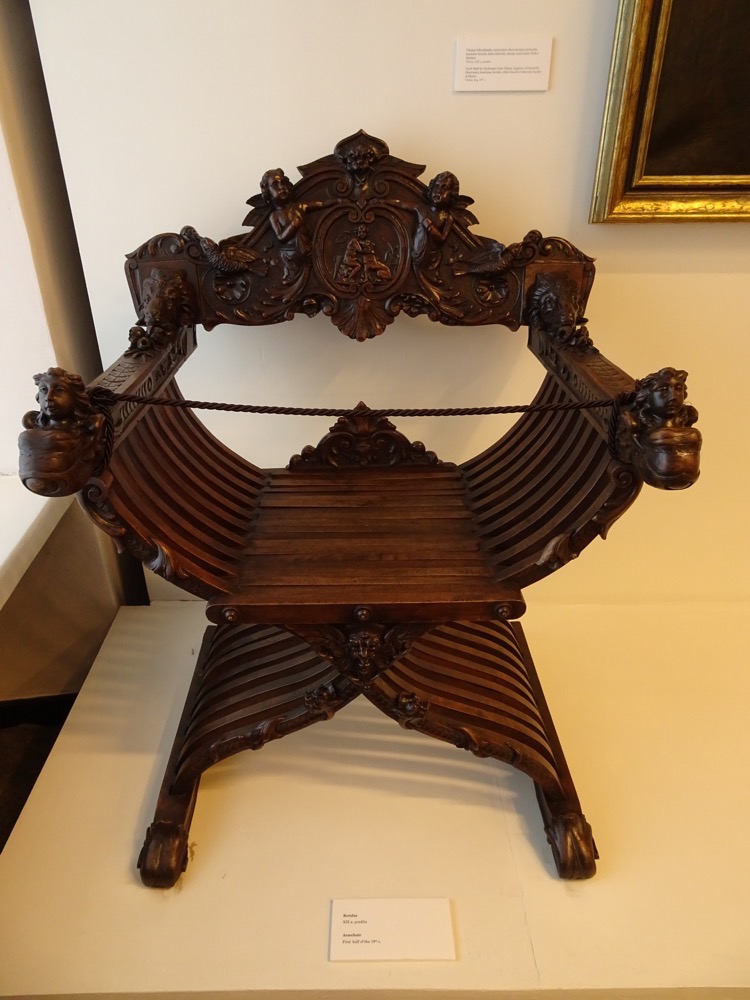
Nearly all the smaller artefacts in this museum were in layers of glass like this case below, making it impossibel to photograph them, and of course – no books on the collection.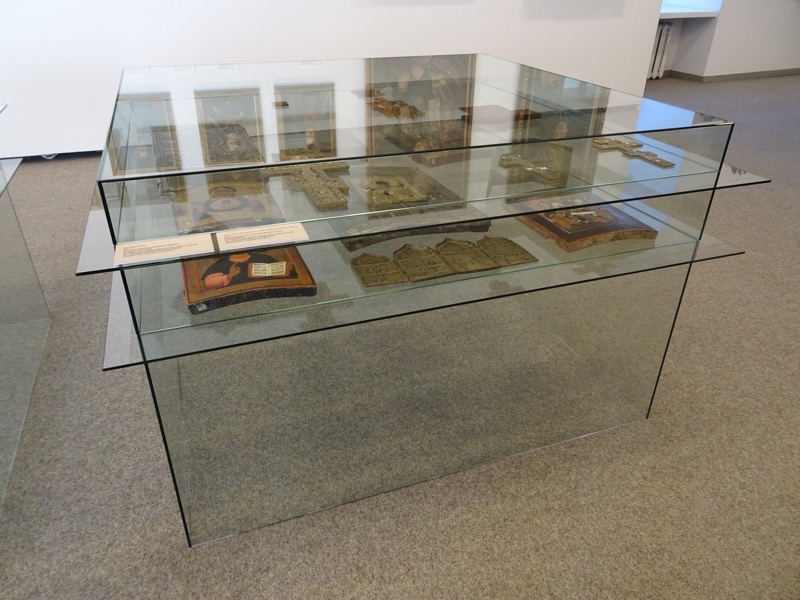 Tablet woven sashes, Lithuanian Minor and South-west Lithuania early 19th century.
Tablet woven sashes, Lithuanian Minor and South-west Lithuania early 19th century.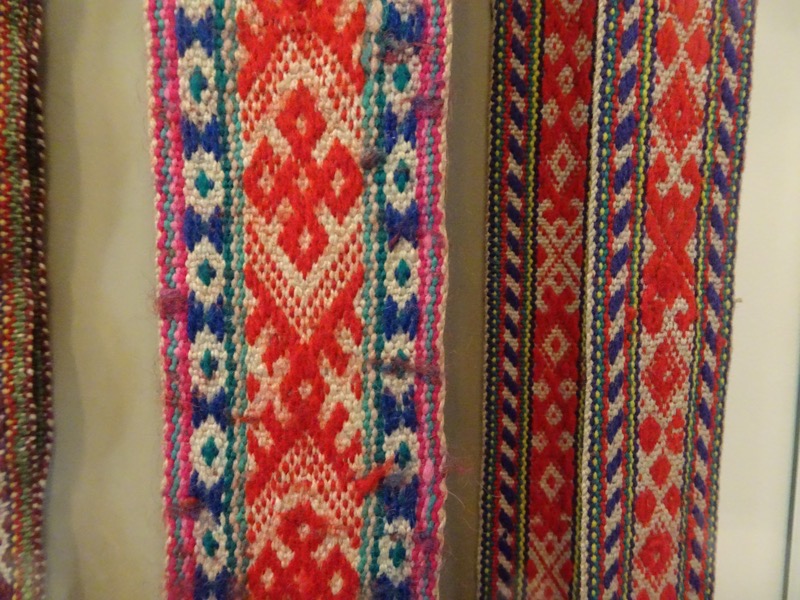
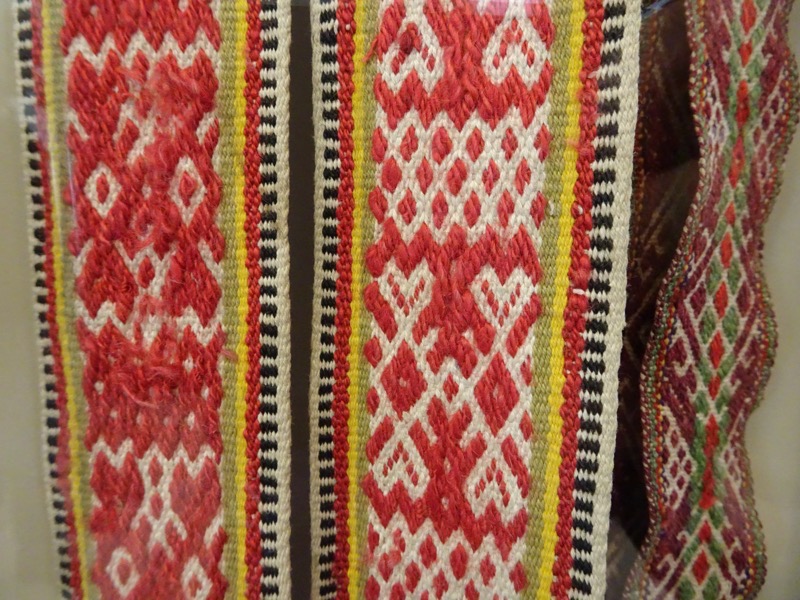
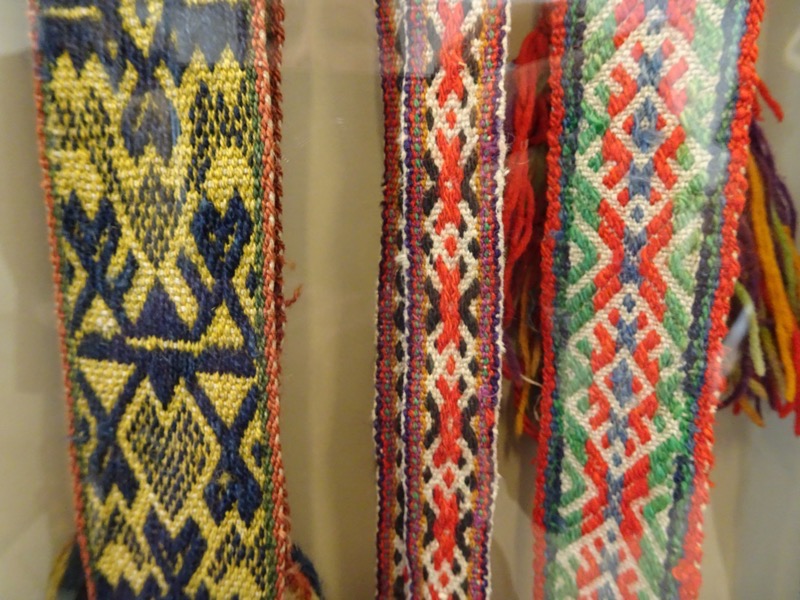
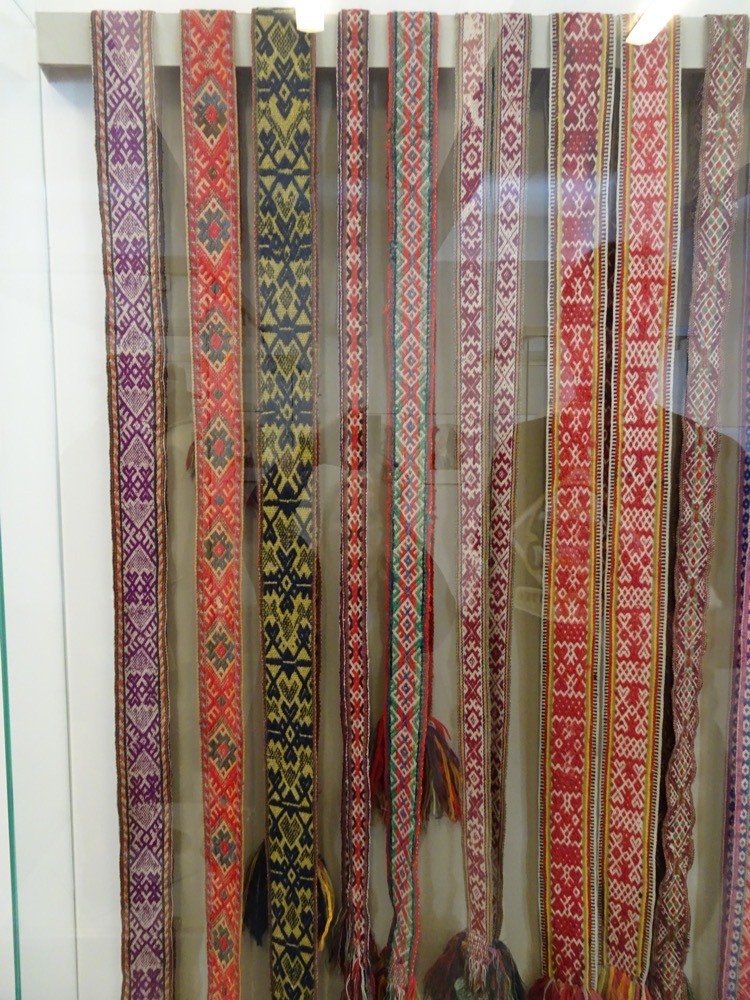 Dowry chest, middle Lithuania, late 19th century.
Dowry chest, middle Lithuania, late 19th century.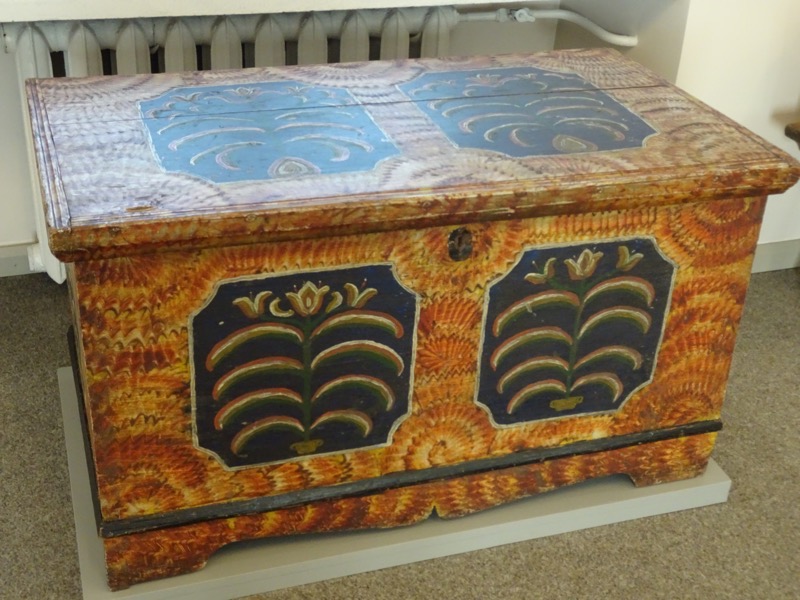 Spinning wheel, middle Lithuania, late 19th century, early 20th century.
Spinning wheel, middle Lithuania, late 19th century, early 20th century.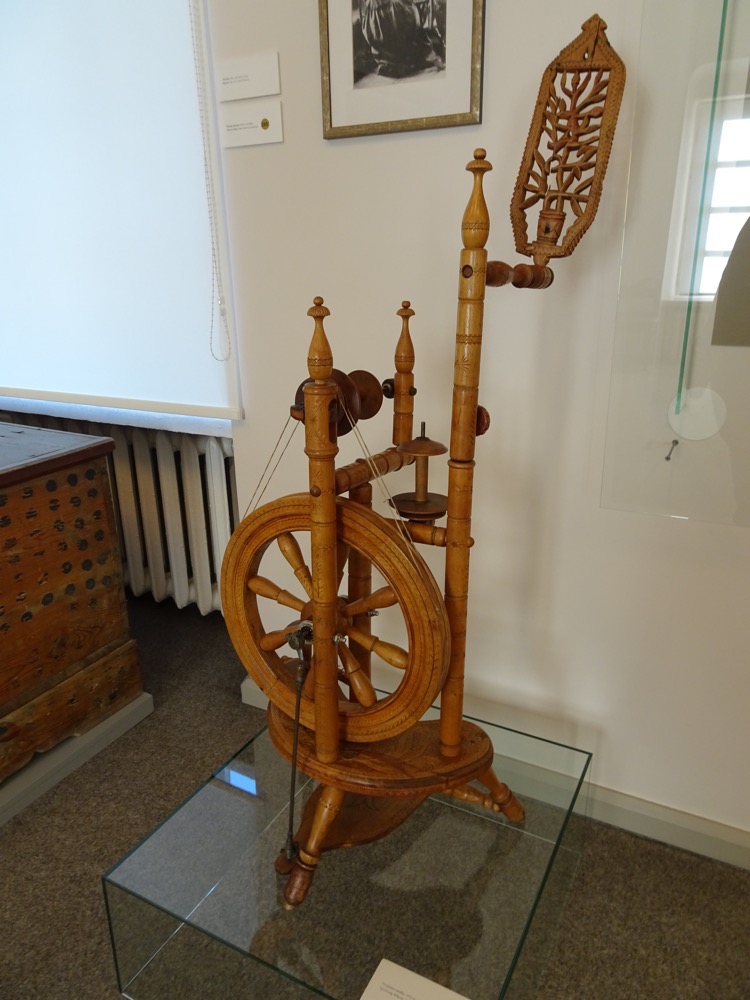 Toy musuem:
Toy musuem: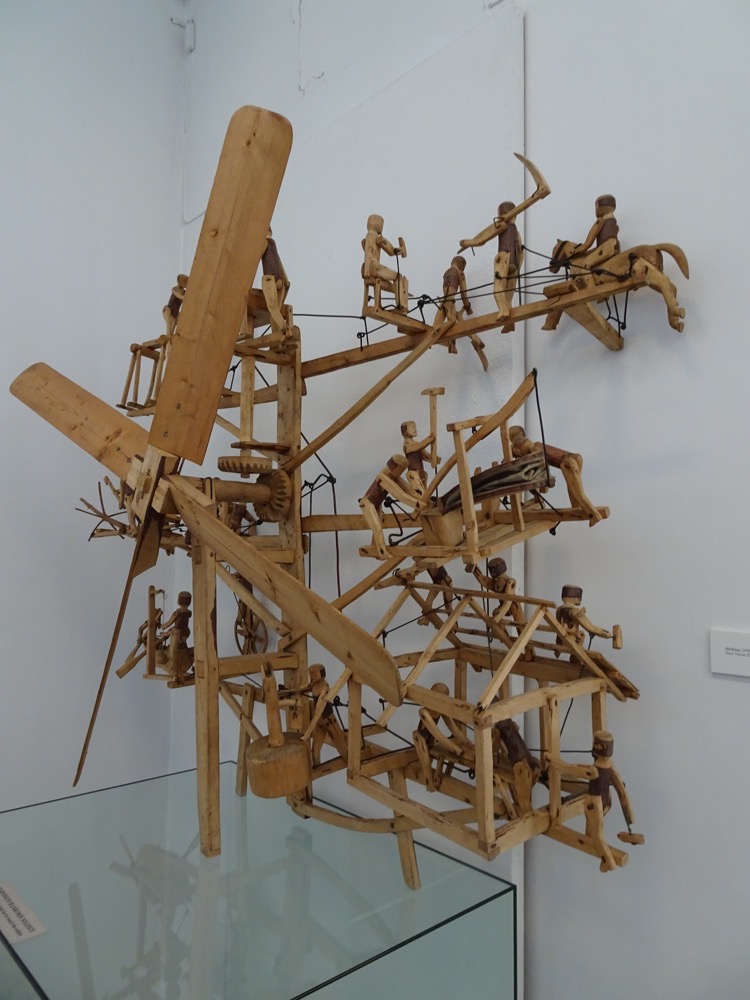
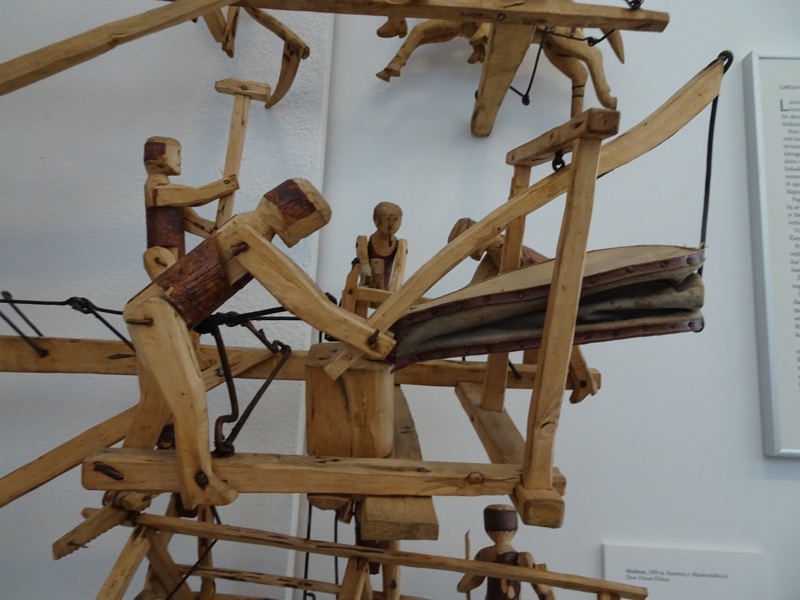
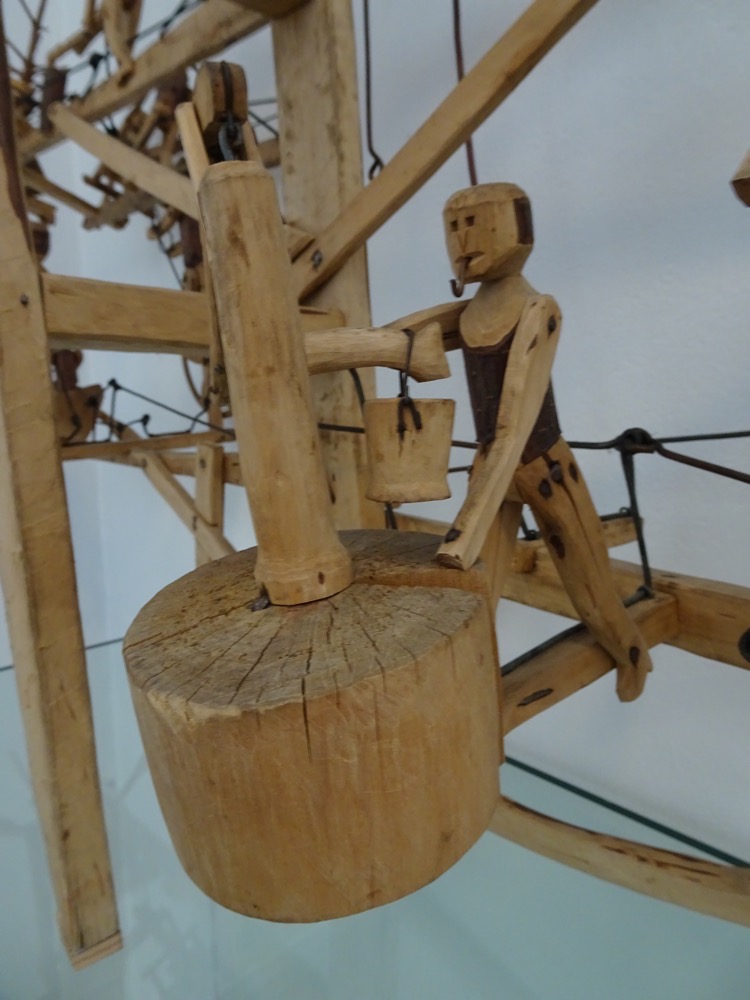
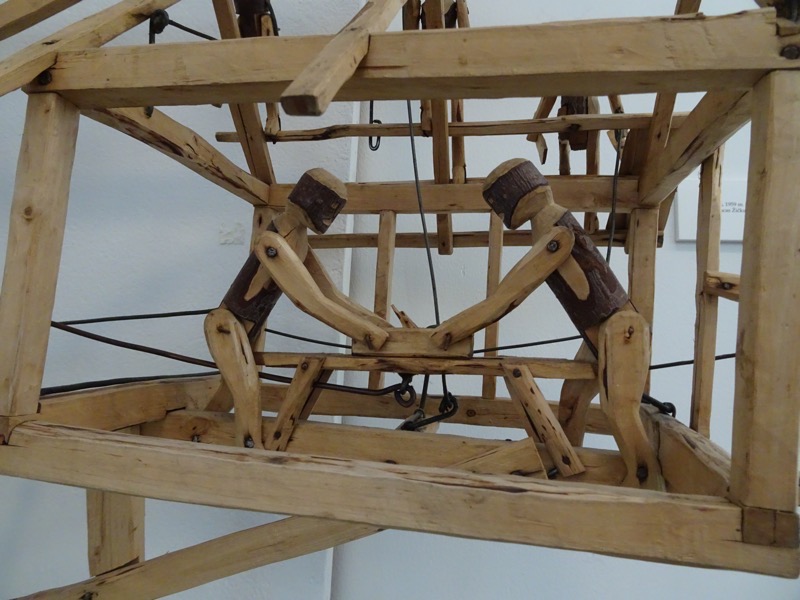
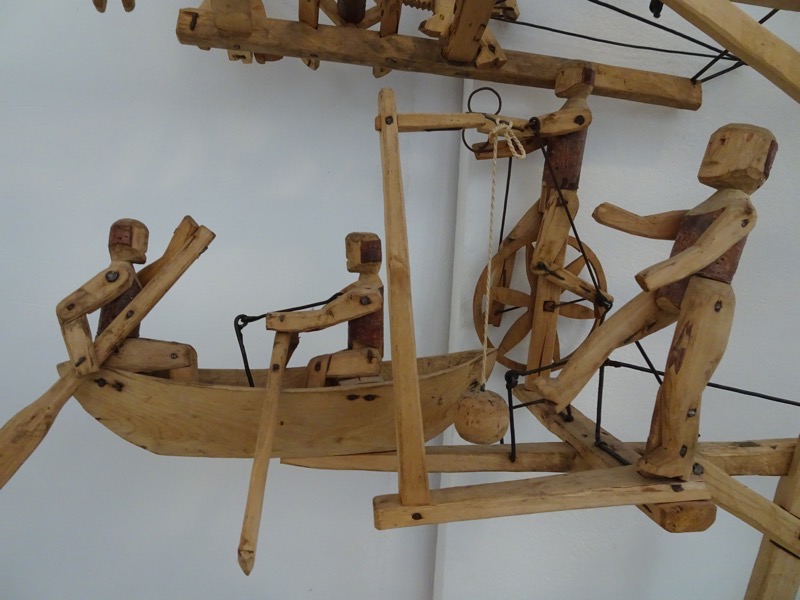 Recreated guest room in a typical Zemaicai house in the early 19th century.
Recreated guest room in a typical Zemaicai house in the early 19th century. 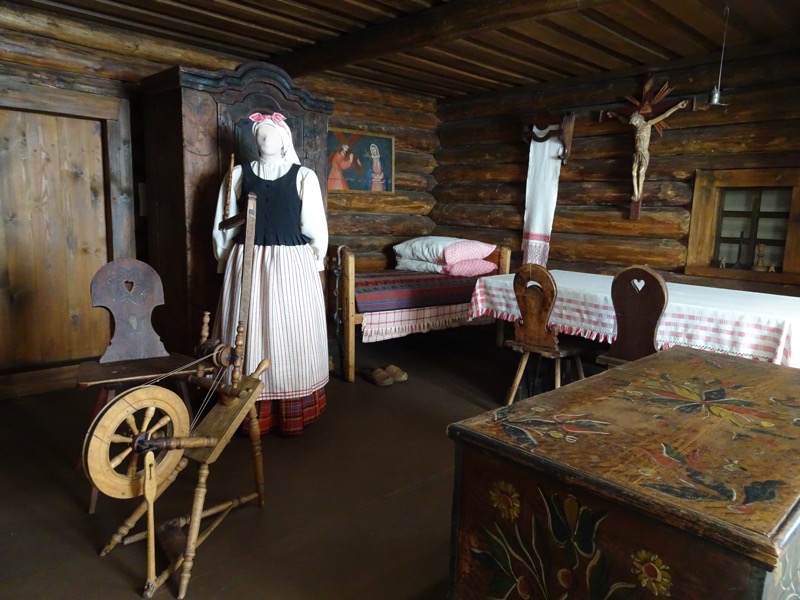 Kitchen/pantry:
Kitchen/pantry: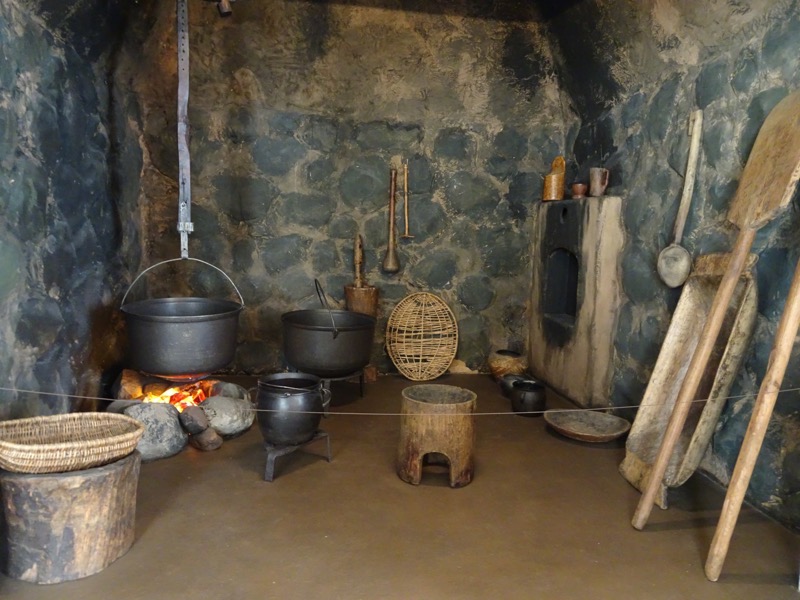
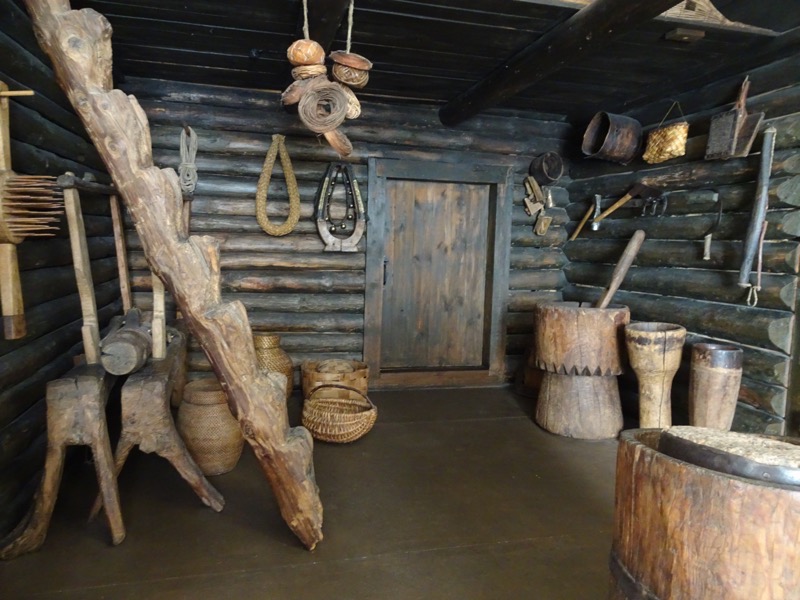 Living/Dining rooms:
Living/Dining rooms: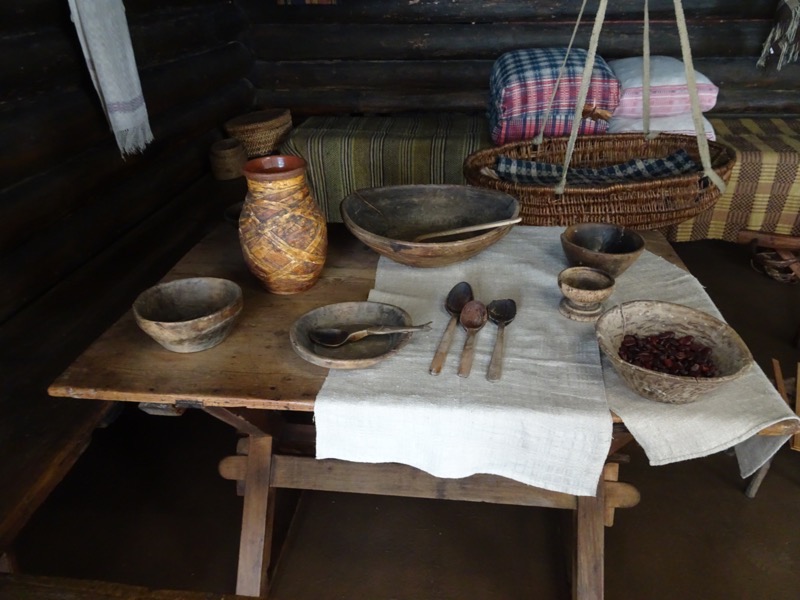 Wooden religious monument tops, various regions, 19th century.
Wooden religious monument tops, various regions, 19th century.
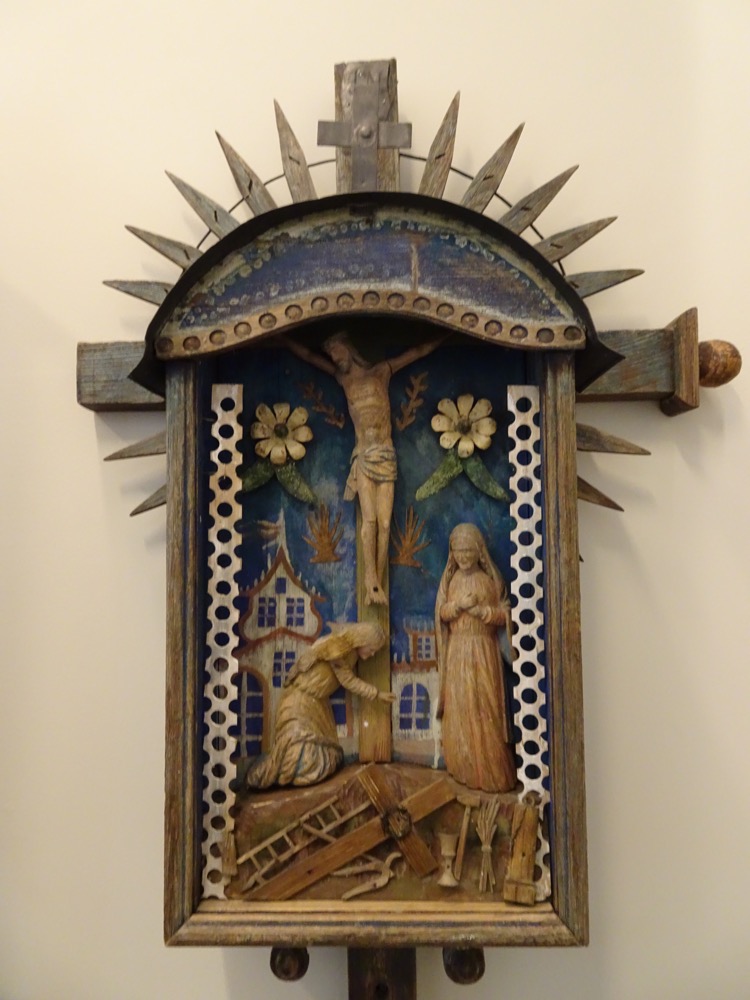
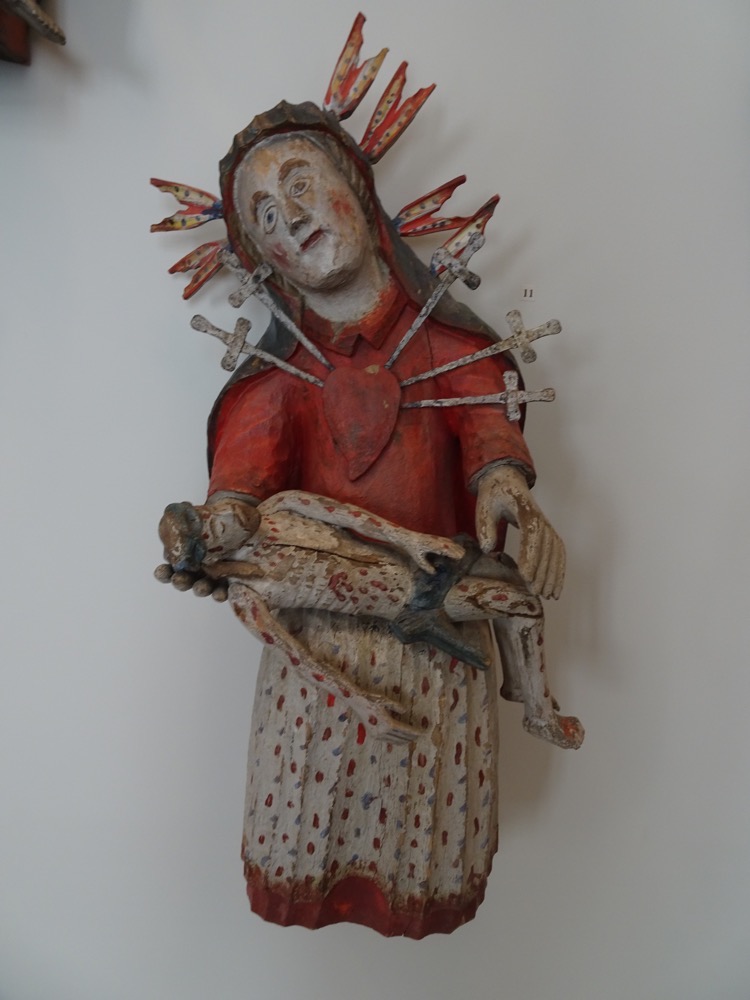
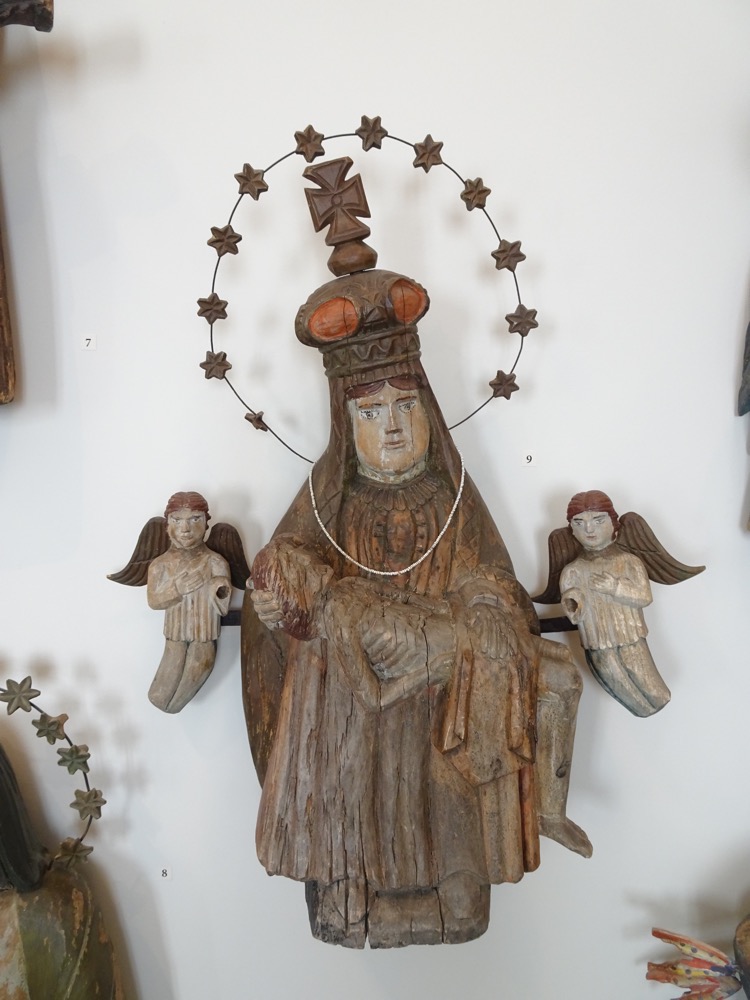 St George…
St George…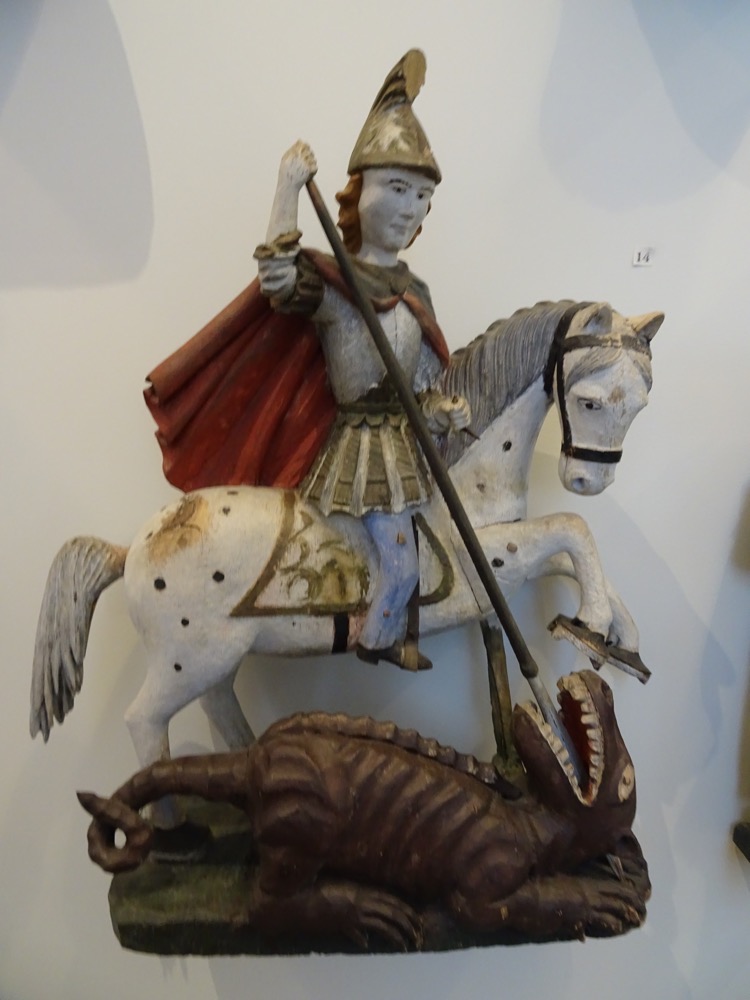 St Florian…
St Florian…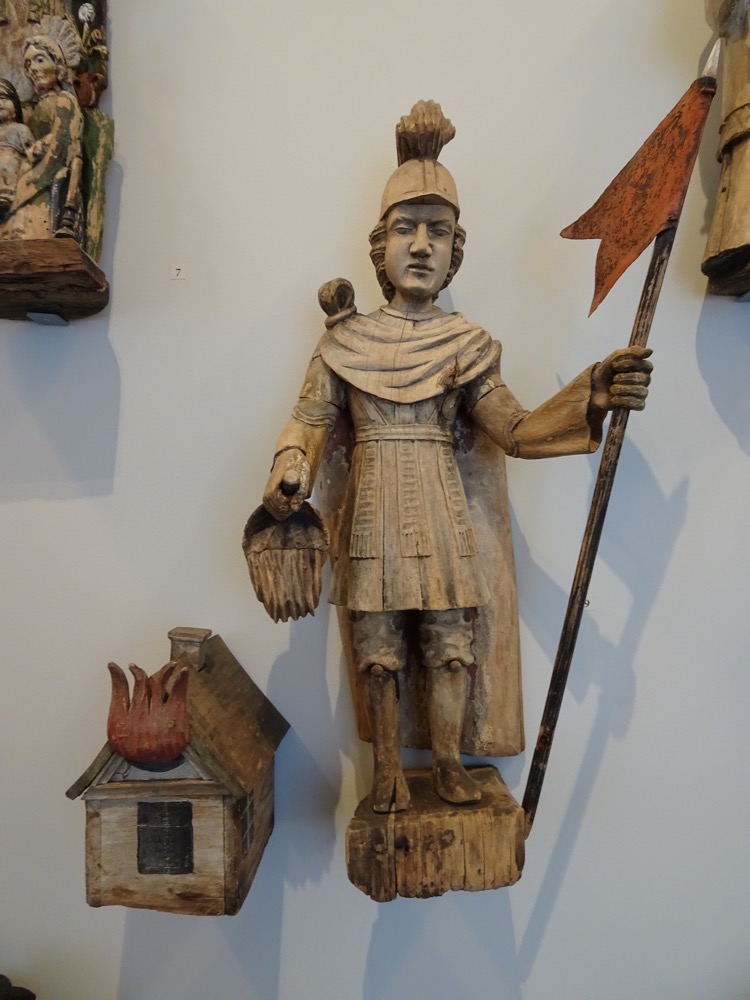
So that must be one of the most haphazard and disorganised museum collections I have ever visited. Objects were arranged seemingly with very little care and no discernible order. It was quite jarring to be regarding an urn from the 5th century BC (with no useful information plaques for context) beside a 15th century statue of a long-dead Grand Duke?! Why? I understand that many of the museum’s collections were decimated and pulled back together during the Soviet era, but it feels like the curators here have gone, ‘Ah, we have some cool old stuff… where can we fit it? There? Cool.’ End of discussion.
After this, we went to the Archeological museum, which as it turns out is much more what one tends to expect from a National History Museum. This museum had a superior collection, thankfully laid out in a cohesive, chronological manner. I am going to do a whole extra post on this museum – I took over 600 photos today and many of them were of the artefacts in this museum – mostly daily objects and dress accessories from the Dark Ages 4th – 13th centuries from various tribes in the Baltic region.
Highlights included more symmetrical bead arrangements from grave finds (huzzah!), some great recreated outfits, double chain chest ornaments, horn decorations, period chisels, and aprons adorned with plaques.
After the archaeological museum, we made our way around the corner to the Gediminas’ Tower, which is all that remains of the Upper Castle in Vilnius. Gediminas, the aforementioned Grand Duke of Lithuania built the first wooden fortifications on this steep hilltop. The first brick castle was built on the same site in 1409. The three-floor tower has been rebuilt in 1933 and only some remnants of the original brick tower remain.
I had been looking up at it all morning debating whether my back was going to let me walk up the steep cobbled climb up until we came around from the archaeological museum and I saw – much to my delight – a sign bearing one of my favourite words while travelling: FUNICULAR! Woo-hoo!
So yay! It is possible to climb to the top of the hill on foot or by taking the funicular.. however we walked a little further to the entrance to the castle tower complex only to find a second sign that said: “Funicular out of operation. Sorry for the inconvenience.” Boo-fucking-hoo. *sad face* Had to make our way up by the extremely precarious, steep and unforgiving cobbled pathway after all.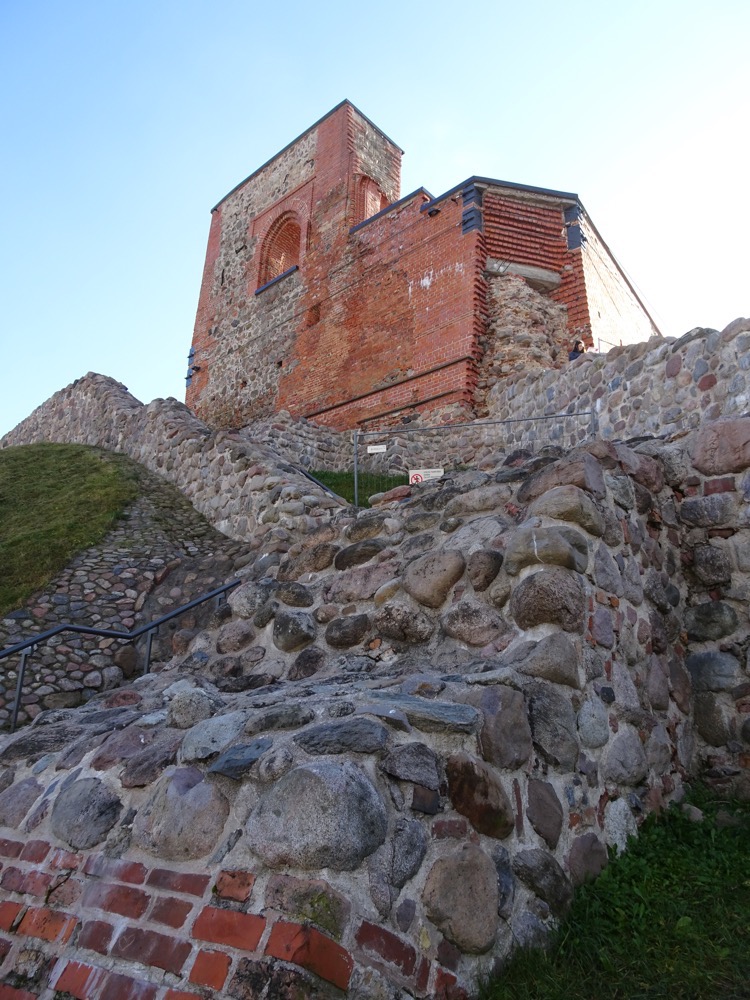 It’s a seriously shitty climb.
It’s a seriously shitty climb.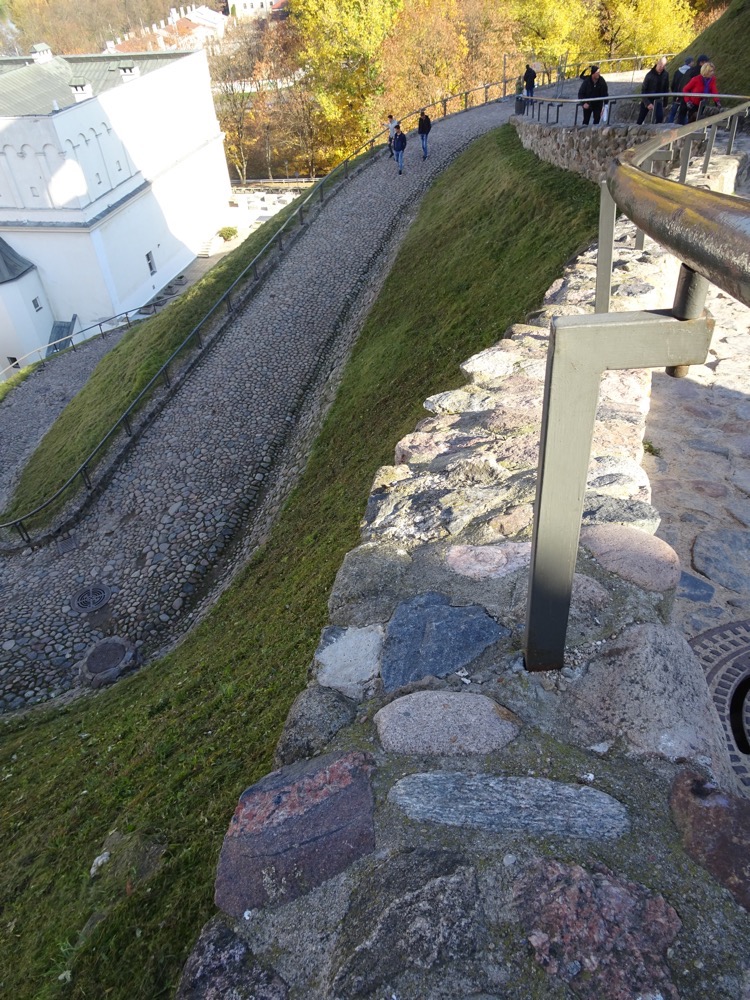 Almost to the top:
Almost to the top: The tower normally houses a museum exhibiting archaeological findings from the hill and the surrounding areas and has models of Vilnius castles from the 14th to the 17th centuries, and some armaments, and other iconographic material of Old Vilnius – normally. However, on this occasion, most of the complex is closed for restoration due to what seems to be a rather nasty landslide and part of the castle starting to look like it’s going to slide down into a river?
The tower normally houses a museum exhibiting archaeological findings from the hill and the surrounding areas and has models of Vilnius castles from the 14th to the 17th centuries, and some armaments, and other iconographic material of Old Vilnius – normally. However, on this occasion, most of the complex is closed for restoration due to what seems to be a rather nasty landslide and part of the castle starting to look like it’s going to slide down into a river?
The views from the base of the castle were still amazing… mind you I got right dirty when I was standing on the top of the funicular platform and saw a civilian dressed museum employee come up in the (obviously functioning) funicular! Ha? Wha? No… 🙁 Damn thing does work, just not in operation for tourists at the moment for some reason.
Over the archeological museum to the city: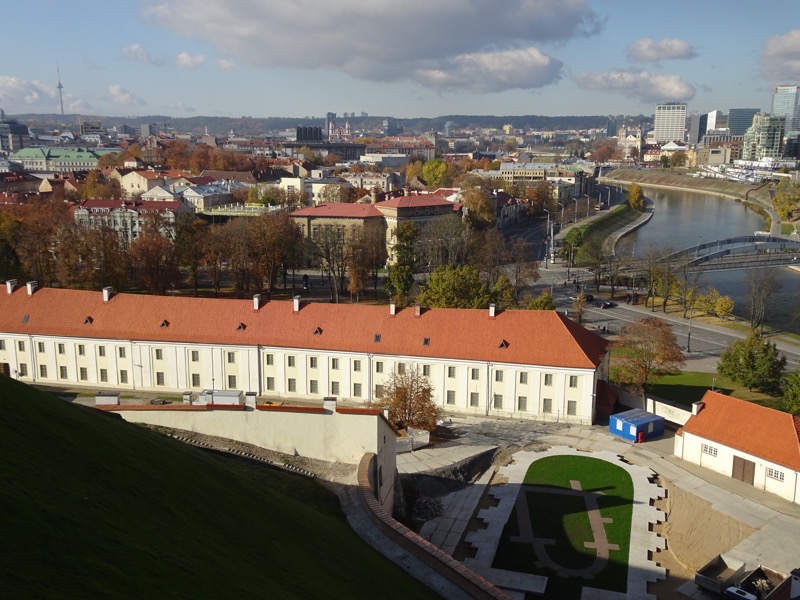 Towards the university grounds:
Towards the university grounds: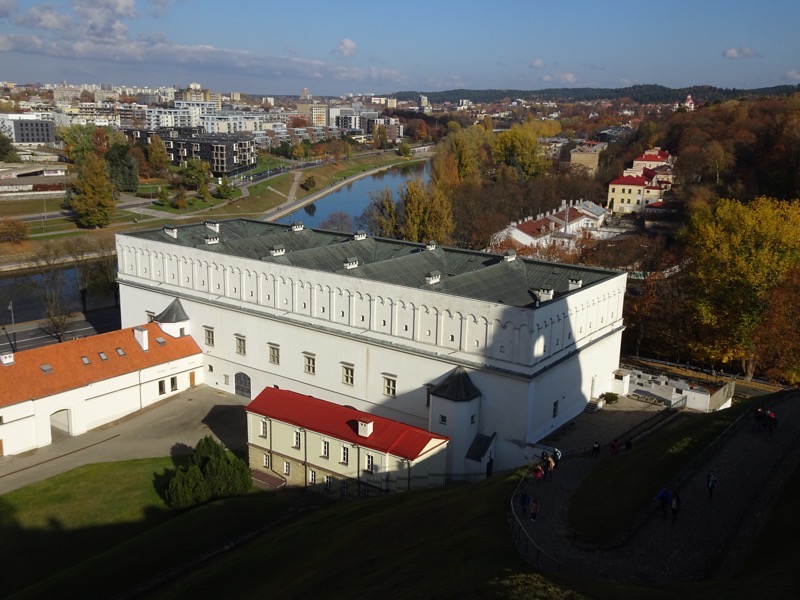 Gediminas’ Tower:
Gediminas’ Tower: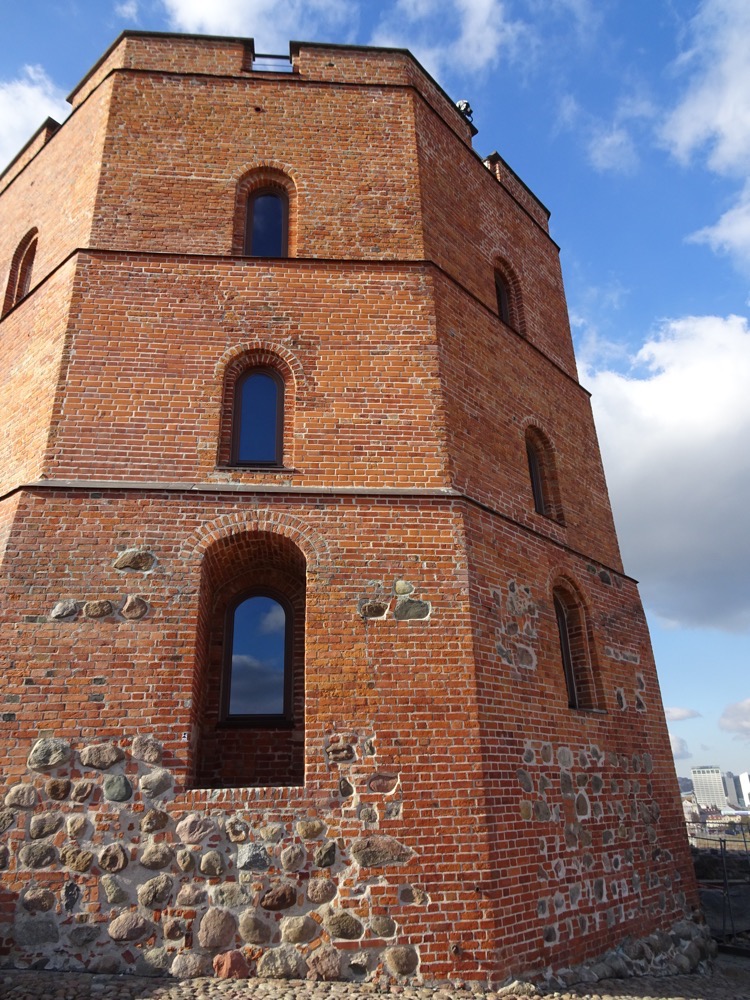 After we made our way through the castle complex, most of which was behind scaffolding, we clambered carefully back down the cobbled hill – because of course if you are going to go tits up, it will be while going downhill and went for a walk around the bottom of the castle tower base. I simply can not get over these gorgeous autumn colours.
After we made our way through the castle complex, most of which was behind scaffolding, we clambered carefully back down the cobbled hill – because of course if you are going to go tits up, it will be while going downhill and went for a walk around the bottom of the castle tower base. I simply can not get over these gorgeous autumn colours. 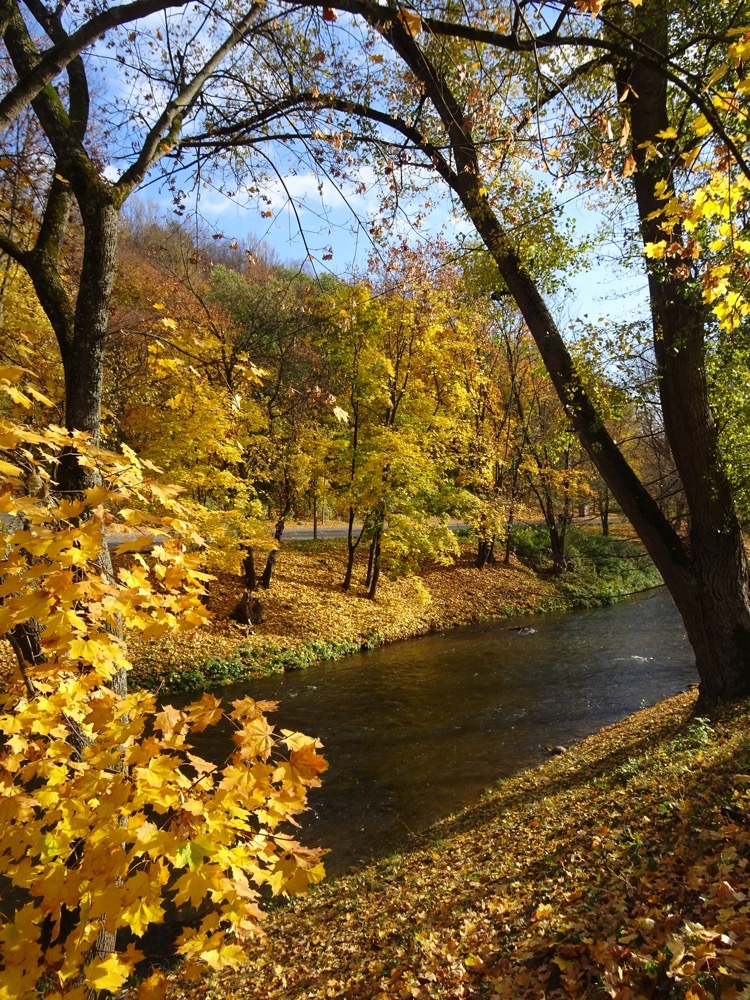
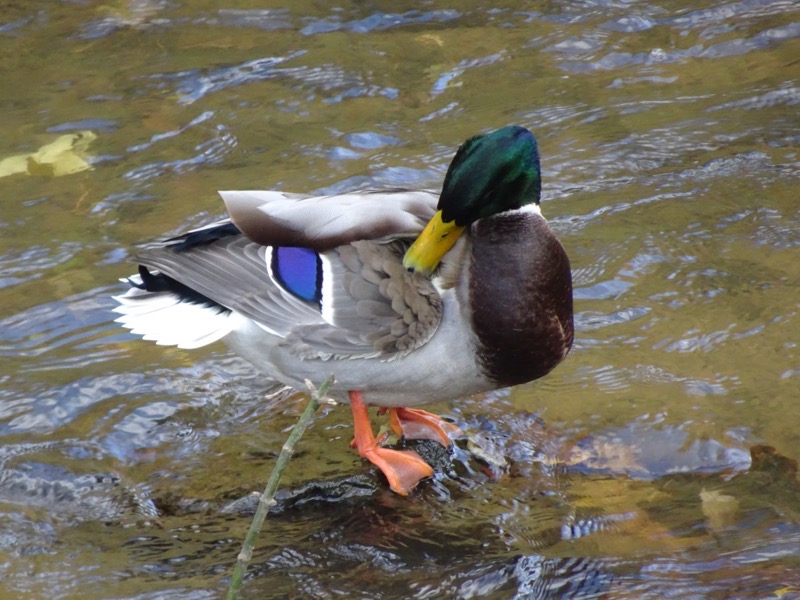
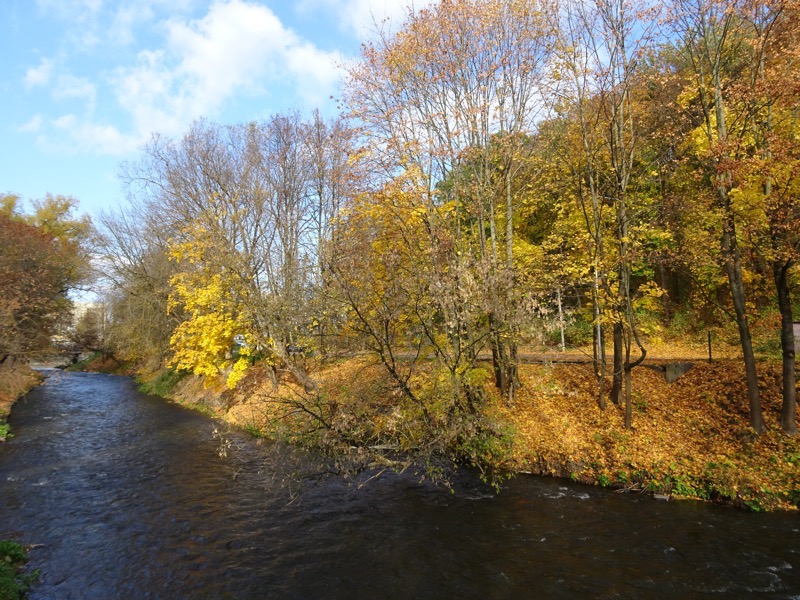 The tower from Cathedral Square:
The tower from Cathedral Square: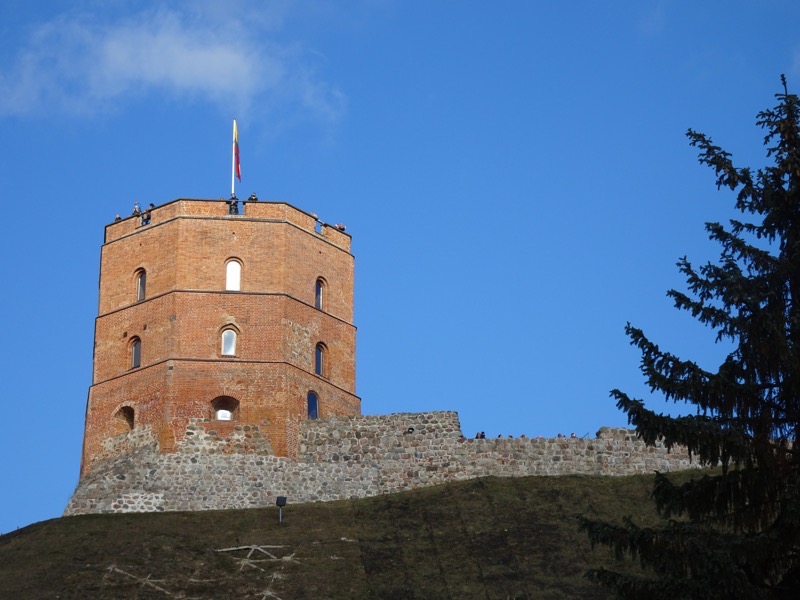 Presidential Palace: This building is the central part of the former Governor’s Palace. The first palace was built here in the 15th century and used as the Vilnius bishops’ residence until 1795 when it was given to the governor-general. It currently holds the President’s official offices.
Presidential Palace: This building is the central part of the former Governor’s Palace. The first palace was built here in the 15th century and used as the Vilnius bishops’ residence until 1795 when it was given to the governor-general. It currently holds the President’s official offices.
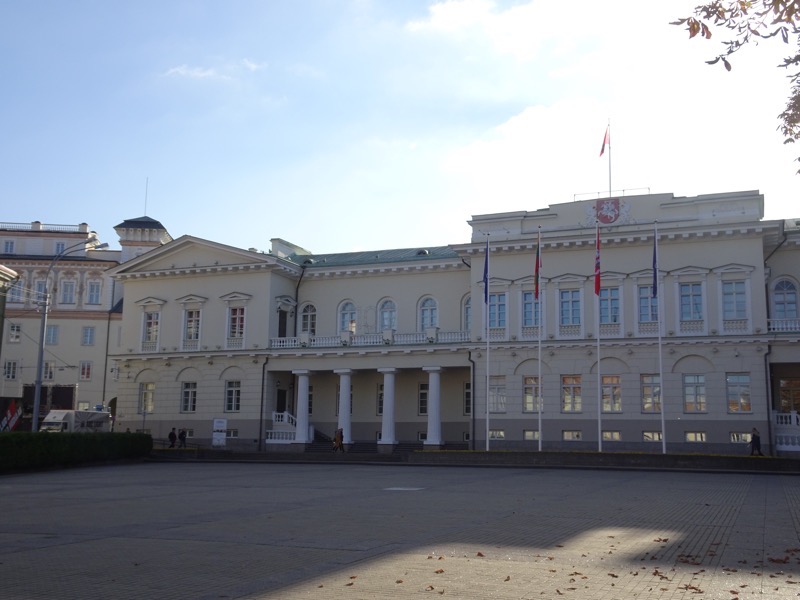 After this, we went hunting for a bit of lunch at a place called Būsi Trečias. Something local, affordable and hopefully not too far. Trip Advisor can be great for finding restaurants and it served us well last night, but sometimes it can be a bit hit and miss. We found a restaurant called and immediately ordered some disgustingly large ciders – because the alcohol is always cheaper than the soft drink or sometimes even the bottled water!
After this, we went hunting for a bit of lunch at a place called Būsi Trečias. Something local, affordable and hopefully not too far. Trip Advisor can be great for finding restaurants and it served us well last night, but sometimes it can be a bit hit and miss. We found a restaurant called and immediately ordered some disgustingly large ciders – because the alcohol is always cheaper than the soft drink or sometimes even the bottled water!
The Būsi Trečias restaurant was okay, (thanks Trip Advisor), but we have discovered that service in Vilnius is a bit dodgy – menus slapped down without any greeting, wait forever for table service and the food will come out willy-nilly… an appetiser will turn up with someone’s main, then someone else’s entree will turn up when the other main meal does. Whatever, it’s all good, nothing to stress about – at least they don’t have a tipping culture to go with their bad service.
Today I suffered from what I tend to call, ‘Panic Ordering’. I asked what the soup of the day was because I wasn’t very hungry and thought something light like a soup would be fine… only when she said it was cold beetroot soup I was less than thrilled as we have had a startling amount of beets lately, and stupidly, I didn’t have a back up plan. With the waitress hovering impatiently, I panic ordered the only other thing on the menu that I recognised, which was a pork hock… so much for a light lunch!
 yale ordered what was called a ‘Village Pan’ and was full of potato, bacon and mushrooms, gherkins and god knows what else. It was okay in the end, yale more than happily assisted in polishing off the pork hock (well the chunks of it that weren’t fat and bone that is).
yale ordered what was called a ‘Village Pan’ and was full of potato, bacon and mushrooms, gherkins and god knows what else. It was okay in the end, yale more than happily assisted in polishing off the pork hock (well the chunks of it that weren’t fat and bone that is). After lunch, we went for a quick wander down the main street of the Old Town to see what the other tourists are doing today. It was fairly quiet – I think that is the benefit of being here off-peak. Not many monument hogging selfie obsessed tourists around these parts.
After lunch, we went for a quick wander down the main street of the Old Town to see what the other tourists are doing today. It was fairly quiet – I think that is the benefit of being here off-peak. Not many monument hogging selfie obsessed tourists around these parts.
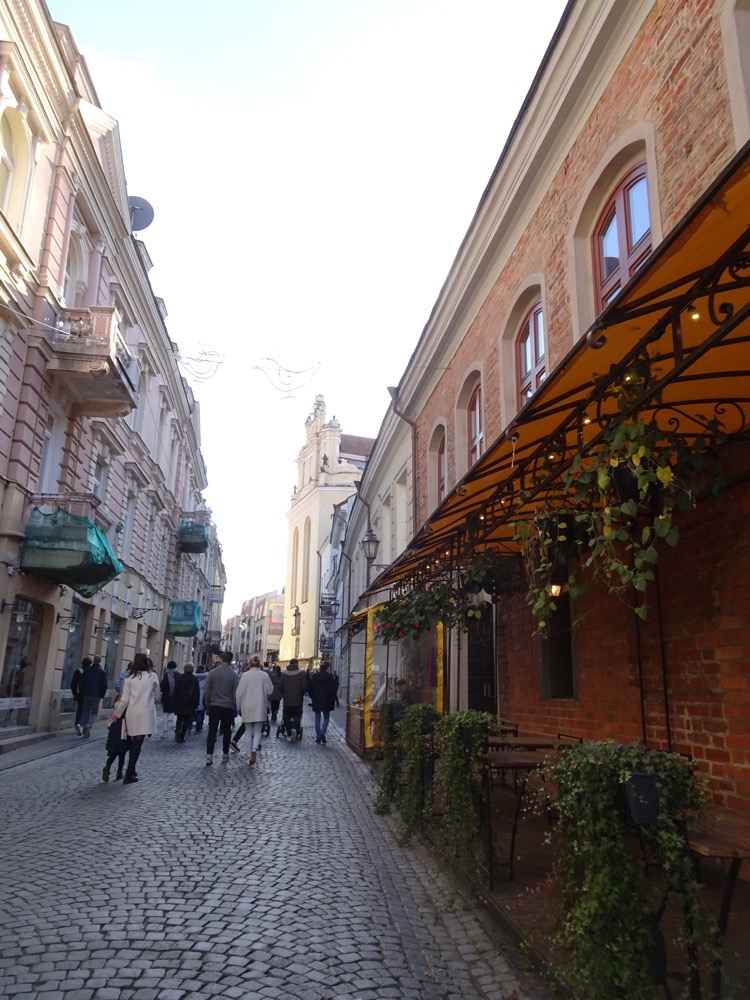 Souvenir shops are the same the world over aren’t they? Full of stuff no one needs and hardly anyone wants. I collected my pins and we moved one.
Souvenir shops are the same the world over aren’t they? Full of stuff no one needs and hardly anyone wants. I collected my pins and we moved one.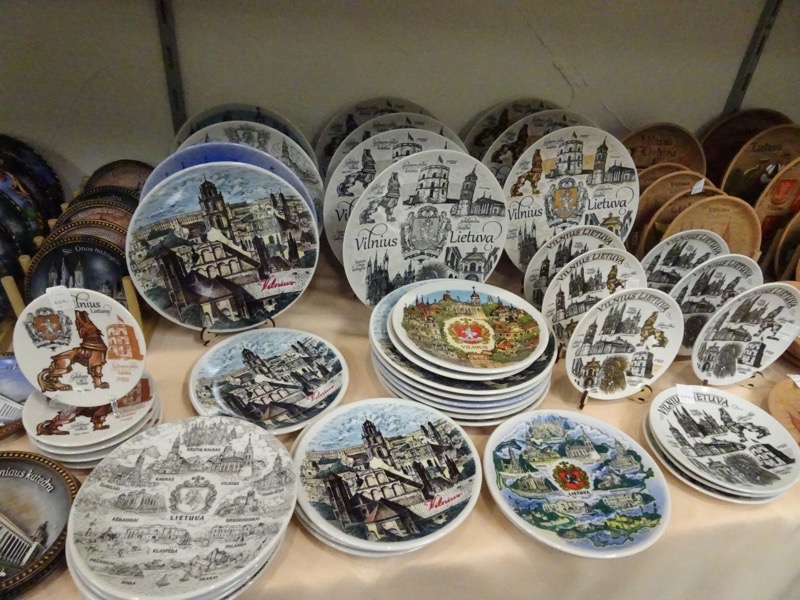
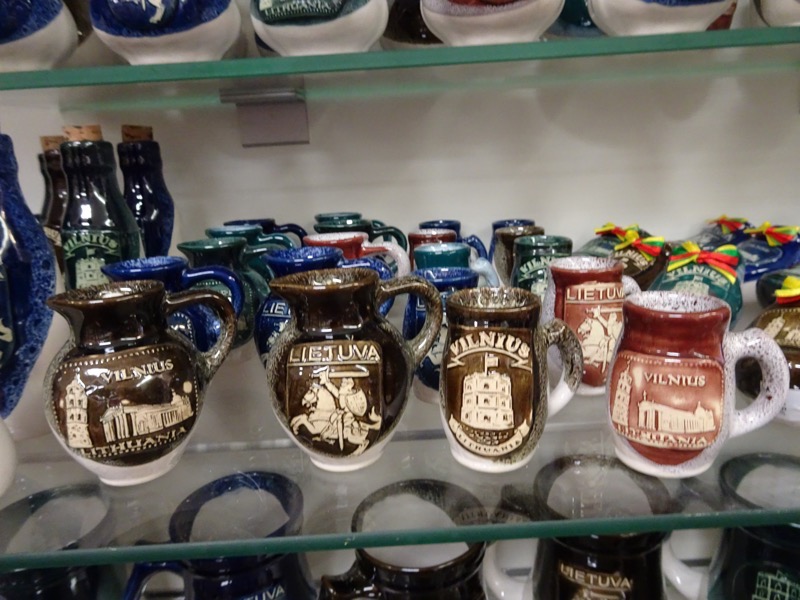
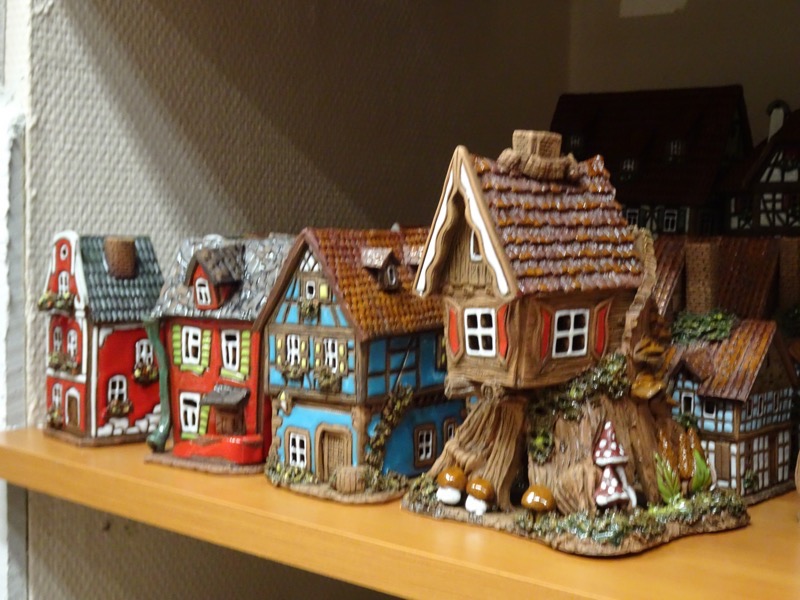 I was trying to take a photo of this amazing building, and couldn’t find a good vantage point to capture the brickwork. It was only after I took about four pictures that I realised he was getting annoyed at me taking his photo (and not dropping coins in his hat I dare say), whereas the truth was, I’m standing there thinking, ‘Why has that guy plonked himself and his ugly purple trolley right in front of the only building in the street that I want to photograph!?’
I was trying to take a photo of this amazing building, and couldn’t find a good vantage point to capture the brickwork. It was only after I took about four pictures that I realised he was getting annoyed at me taking his photo (and not dropping coins in his hat I dare say), whereas the truth was, I’m standing there thinking, ‘Why has that guy plonked himself and his ugly purple trolley right in front of the only building in the street that I want to photograph!?’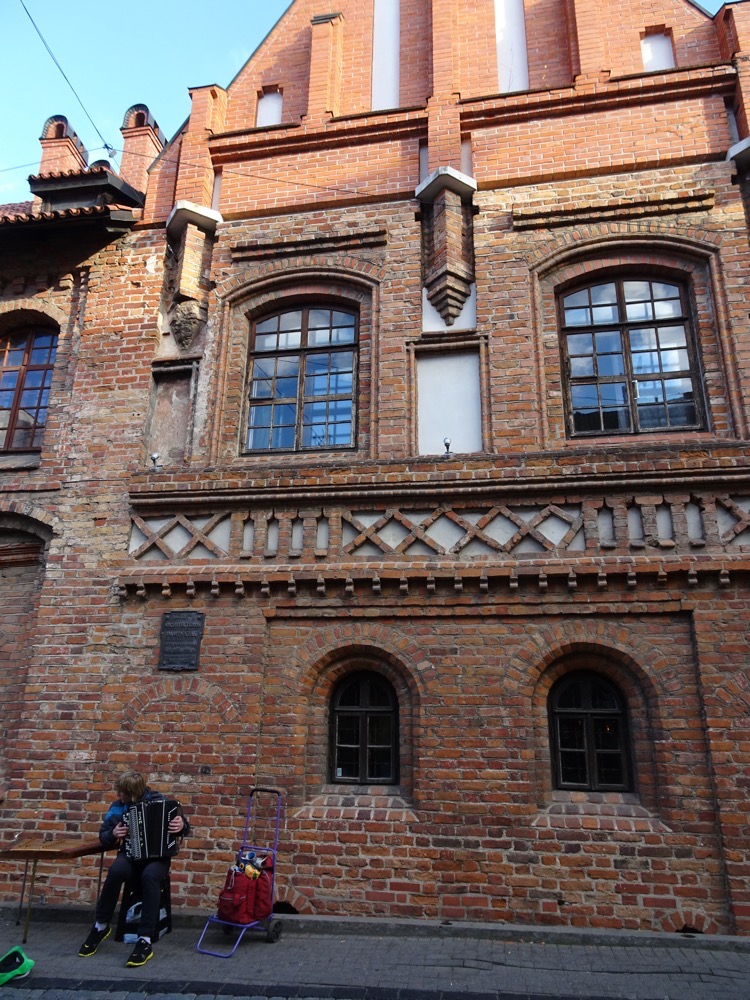 Wine bar on the corner near our B&B.
Wine bar on the corner near our B&B.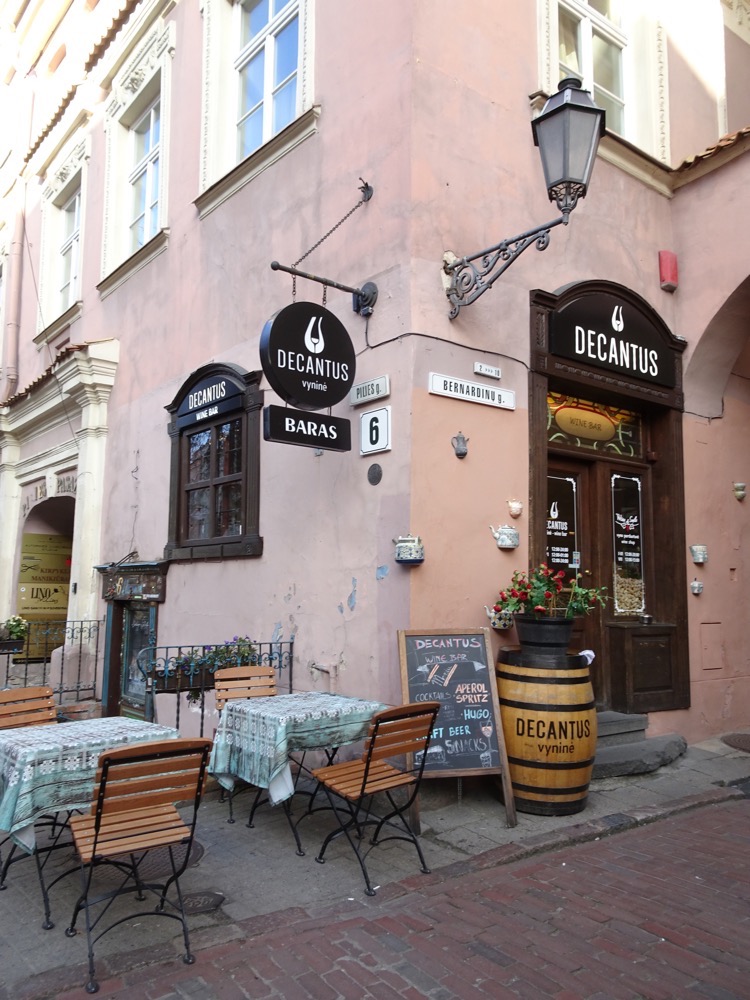
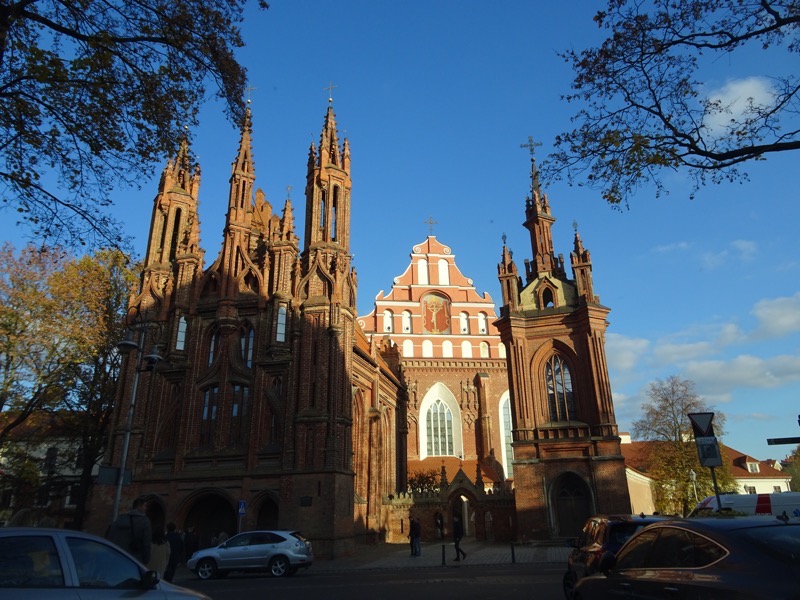 We had decided to spend the last few hours of the day going for a drive out to the Trakai ‘medieval castle’. Was surprised to see hot air balloons up at 3pm in the afternoon – at home, it seems to be an early dawn activity.
We had decided to spend the last few hours of the day going for a drive out to the Trakai ‘medieval castle’. Was surprised to see hot air balloons up at 3pm in the afternoon – at home, it seems to be an early dawn activity.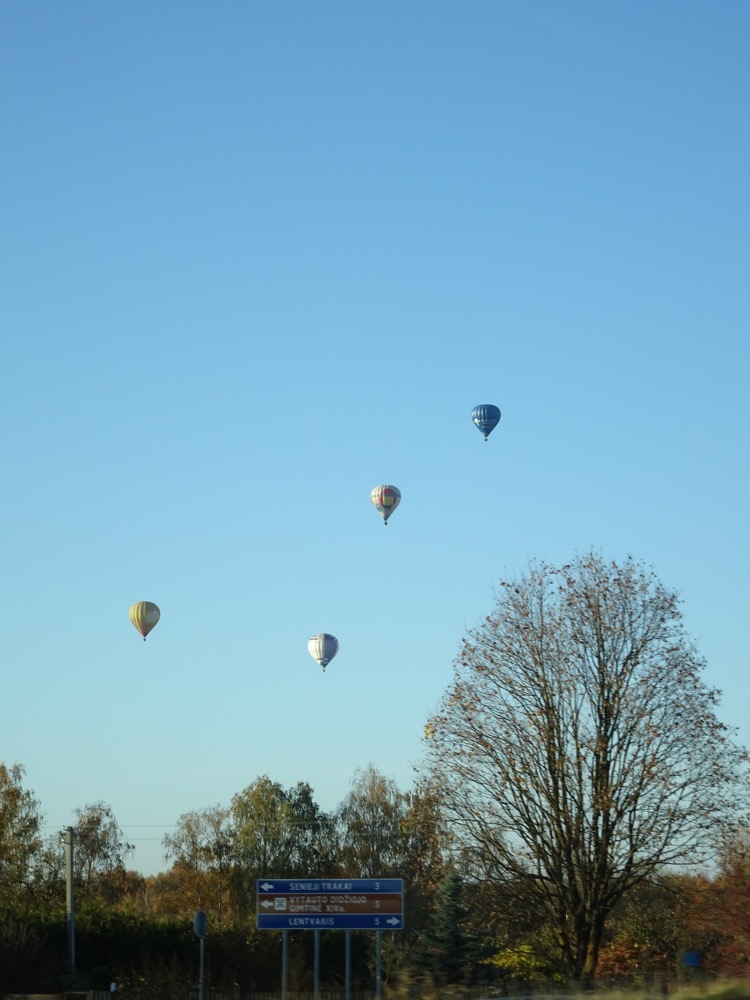 Trakai is a very touristy village near the castle, that seems to have sprung up to serve the tourists that come to visit the place. Full of bright coloured buildings, cafes and gift shops.
Trakai is a very touristy village near the castle, that seems to have sprung up to serve the tourists that come to visit the place. Full of bright coloured buildings, cafes and gift shops.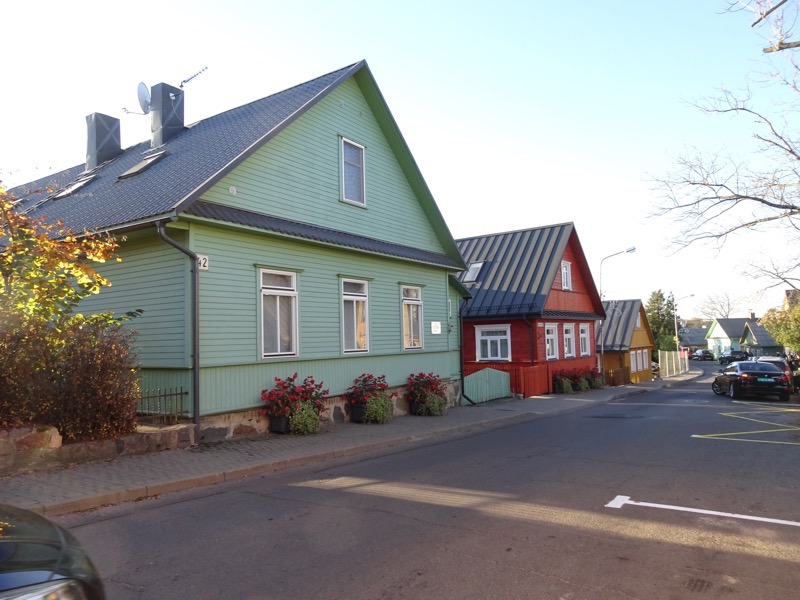
Trakai Island Castle is a castle on an island in Lake Galvė. The original construction of the castle started in the 14th century by Grand Duke Kęstutis (who was assassinated), and by about 1409, major works were completed by his son Vytautas the Great, who died in here in 1430. Trakai was one of the main centres of the Grand Duchy of Lithuania and the castle held a strong strategic importance.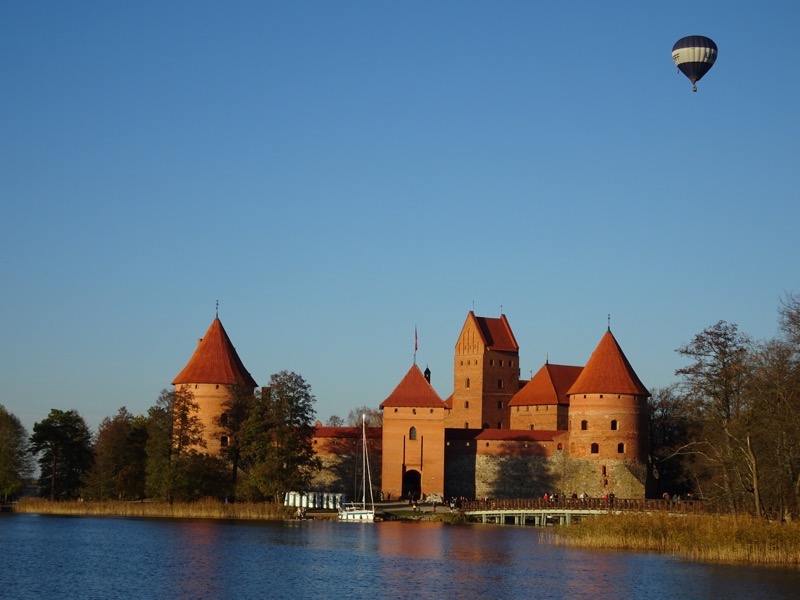
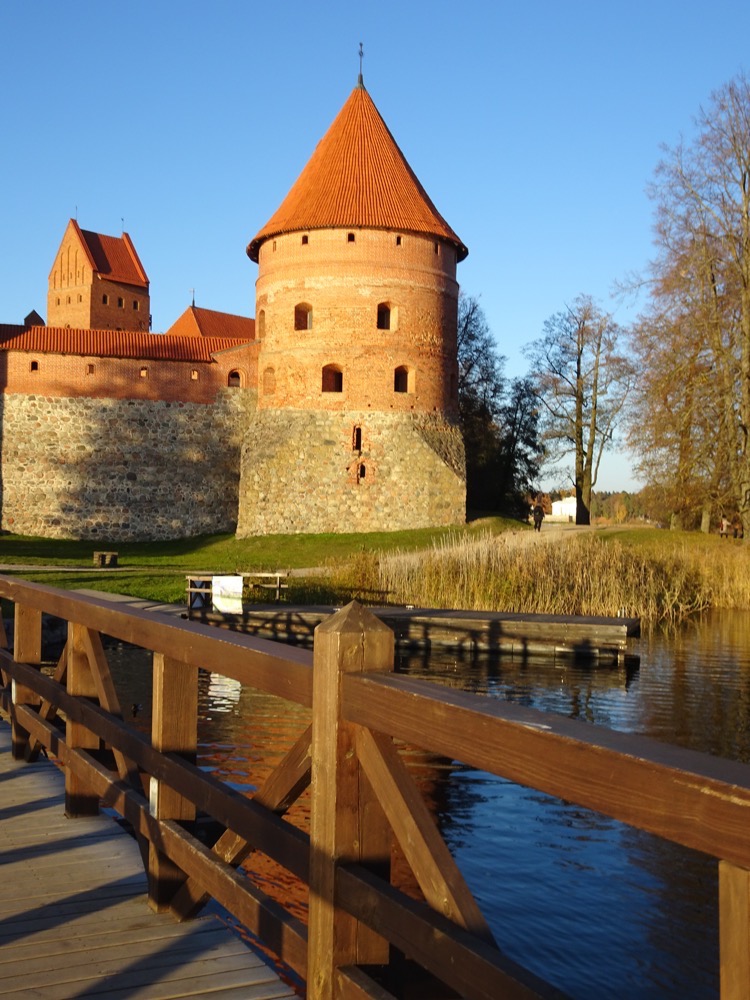 Like so many of the other historic places we have visited this trip, the castle suffered several major catastrophes over the ensuing centuries including – an attack by Teutonic Knights in 1377 and a power struggle between Jogaila and Vytautas the Great for the title of Grand Duke of Lithuania after the assassination of Kęstutis. The castle was besieged by both sides of that spat, but soon after they reconciled and the major phase of construction started and continued until 1409, which was just before the Battle of Grunwald (between the Teutonic Knight and the Polish/Lithuanian Forces), after which the castle lost its relevance as a strategic military fortress.
Like so many of the other historic places we have visited this trip, the castle suffered several major catastrophes over the ensuing centuries including – an attack by Teutonic Knights in 1377 and a power struggle between Jogaila and Vytautas the Great for the title of Grand Duke of Lithuania after the assassination of Kęstutis. The castle was besieged by both sides of that spat, but soon after they reconciled and the major phase of construction started and continued until 1409, which was just before the Battle of Grunwald (between the Teutonic Knight and the Polish/Lithuanian Forces), after which the castle lost its relevance as a strategic military fortress.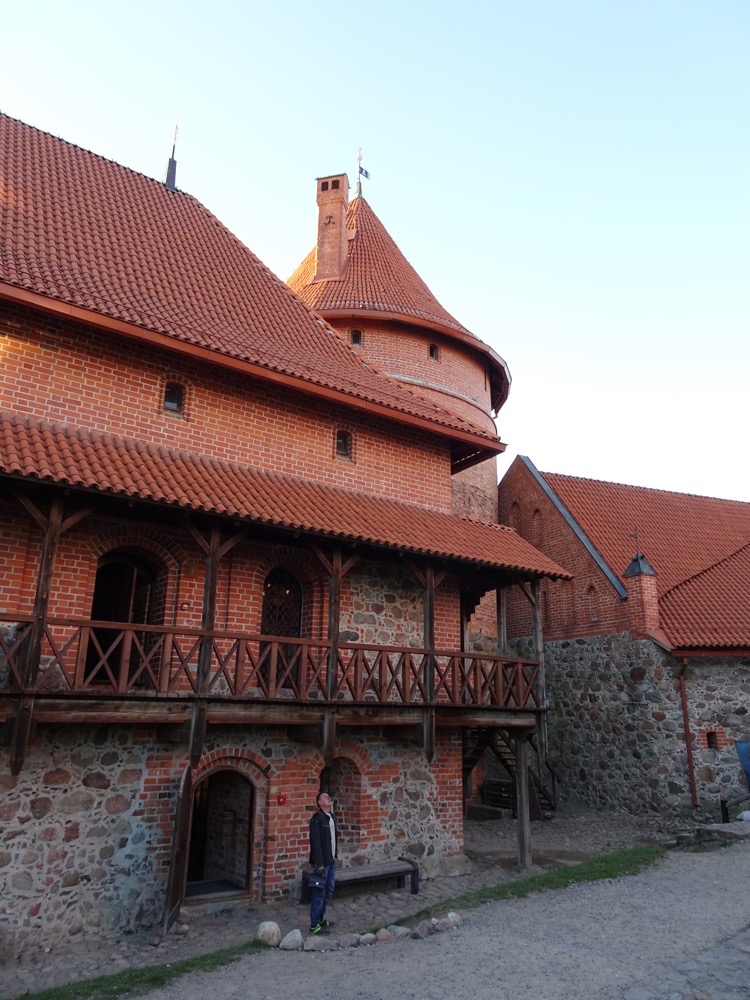 The castle is mainly built out of red Gothic bricks. Stone blocks were used only in the foundations and for some of the upper parts of buildings, towers and walls. It has been decorated with glazed roof tiles, burned bricks, and (some very dodgy) stained glass windows. Its overall style after the second construction phase could be described as Gothic with some Romanesque features.
The castle is mainly built out of red Gothic bricks. Stone blocks were used only in the foundations and for some of the upper parts of buildings, towers and walls. It has been decorated with glazed roof tiles, burned bricks, and (some very dodgy) stained glass windows. Its overall style after the second construction phase could be described as Gothic with some Romanesque features.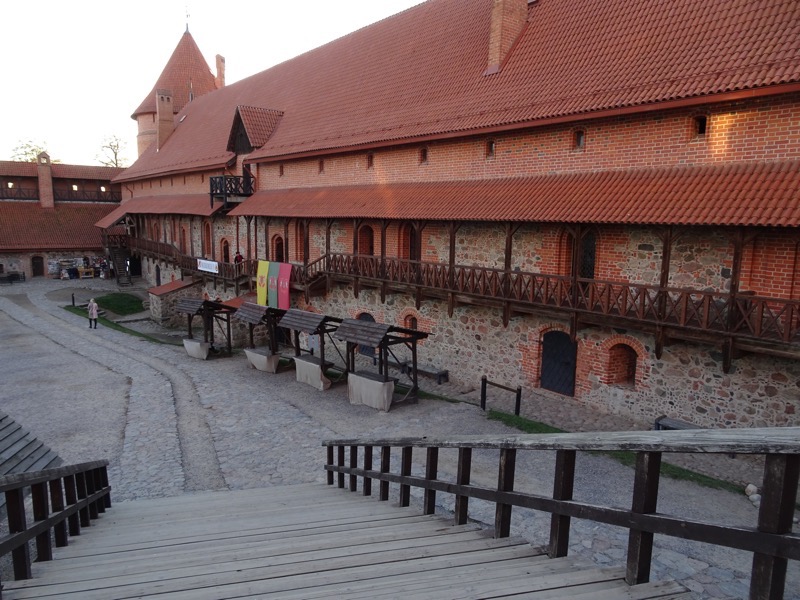 After the Battle of Grunwald, the castle was no longer of any military importance, so it was turned into a residence for the Grand Dukes of Lithuania. The caste was redecorated, frescos were added and foreign emissaries were welcomed in the Ducal Palace.
After the Battle of Grunwald, the castle was no longer of any military importance, so it was turned into a residence for the Grand Dukes of Lithuania. The caste was redecorated, frescos were added and foreign emissaries were welcomed in the Ducal Palace.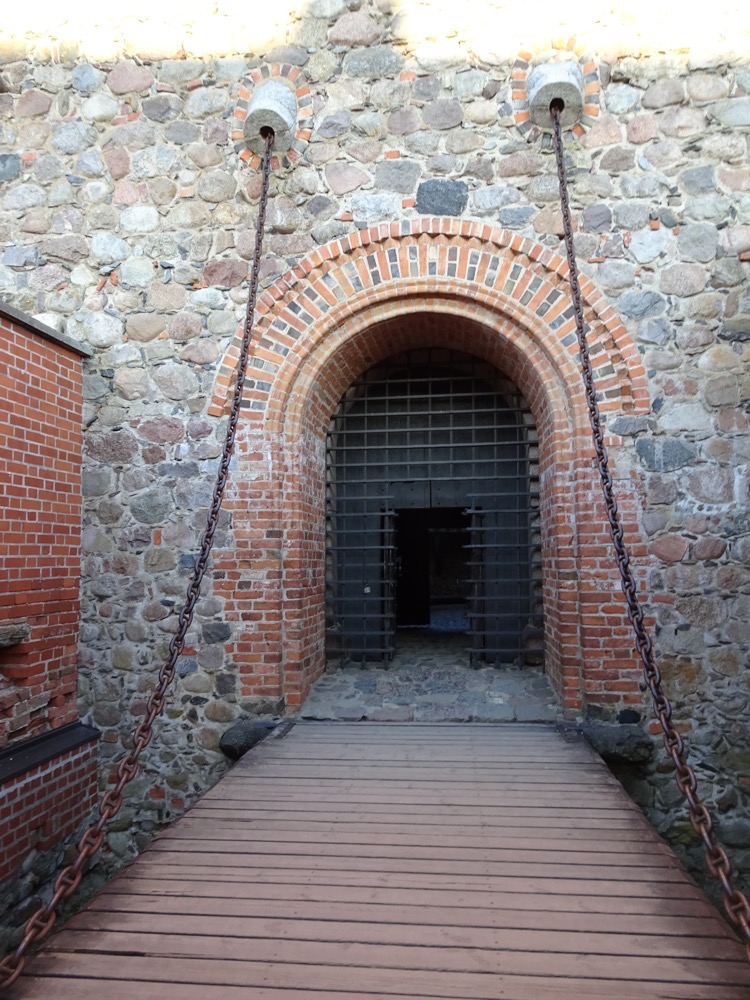 Grand Duke Vytautas the Great died in the castle in 1430 leaving it in the hands of Sigismund Augustus who used it as a royal summer residence until 1511, and it was redecorated in a Renaissance style. Later the castle served as a prison and during the wars with Muscovy in the 17th century, the castle was damaged, but this time was not reconstructed and it gradually fell into disrepair.
Grand Duke Vytautas the Great died in the castle in 1430 leaving it in the hands of Sigismund Augustus who used it as a royal summer residence until 1511, and it was redecorated in a Renaissance style. Later the castle served as a prison and during the wars with Muscovy in the 17th century, the castle was damaged, but this time was not reconstructed and it gradually fell into disrepair.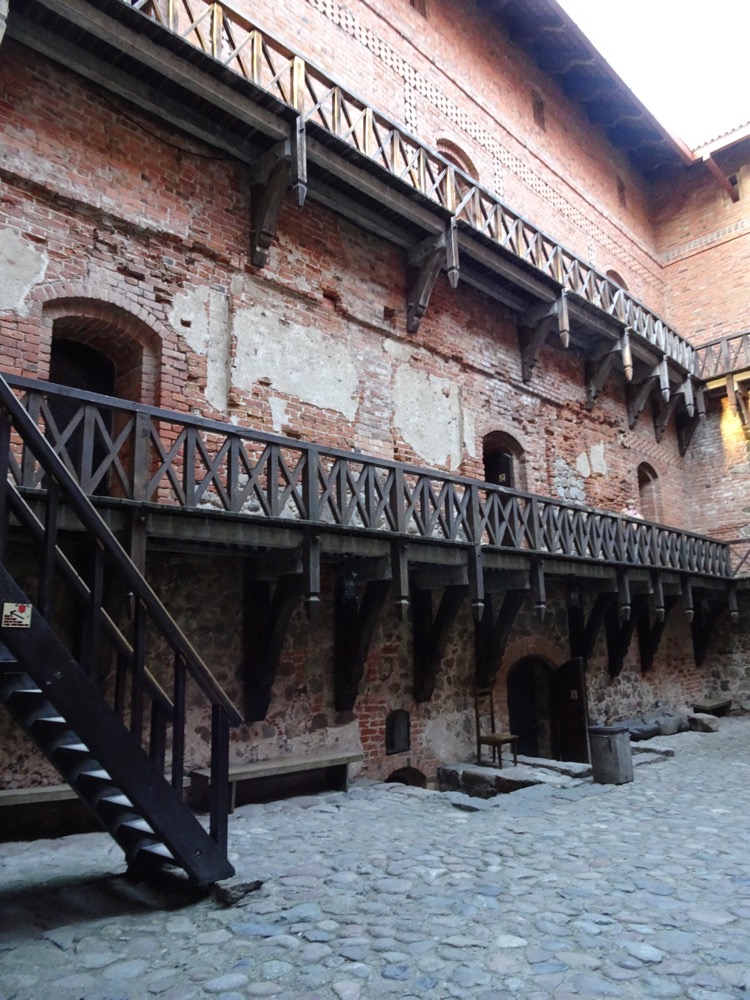 in 1888, the Imperial Archaeological Commission planned were made to rebuild the castle and in 1905, the Imperial Russian authorities decided to partially restore the castle ruins. During World War I, Germans brought in their restoration specialists, who made several attempts to rebuilt the castle and then between 1935-1941, parts of the Ducal Palace walls were rebuilt. Up until WWII, Lithuanian and Polish conservationists worked on castle project, but all work stopped when the war was raging all over Europe. After WWII, a major reconstruction project was begun in 1946 with actual restoration work started in 1951–1952. The major portion of the reconstruction was eventually finished in the 1960s with the goal of reconstructing the castle in a 15th century style to be a major tourist attraction, which has resulted in a cross between Hampton Court Palace and Bli Bli Castle. :/
in 1888, the Imperial Archaeological Commission planned were made to rebuild the castle and in 1905, the Imperial Russian authorities decided to partially restore the castle ruins. During World War I, Germans brought in their restoration specialists, who made several attempts to rebuilt the castle and then between 1935-1941, parts of the Ducal Palace walls were rebuilt. Up until WWII, Lithuanian and Polish conservationists worked on castle project, but all work stopped when the war was raging all over Europe. After WWII, a major reconstruction project was begun in 1946 with actual restoration work started in 1951–1952. The major portion of the reconstruction was eventually finished in the 1960s with the goal of reconstructing the castle in a 15th century style to be a major tourist attraction, which has resulted in a cross between Hampton Court Palace and Bli Bli Castle. :/
There are many artefacts in the castle… some genuine.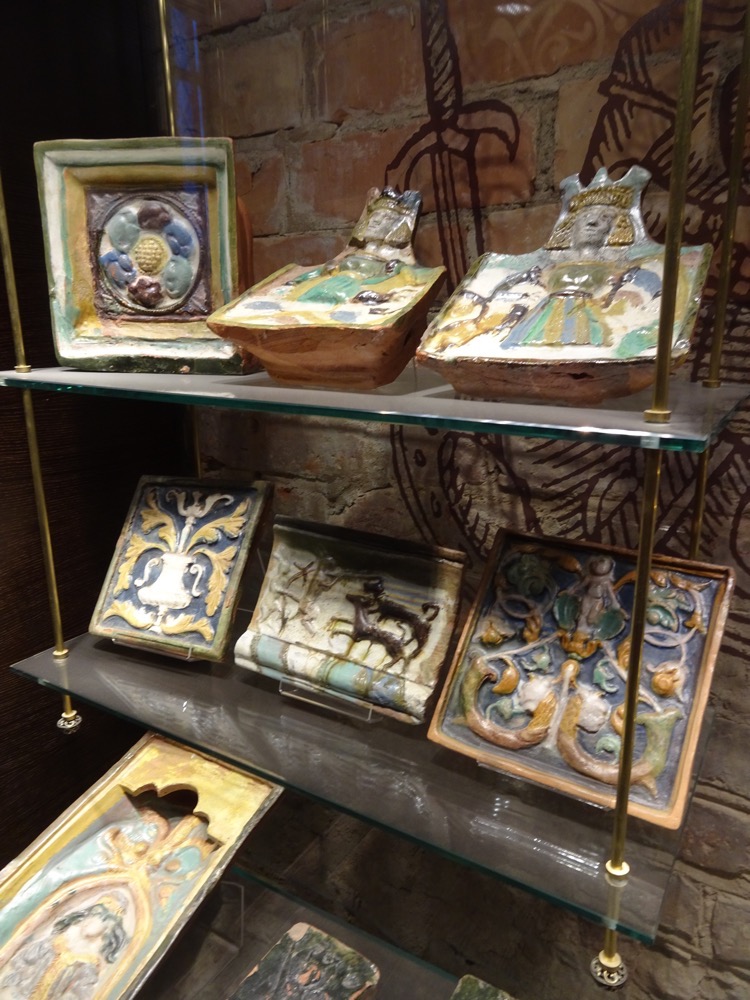
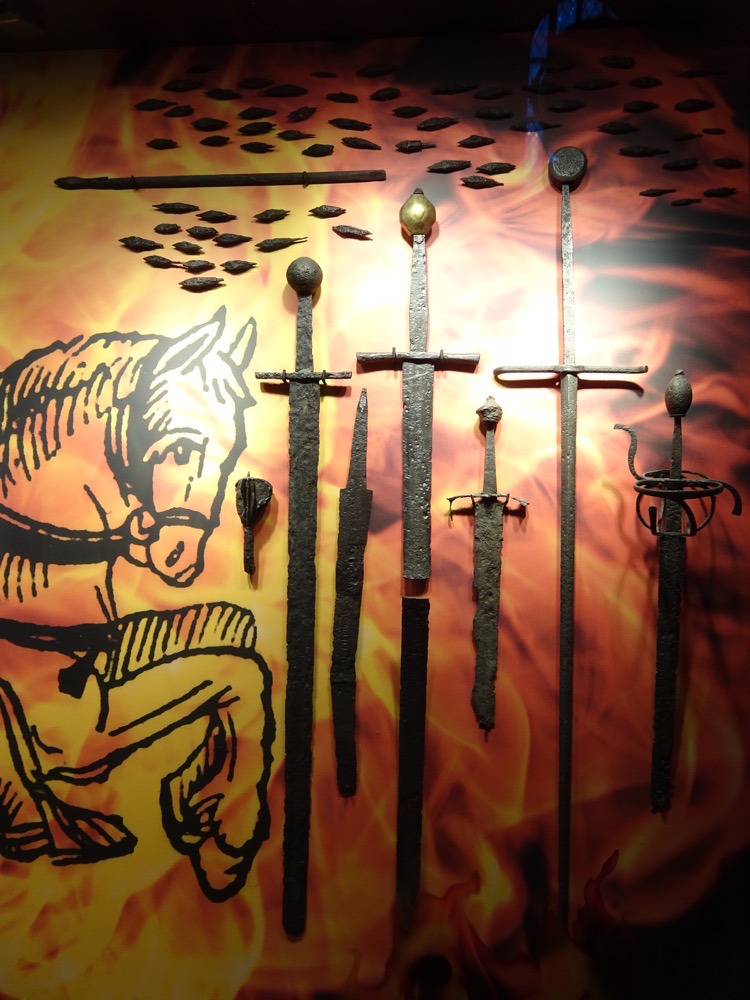
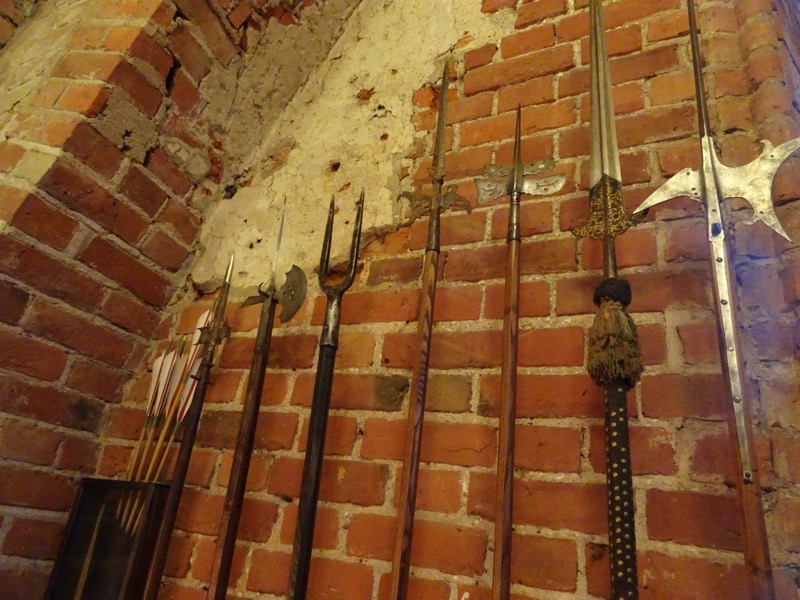
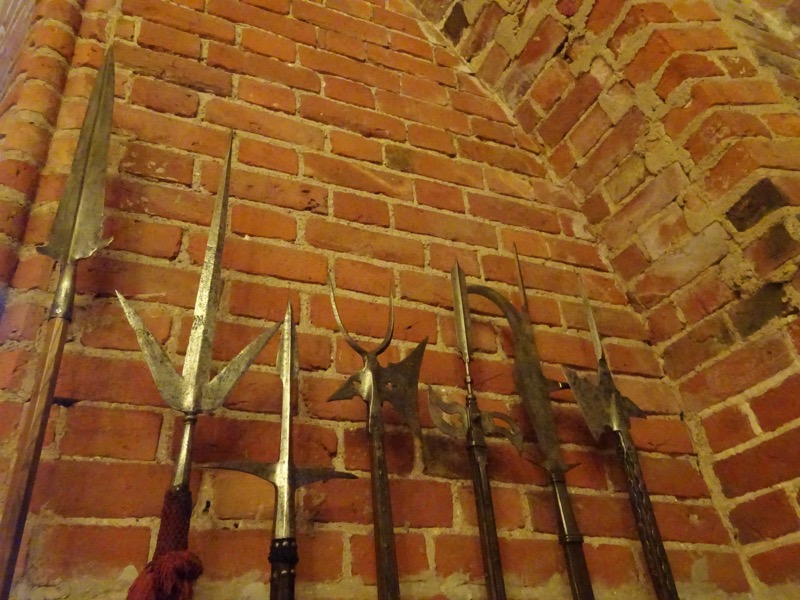
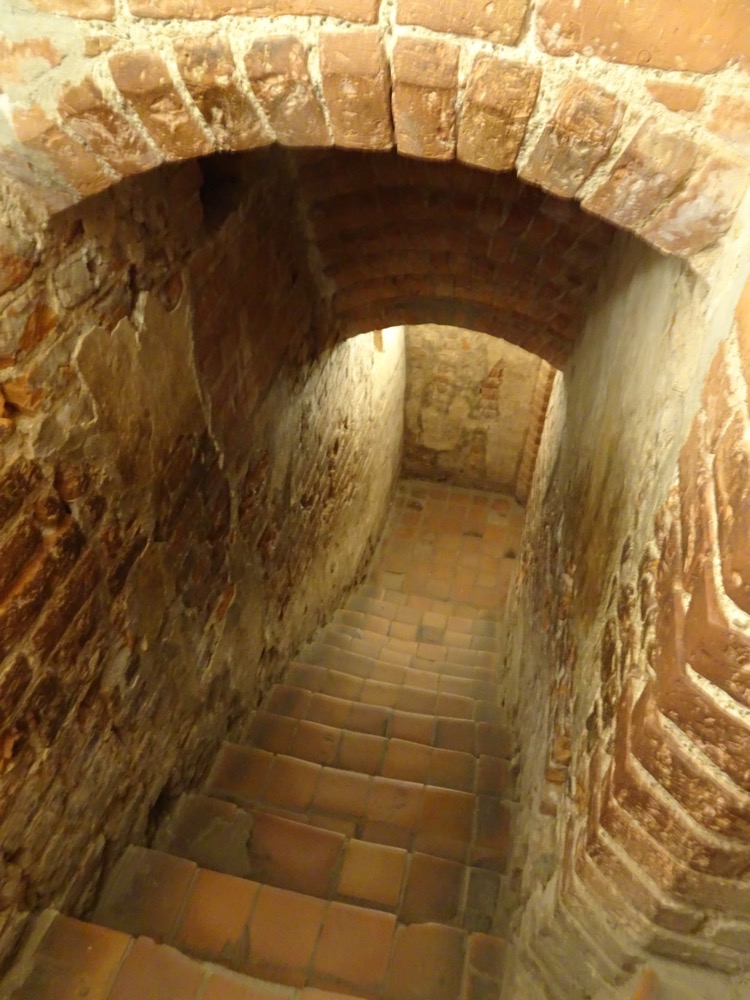
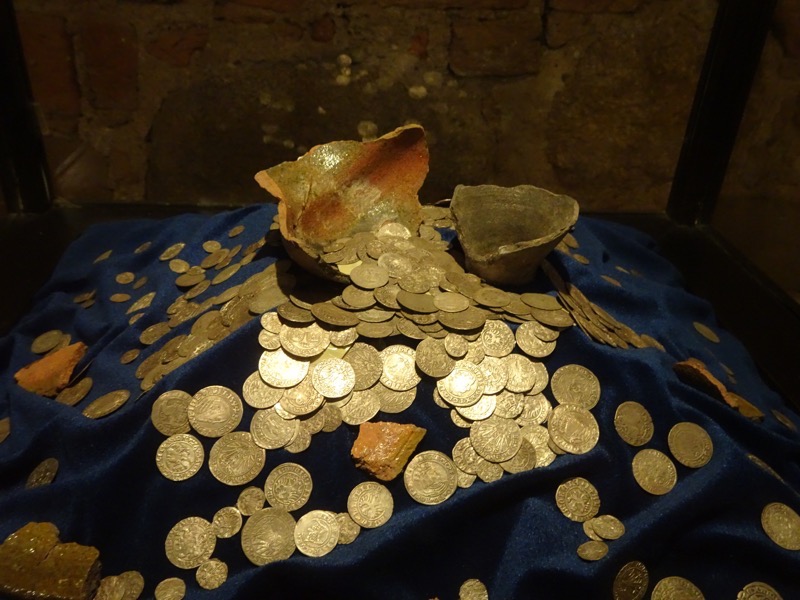
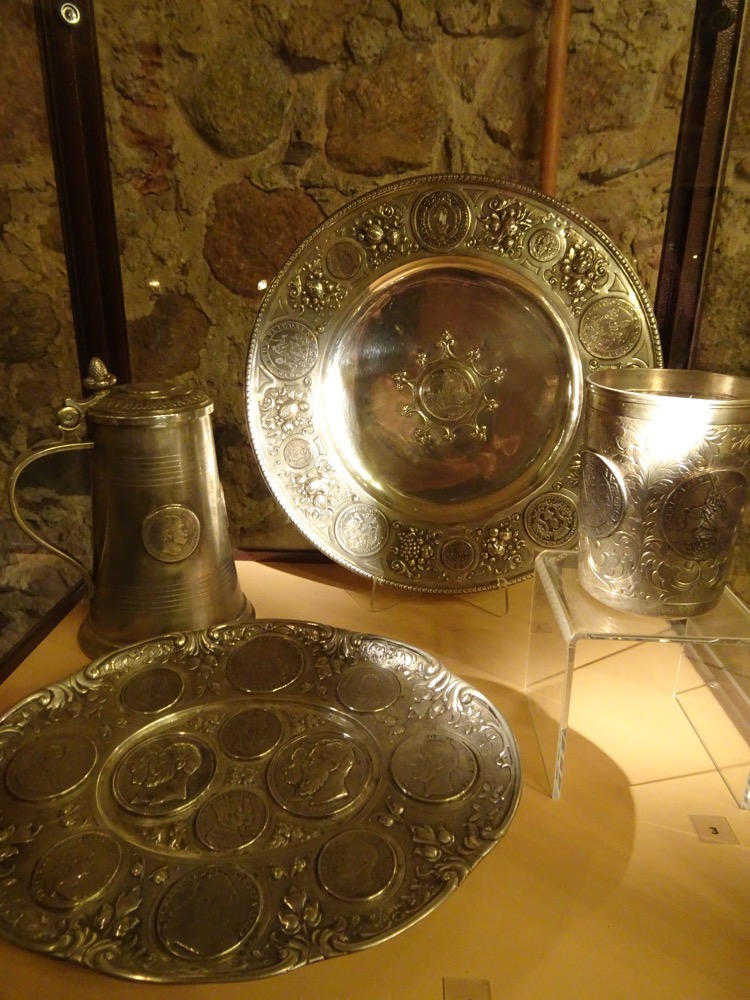
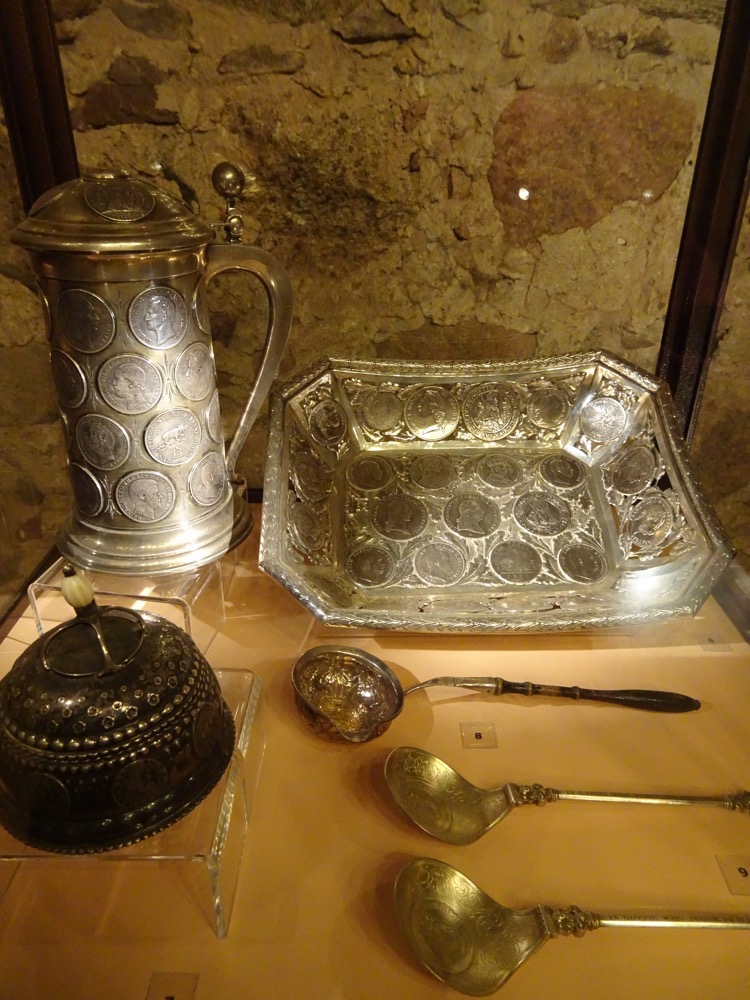
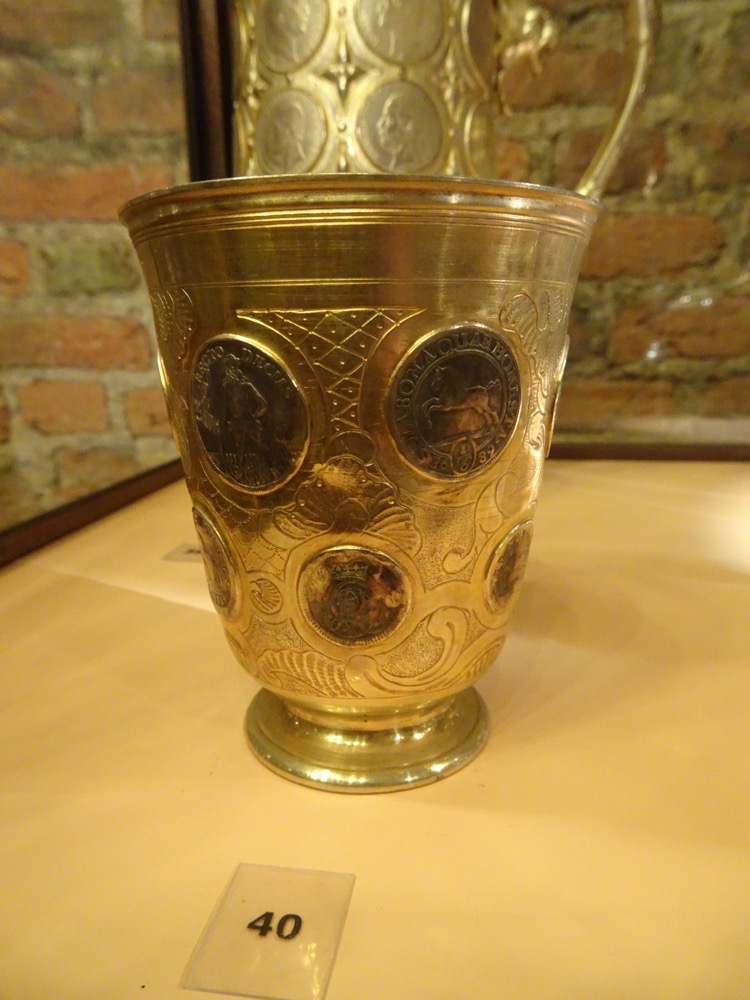 … Some not so genuine, like these lovely c.1970s post-modern stained glass windows (thankfully the lime green diagonal design is not so apparent in these photographs).
… Some not so genuine, like these lovely c.1970s post-modern stained glass windows (thankfully the lime green diagonal design is not so apparent in these photographs).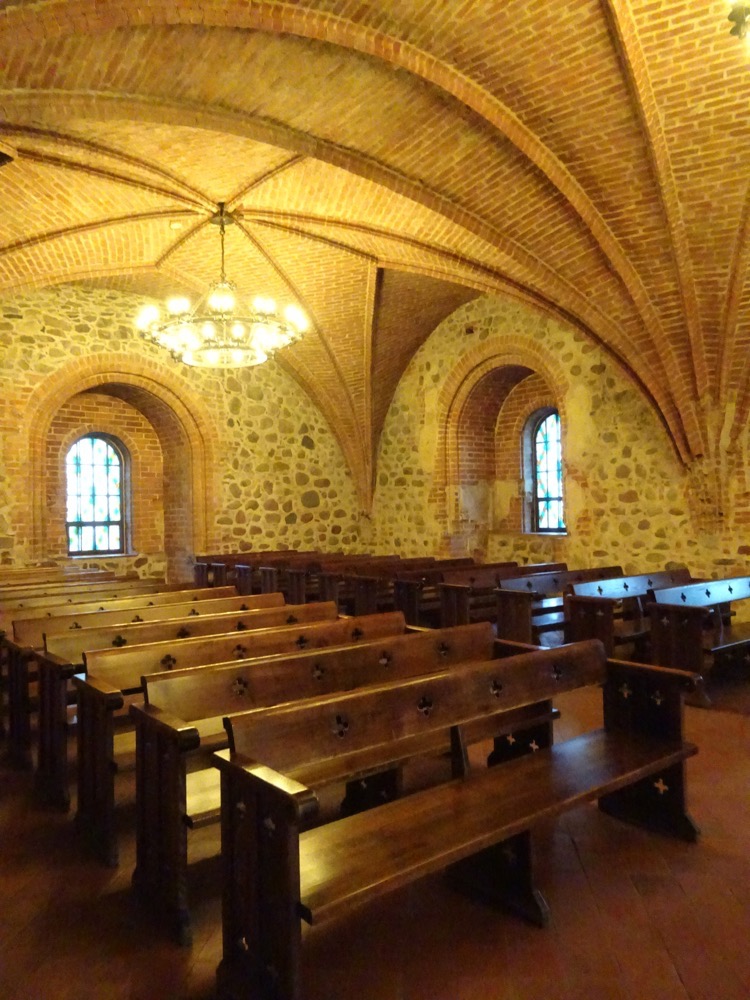
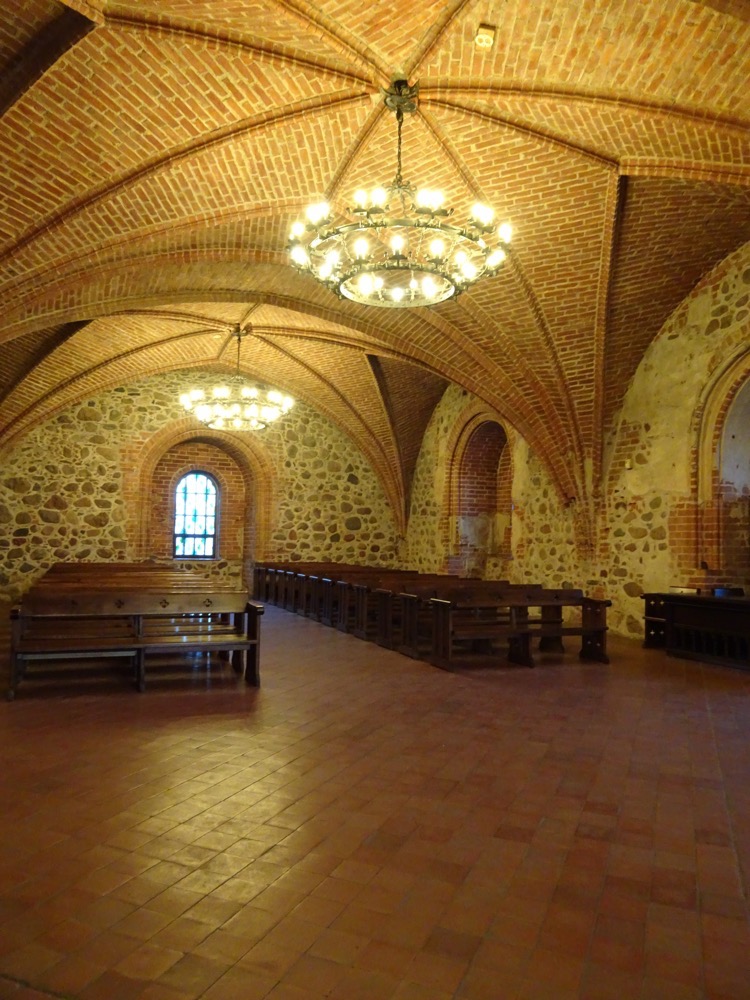
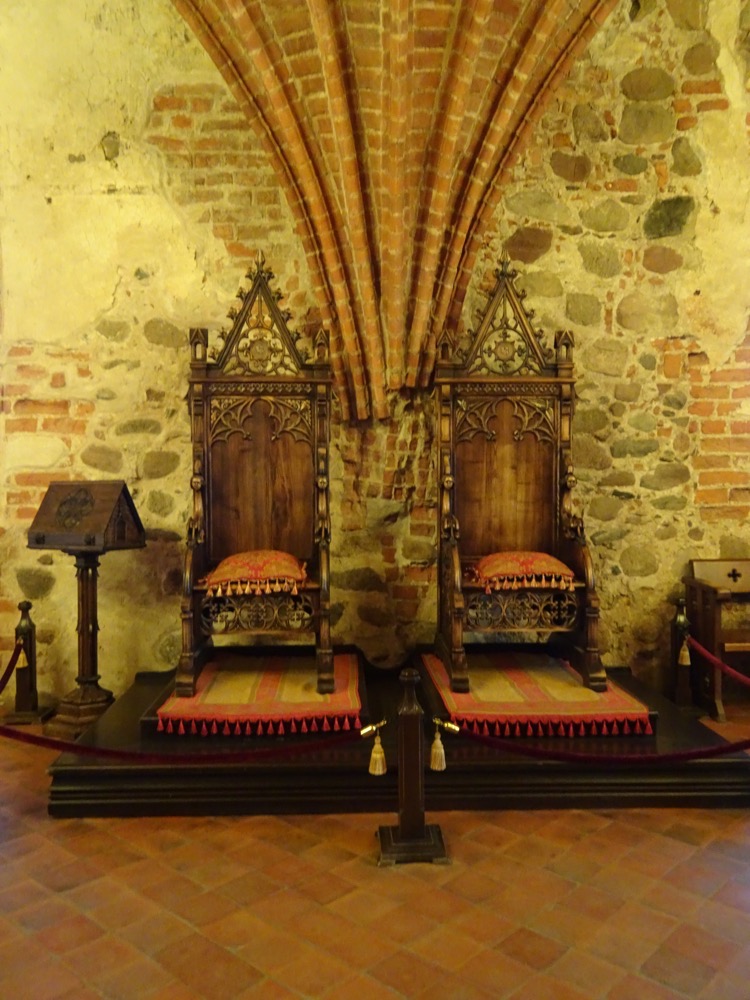
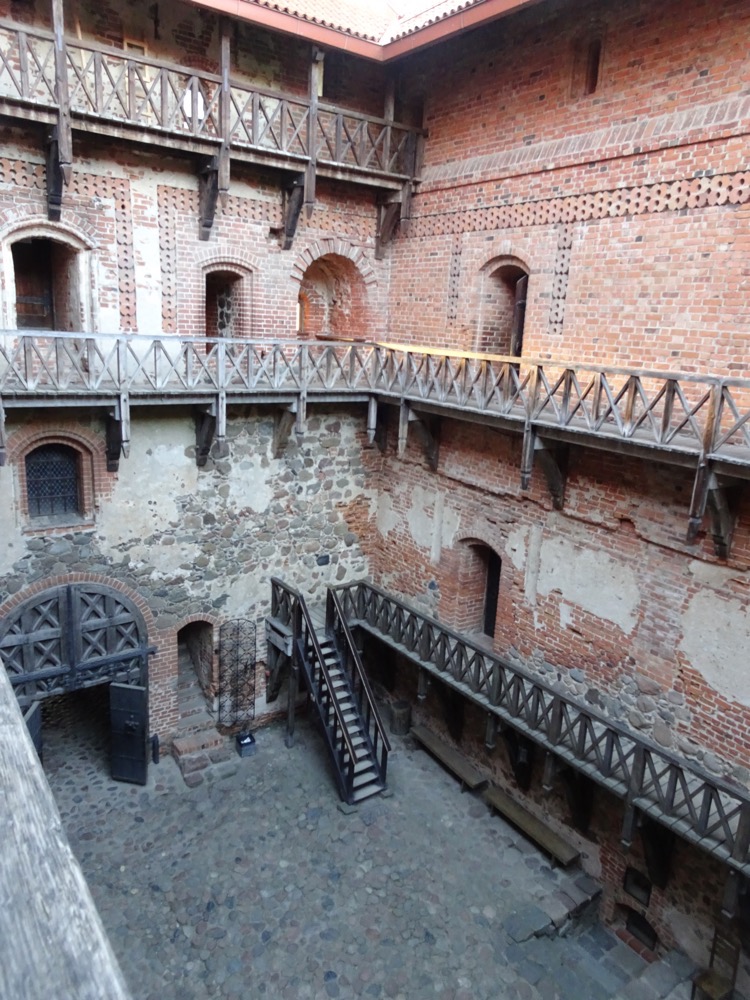 Recreated stained glass windows that date all the way back to 2006.
Recreated stained glass windows that date all the way back to 2006.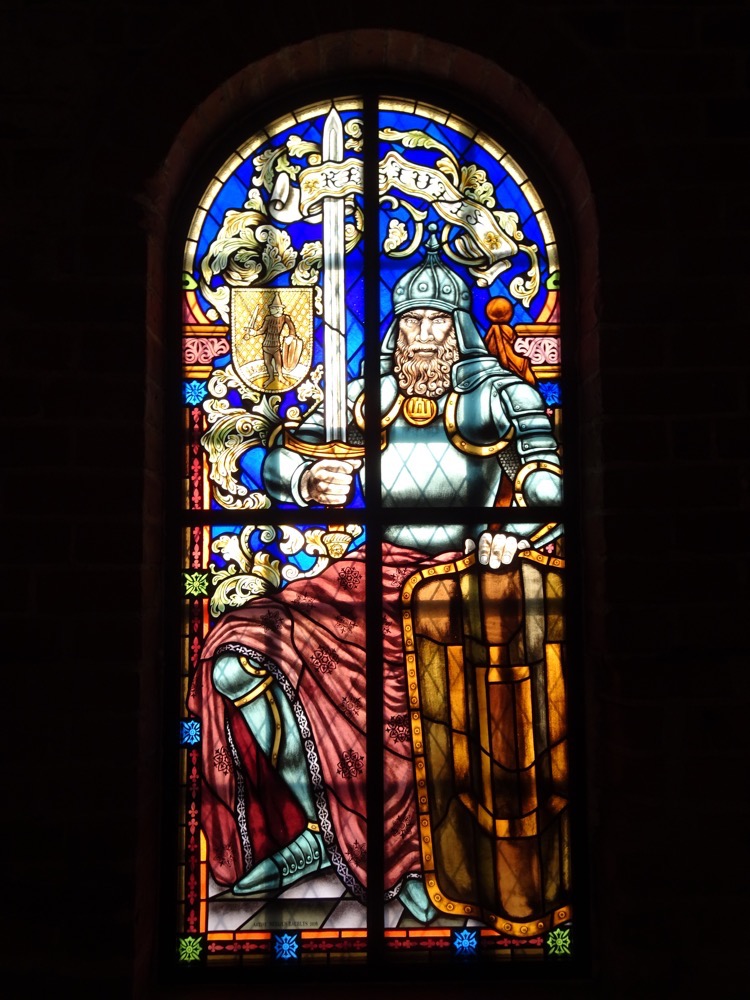
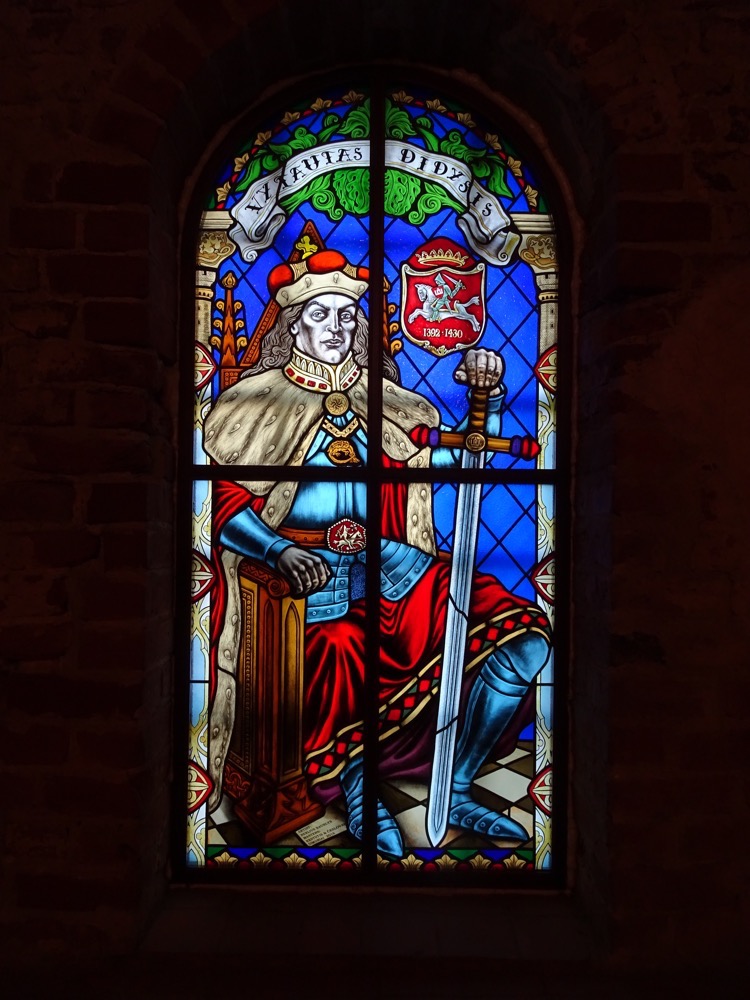 Photos of the Castle before the major renovations started in 1940s.
Photos of the Castle before the major renovations started in 1940s.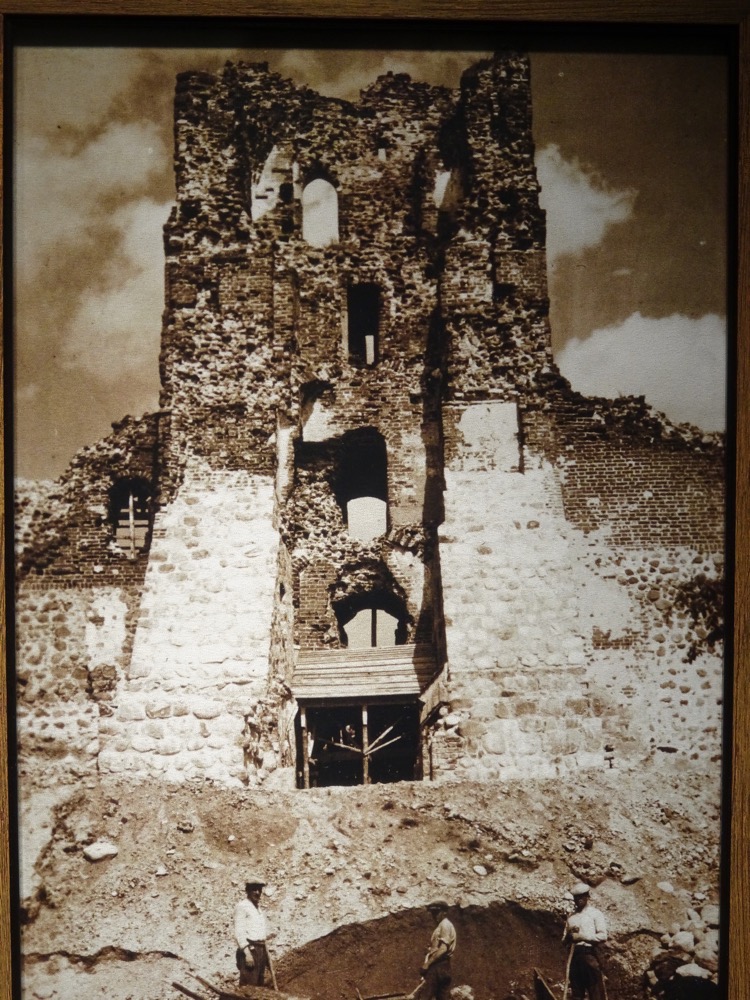
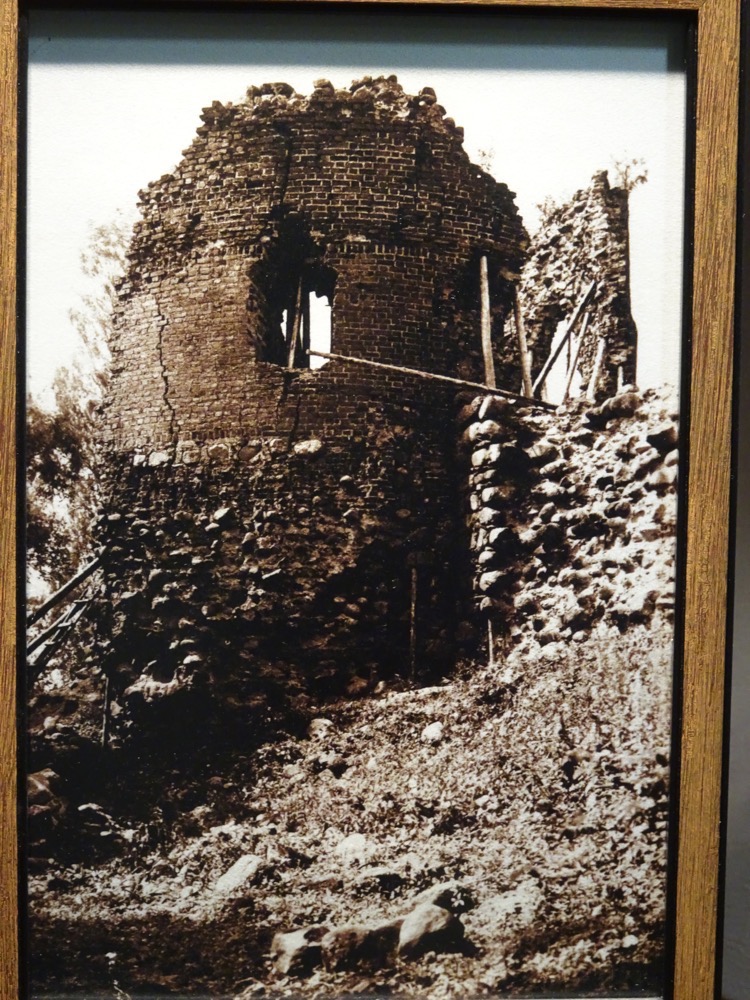 Other areas of the castle contain collections that have been donated to the Trakai Island Castle for display. Collections of official seals, pipes, Russian enamelware, taxidermied animals, and all sorts of other crap* are stored here (*weirdly gifts that appear to have been given to Lithuanian government officials over the last decade are all on display… weird plates from China in 2012, and just weird shit that has nothing to do with a 15th century castle).
Other areas of the castle contain collections that have been donated to the Trakai Island Castle for display. Collections of official seals, pipes, Russian enamelware, taxidermied animals, and all sorts of other crap* are stored here (*weirdly gifts that appear to have been given to Lithuanian government officials over the last decade are all on display… weird plates from China in 2012, and just weird shit that has nothing to do with a 15th century castle).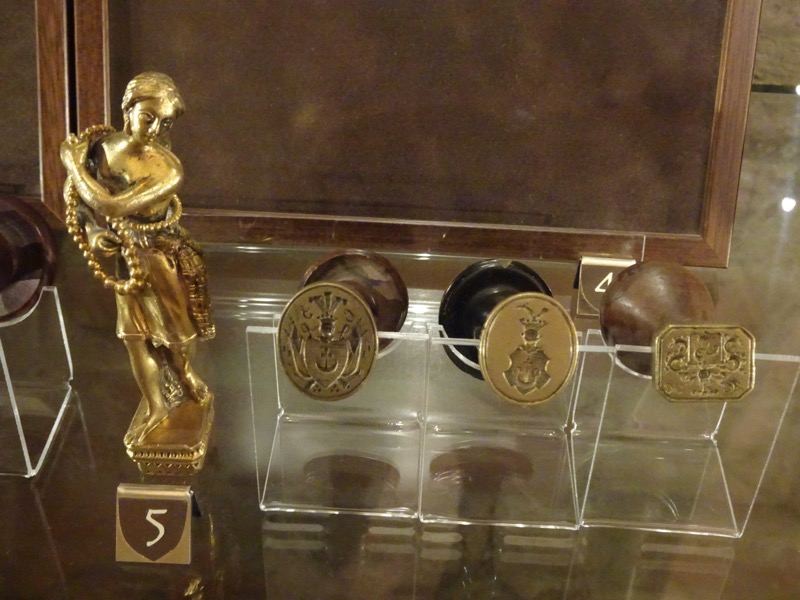
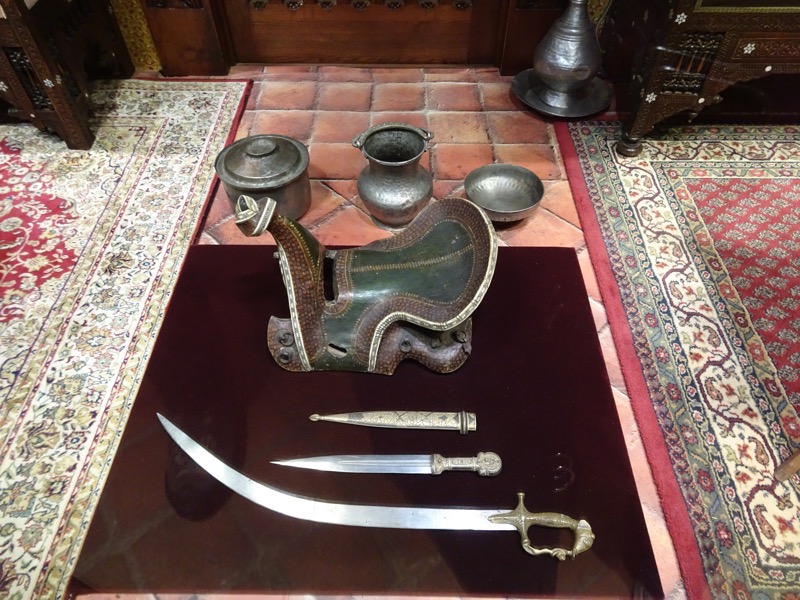
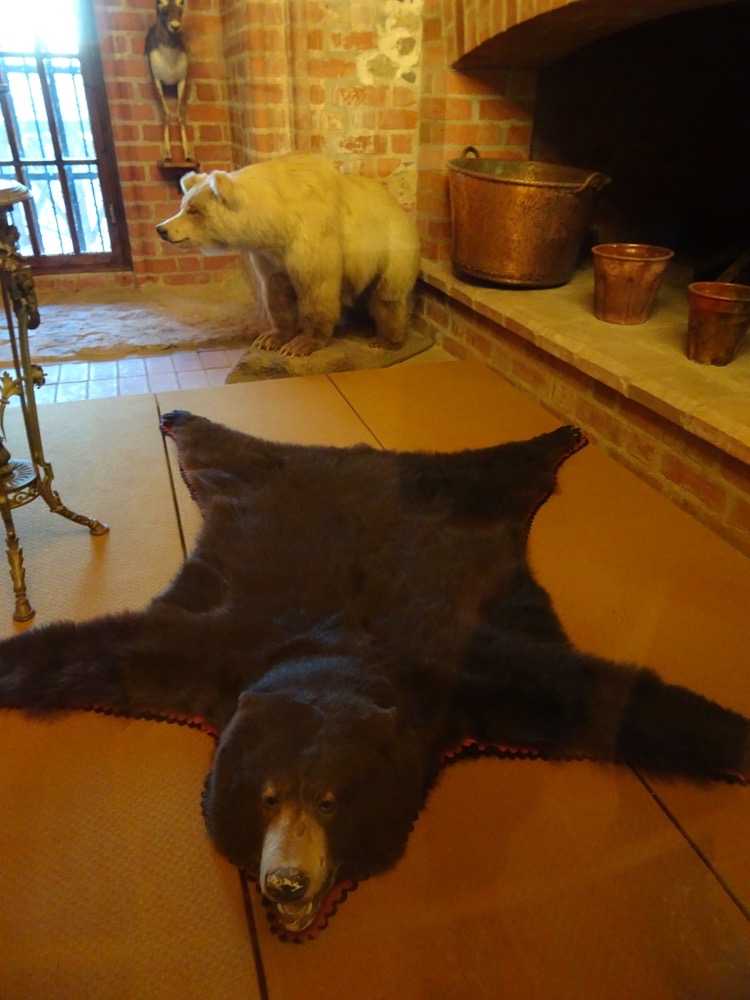
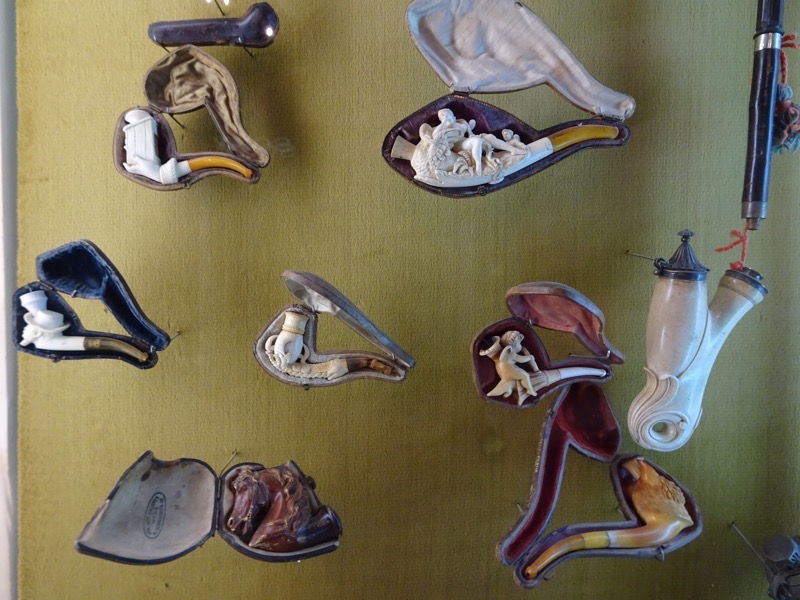
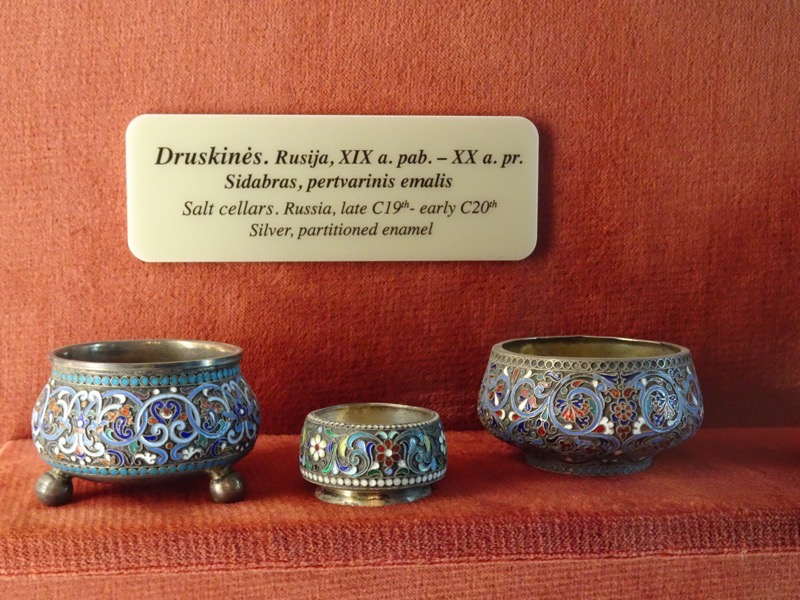 Still, it was quite a nice visit and it is so beautifully situation, it is well worth a look. I wouldn’t’ recommend checking it out in the middle of summer though, unless you were going to run in first thing in the morning or last thing in the afternoon and maybe get the place half empty – you can tell by the traffic flow that is set up, that it is probably a madhouse during peak season.
Still, it was quite a nice visit and it is so beautifully situation, it is well worth a look. I wouldn’t’ recommend checking it out in the middle of summer though, unless you were going to run in first thing in the morning or last thing in the afternoon and maybe get the place half empty – you can tell by the traffic flow that is set up, that it is probably a madhouse during peak season.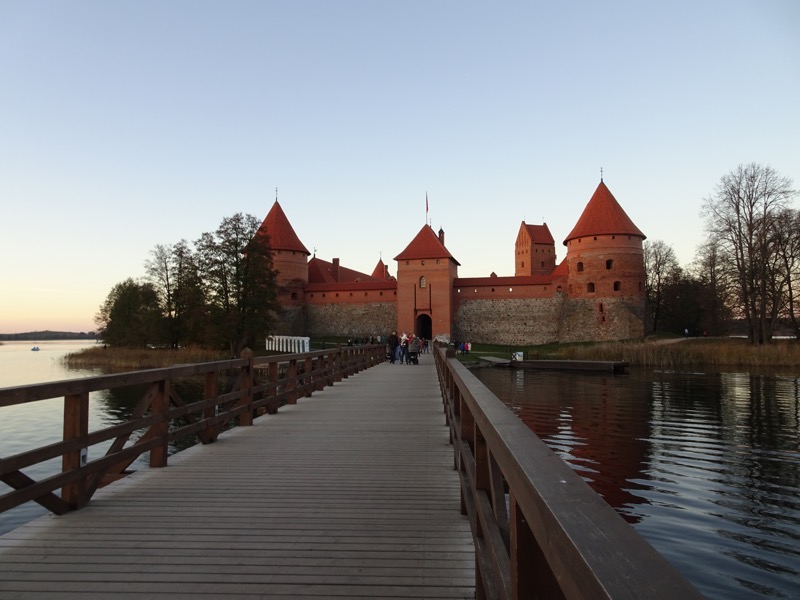 After this, it was back to Vilnius for the evening and another night at the crazy Bernadinau B&B. Vilnius has been lovely… didn’t find the G-Spot though.
After this, it was back to Vilnius for the evening and another night at the crazy Bernadinau B&B. Vilnius has been lovely… didn’t find the G-Spot though.
#falseadvertising
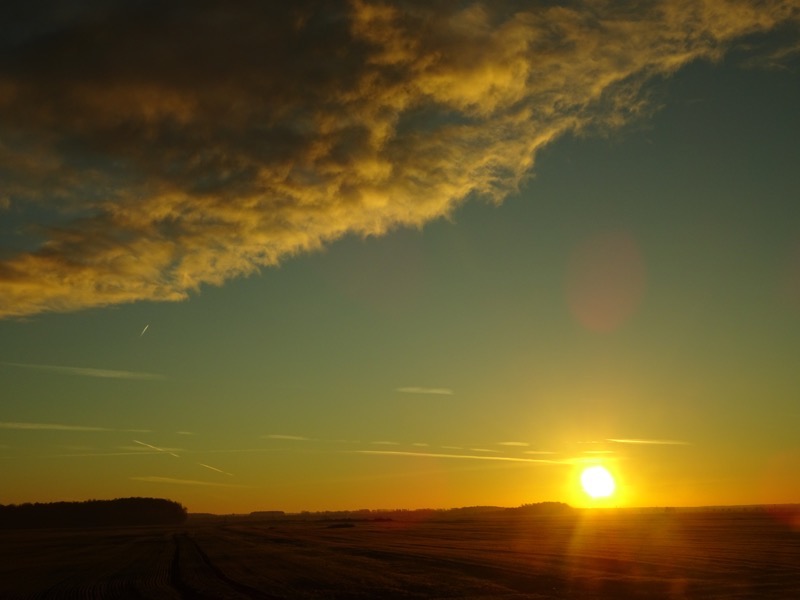 Once the sun was, up however, the darkness dissipated and showed us a foggy and potentially drizzly day ahead. It was very moody as we pummelled through the landscape in our trusty Ford Fuckus.
Once the sun was, up however, the darkness dissipated and showed us a foggy and potentially drizzly day ahead. It was very moody as we pummelled through the landscape in our trusty Ford Fuckus.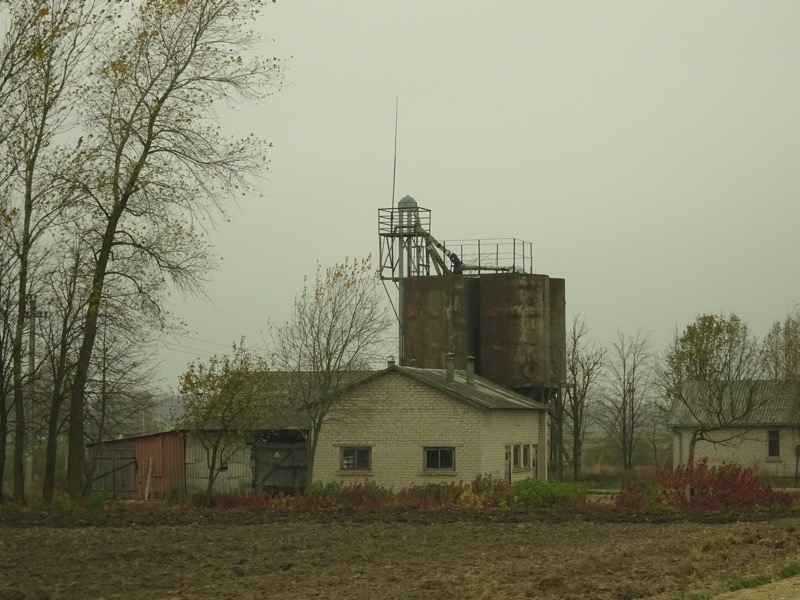
 Turns out it was a ‘Kompresorius’… but we won’t let that get in the way of yale looking ridiculous for our entertainment. We checked the tyres and acquired a hot chocolate (this one actually being hot-hot, unlike the last one which was left 90% unconsumed on a table with a note saying “THIS IS NOT HOT!” at a previous pit stop).
Turns out it was a ‘Kompresorius’… but we won’t let that get in the way of yale looking ridiculous for our entertainment. We checked the tyres and acquired a hot chocolate (this one actually being hot-hot, unlike the last one which was left 90% unconsumed on a table with a note saying “THIS IS NOT HOT!” at a previous pit stop). Check out these unsightly erections dotting the landscape, ruining the views.
Check out these unsightly erections dotting the landscape, ruining the views.
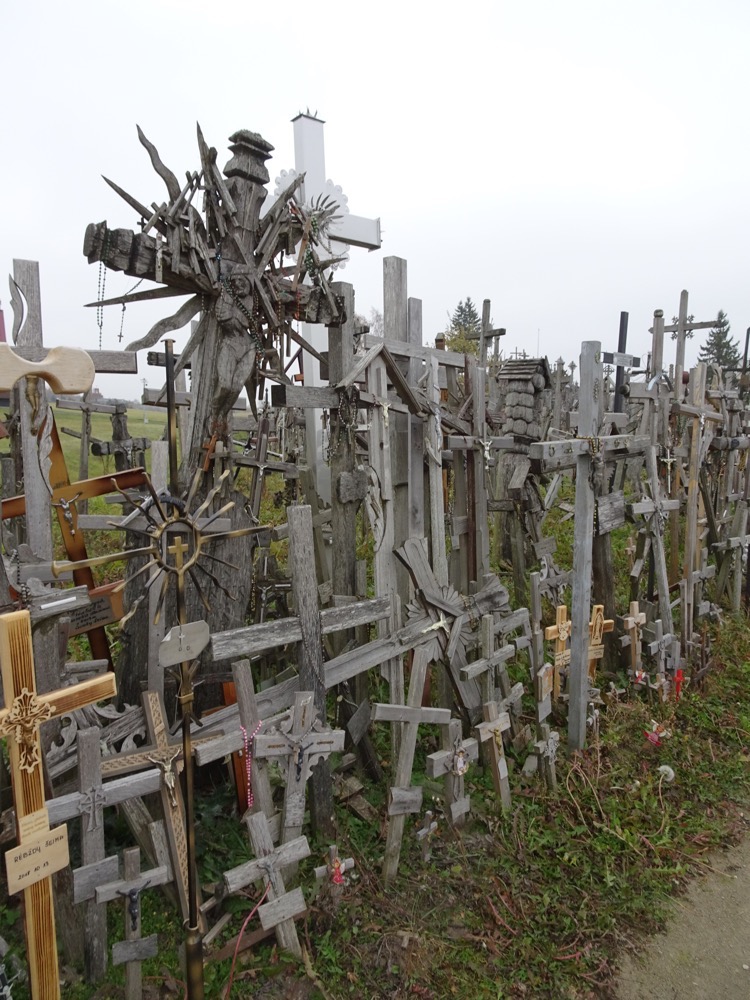 The Hill of Crosses is about 12 km north of the city of Šiauliai, in the north of Lithuania, about an 80-90 min out of Vilnius. The actual origin of the practice of leaving crosses on this particular hill has been obscured by the passing of time, but it is thought that the first crosses appeared on the site of the former Jurgaičiai or Domantai hill fort after the famed 1831 Uprising (for those that are unfamiliar with the 1831 Uprising it was also known as the Polish-Russian War of 1830-1831. It was an armed rebellion by the Polish against the Russian Empire, which the Russians roundly won.
The Hill of Crosses is about 12 km north of the city of Šiauliai, in the north of Lithuania, about an 80-90 min out of Vilnius. The actual origin of the practice of leaving crosses on this particular hill has been obscured by the passing of time, but it is thought that the first crosses appeared on the site of the former Jurgaičiai or Domantai hill fort after the famed 1831 Uprising (for those that are unfamiliar with the 1831 Uprising it was also known as the Polish-Russian War of 1830-1831. It was an armed rebellion by the Polish against the Russian Empire, which the Russians roundly won.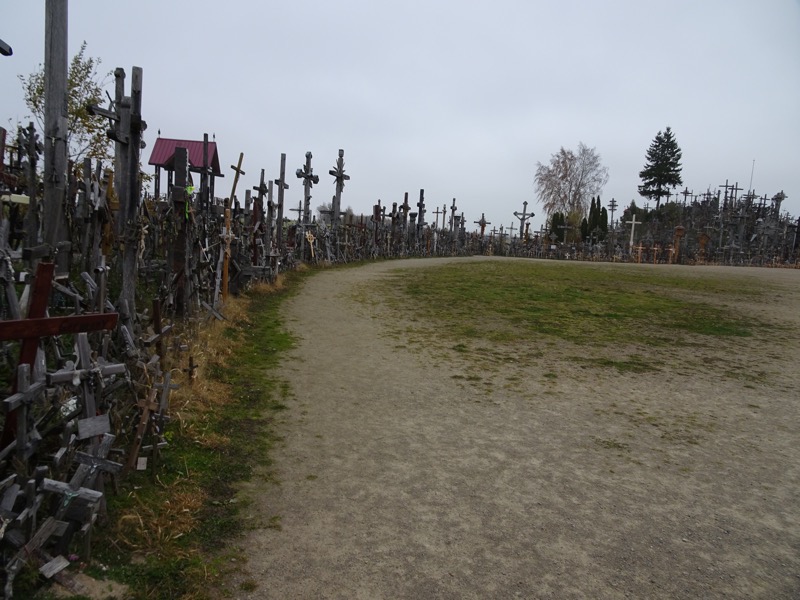
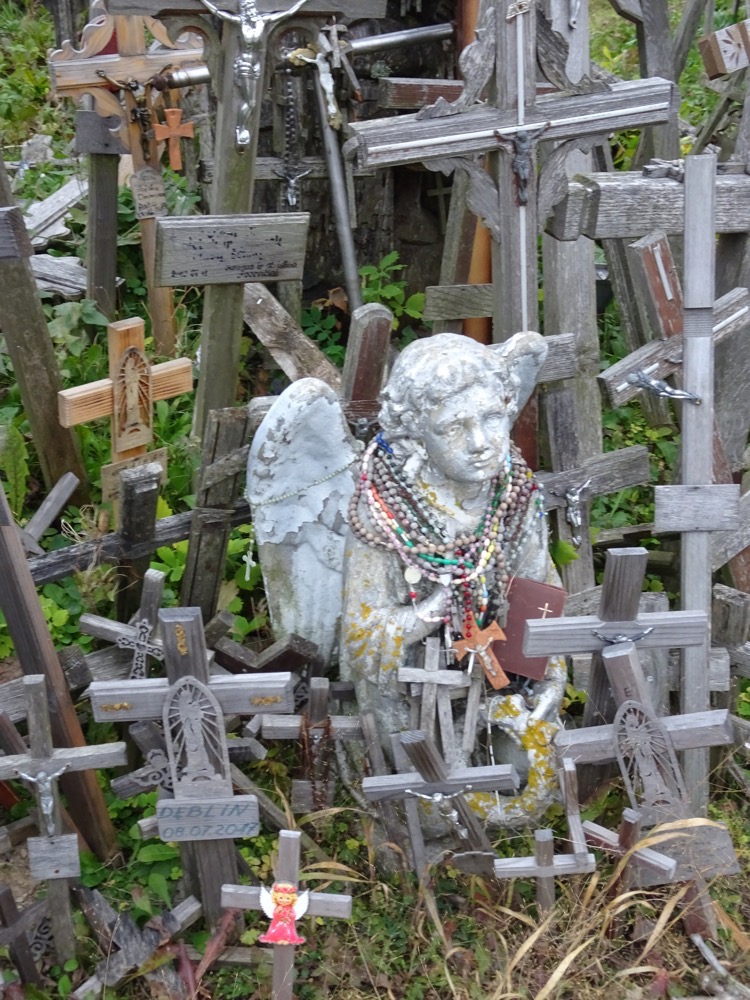
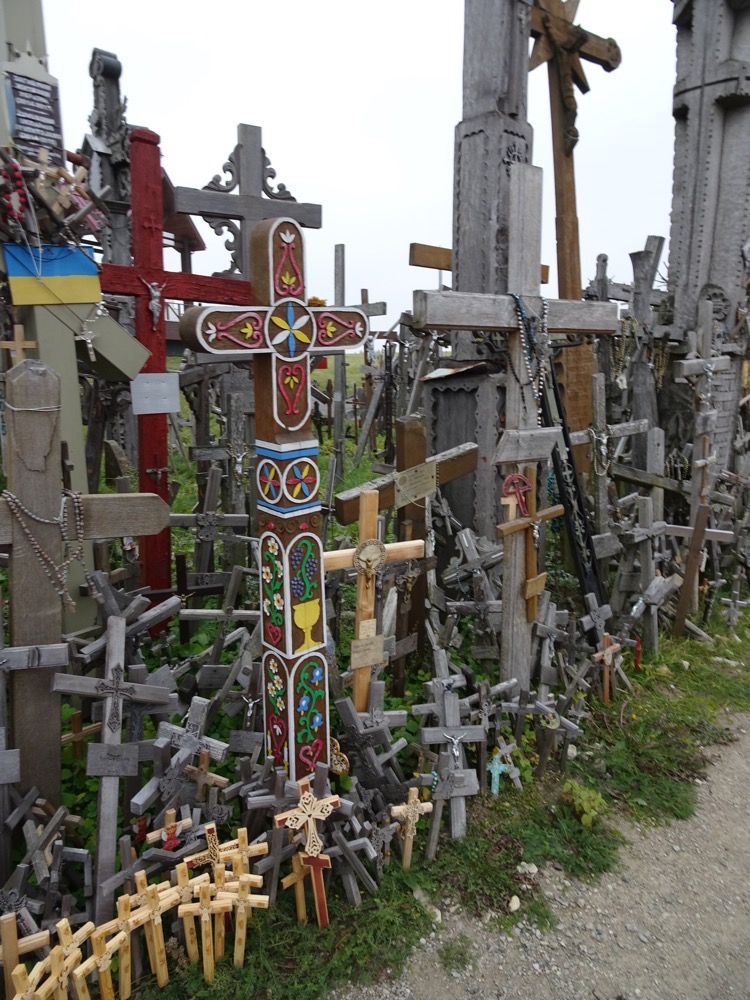 After Lithuania became part of the Russian Empire, both the Poles and Lithuanians unsuccessfully rebelled against Russian authorities in 1831 and again in 1863. These two uprisings are connected with the beginnings of the cross on the hill. Many families could not locate the bodies of their cherished loved ones and lost rebels, so they started placing their memorials here in the form of symbolic crosses where there had been a former hill fort.
After Lithuania became part of the Russian Empire, both the Poles and Lithuanians unsuccessfully rebelled against Russian authorities in 1831 and again in 1863. These two uprisings are connected with the beginnings of the cross on the hill. Many families could not locate the bodies of their cherished loved ones and lost rebels, so they started placing their memorials here in the form of symbolic crosses where there had been a former hill fort.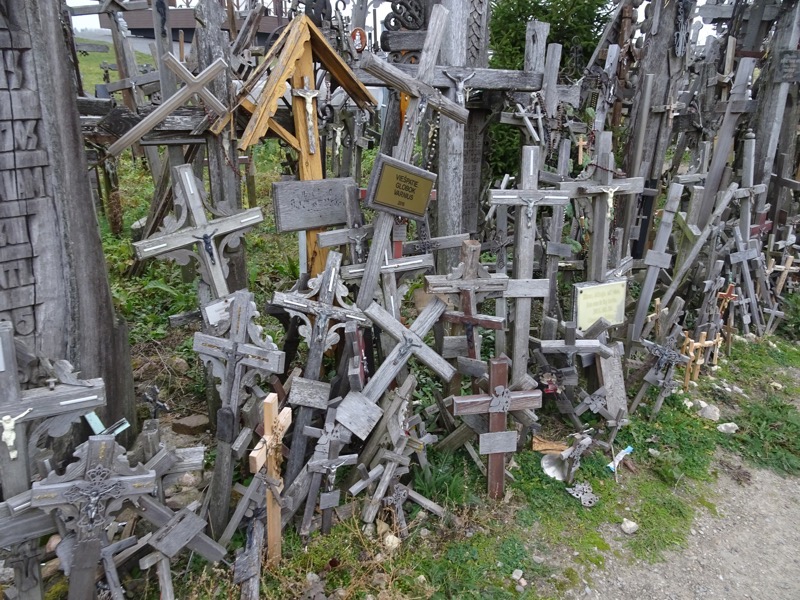 When the old political structure of the Russian Empire in Eastern Europe fell apart in 1918, Lithuania once again attempted to declare its independence. Throughout all this time from 1830 to 1918, the Hill of Crosses became a place for Lithuanians to pray for peace, for the stability and independence of their country, and for their lost loved ones during the Wars of Independence.
When the old political structure of the Russian Empire in Eastern Europe fell apart in 1918, Lithuania once again attempted to declare its independence. Throughout all this time from 1830 to 1918, the Hill of Crosses became a place for Lithuanians to pray for peace, for the stability and independence of their country, and for their lost loved ones during the Wars of Independence.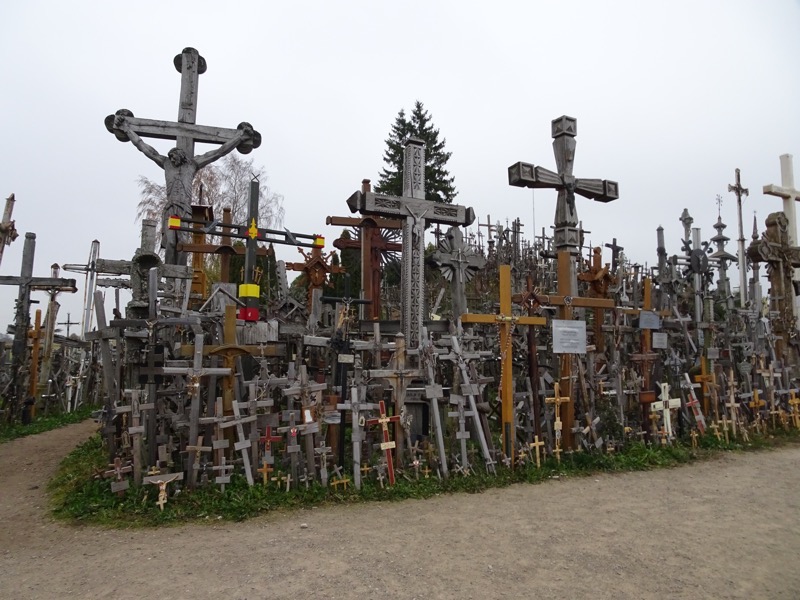 The site took on an even more historic significance during the years 1944–1990 if that were possible, while Lithuania was occupied by the Soviet Union. People continued to travel to the Hill and leave their crosses and memorials and for Lithuanians, this place signified their original national identity, their religion, heritage and culture. It became a place not just of memorialising those who were lost, but also a powerful place of peaceful resistance. The Soviets authorities repeatedly worked hard to remove the crosses and tried to remove the symbolism of the sit – even bulldozed the entire site on at least three separate occasions as recently as 1963 and 1973, but the crosses continued to reappear. Apparently, the Soviets even considered building a damn on the nearby Kulvė River, so that the hill would end up underwater, but this never came to pass.
The site took on an even more historic significance during the years 1944–1990 if that were possible, while Lithuania was occupied by the Soviet Union. People continued to travel to the Hill and leave their crosses and memorials and for Lithuanians, this place signified their original national identity, their religion, heritage and culture. It became a place not just of memorialising those who were lost, but also a powerful place of peaceful resistance. The Soviets authorities repeatedly worked hard to remove the crosses and tried to remove the symbolism of the sit – even bulldozed the entire site on at least three separate occasions as recently as 1963 and 1973, but the crosses continued to reappear. Apparently, the Soviets even considered building a damn on the nearby Kulvė River, so that the hill would end up underwater, but this never came to pass.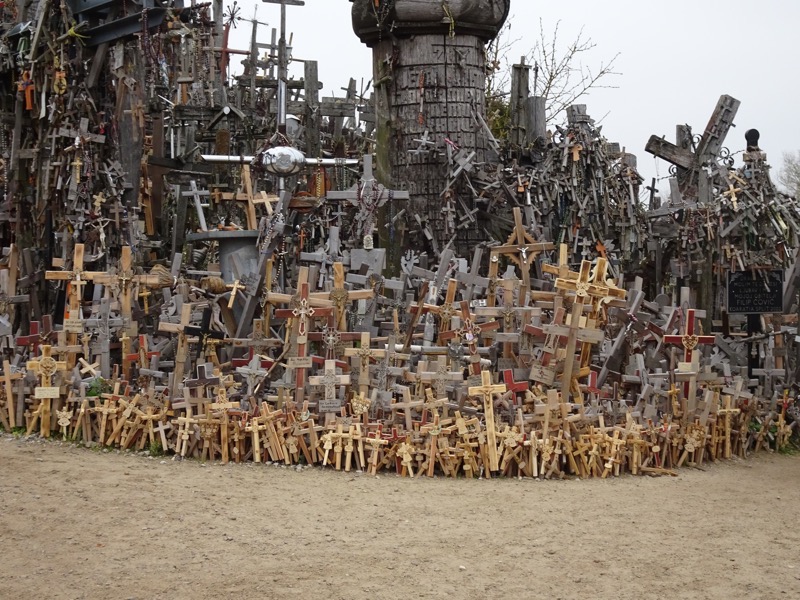 Now, there are more crosses here than ever, and the site represents the solidarity and steadfastness with which the Lithuanian people held out for independence from the Russian Empire and then Soviet Union for over a century.
Now, there are more crosses here than ever, and the site represents the solidarity and steadfastness with which the Lithuanian people held out for independence from the Russian Empire and then Soviet Union for over a century.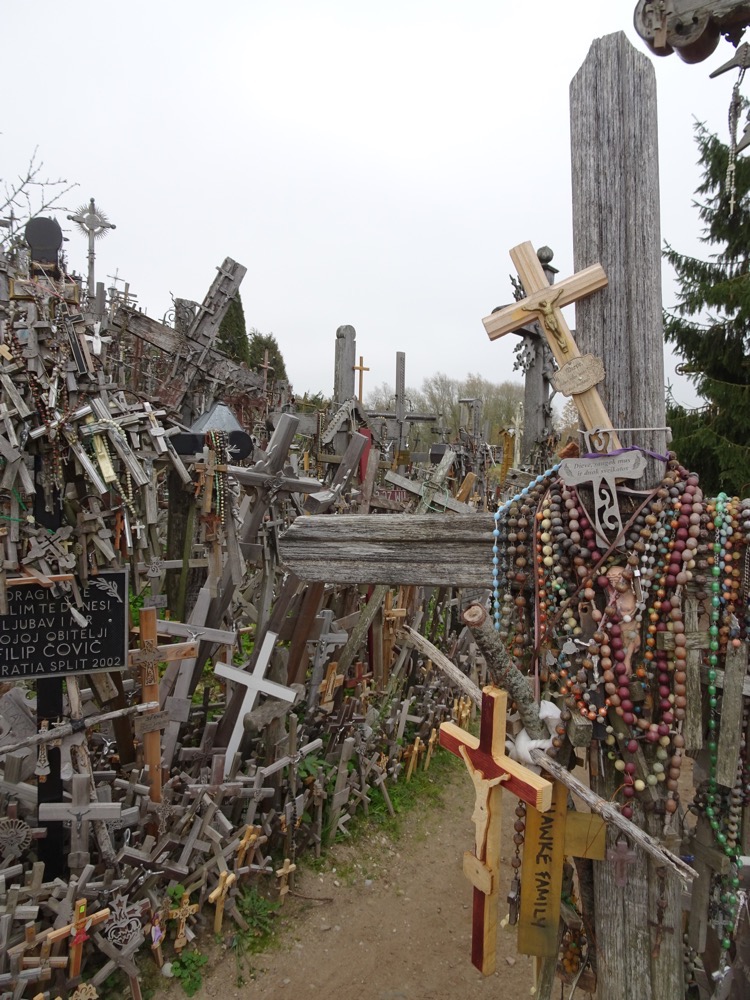
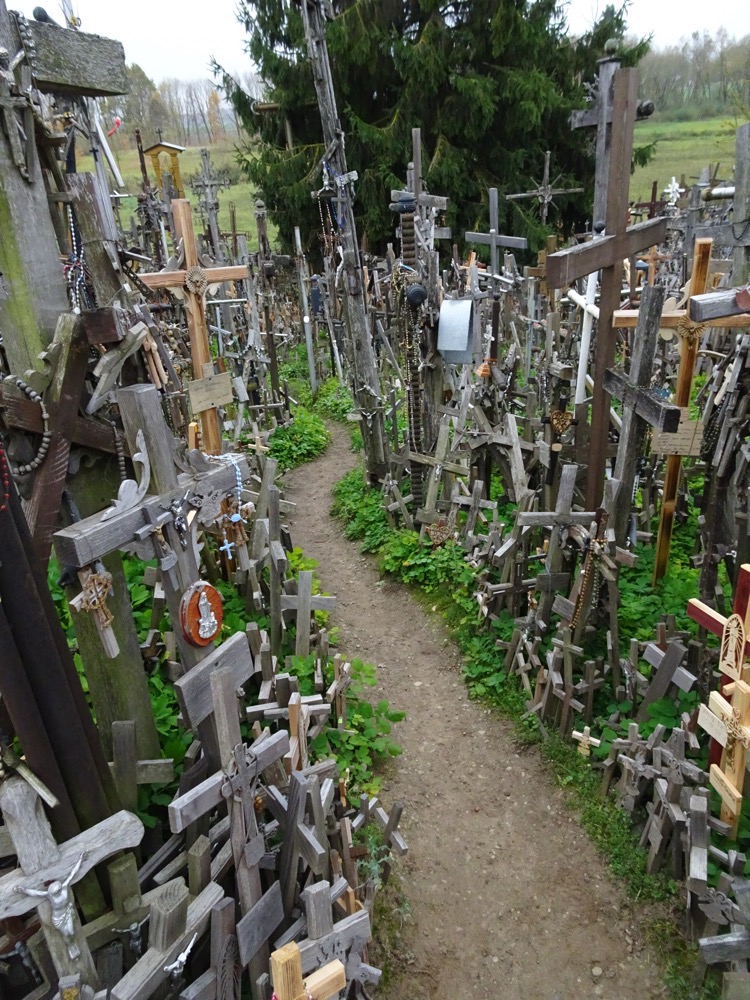 The hill is a quiet, mournful sort of place. Particularly so on a day like today when there was no one here but ourselves and we could hear the rosaries tinkling in the wind like chimes trying to tell stories of all these lost souls.
The hill is a quiet, mournful sort of place. Particularly so on a day like today when there was no one here but ourselves and we could hear the rosaries tinkling in the wind like chimes trying to tell stories of all these lost souls.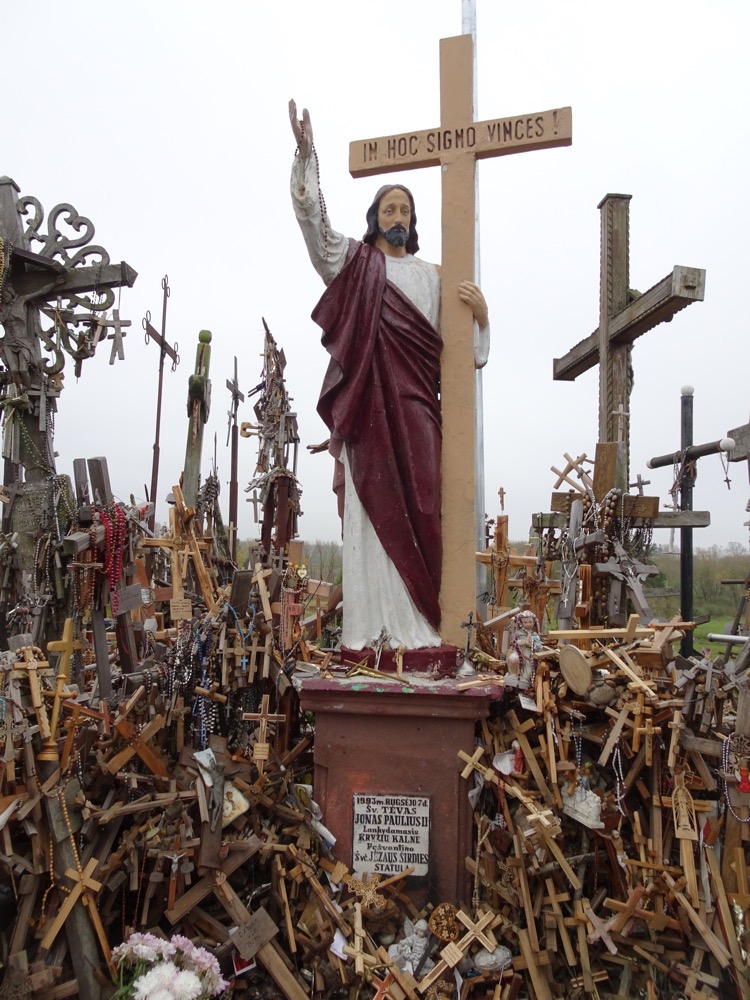
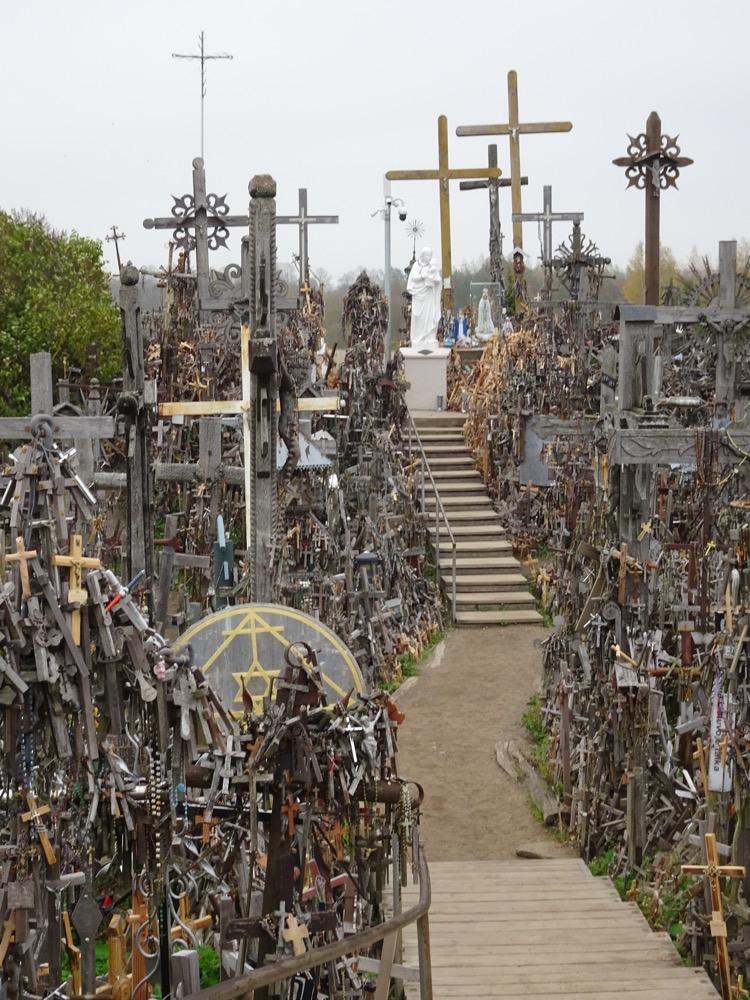
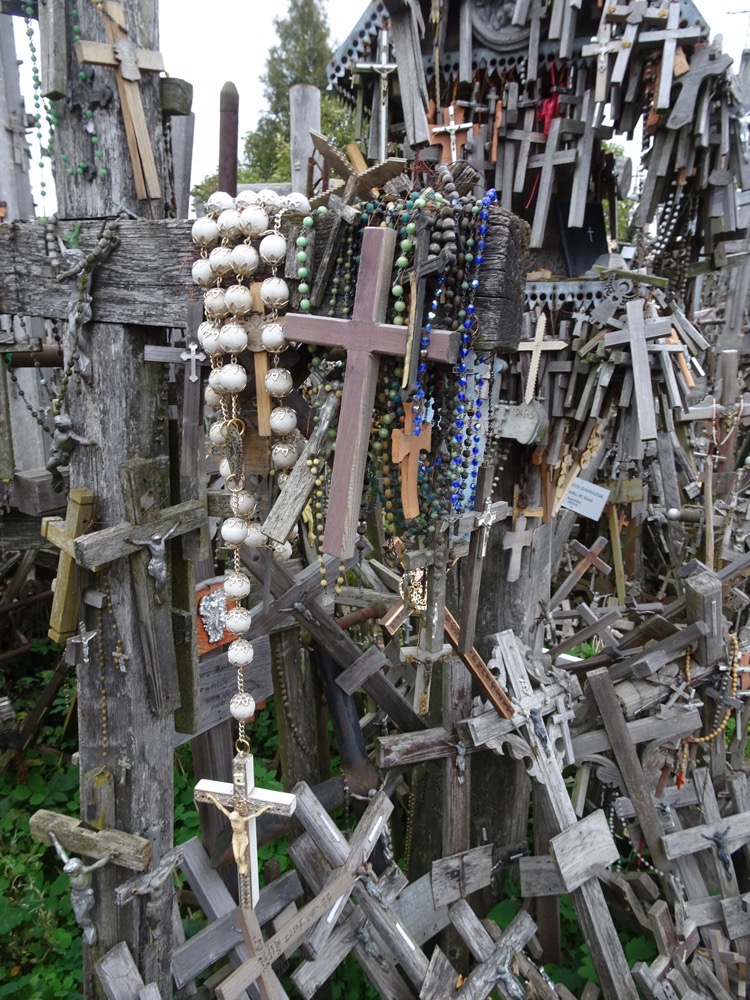
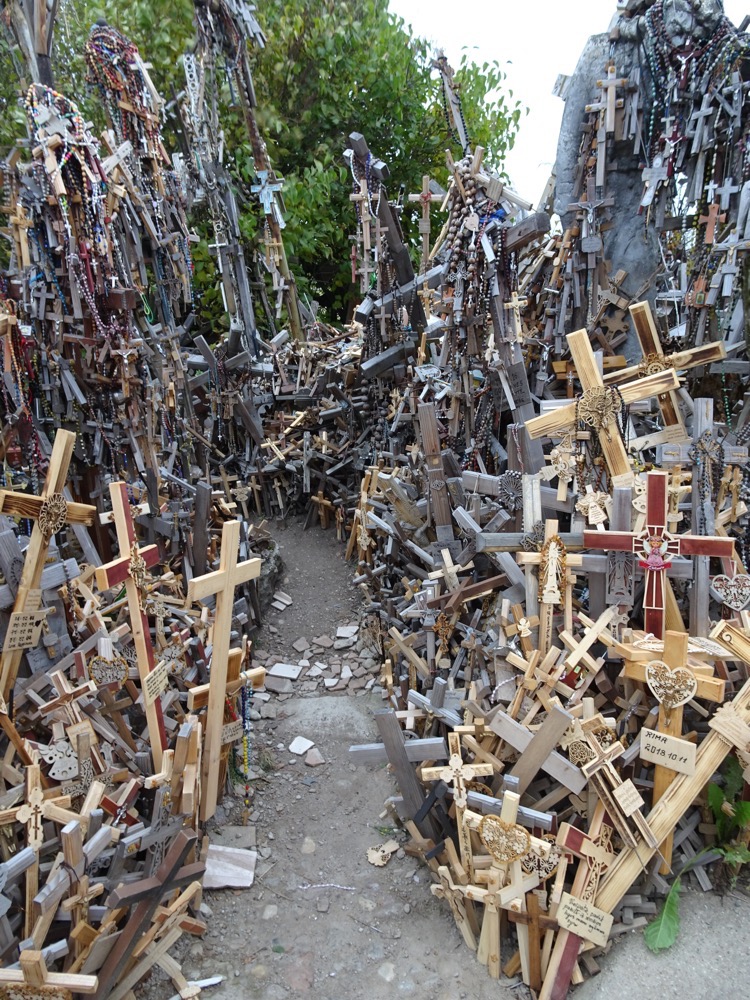
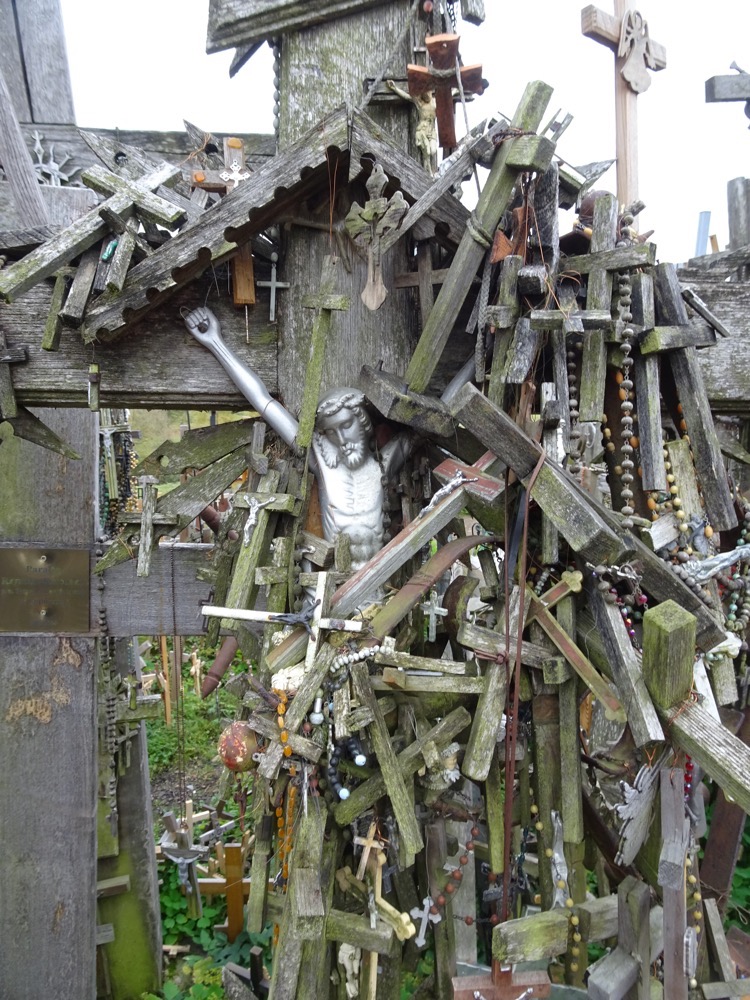 I took ever so many photographs, it is hard to encapsulate the sheer volume of crosses – each one carrying a story of a pilgrim and a lost loved one.
I took ever so many photographs, it is hard to encapsulate the sheer volume of crosses – each one carrying a story of a pilgrim and a lost loved one.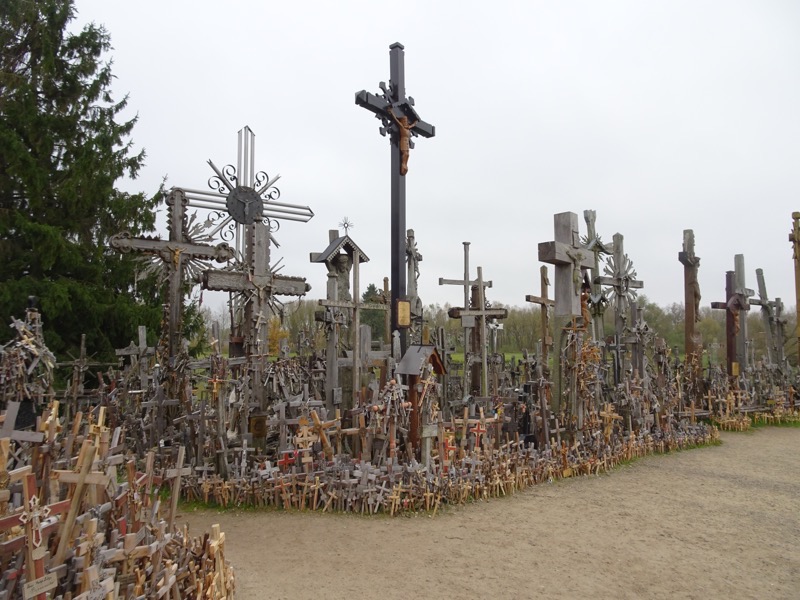 After we left the Hill of Crosses, we head off into blue skies and crazy cloud formations for the afternoon. In amongst blogging about yesterday, I was constantly staring out the window at these amazing clouds and the beautiful contrast in colours between the blue skies, the fluffy white clouds, the lush green grass and the yellow autumn leaves. My speed landscape photography is improving every day!
After we left the Hill of Crosses, we head off into blue skies and crazy cloud formations for the afternoon. In amongst blogging about yesterday, I was constantly staring out the window at these amazing clouds and the beautiful contrast in colours between the blue skies, the fluffy white clouds, the lush green grass and the yellow autumn leaves. My speed landscape photography is improving every day!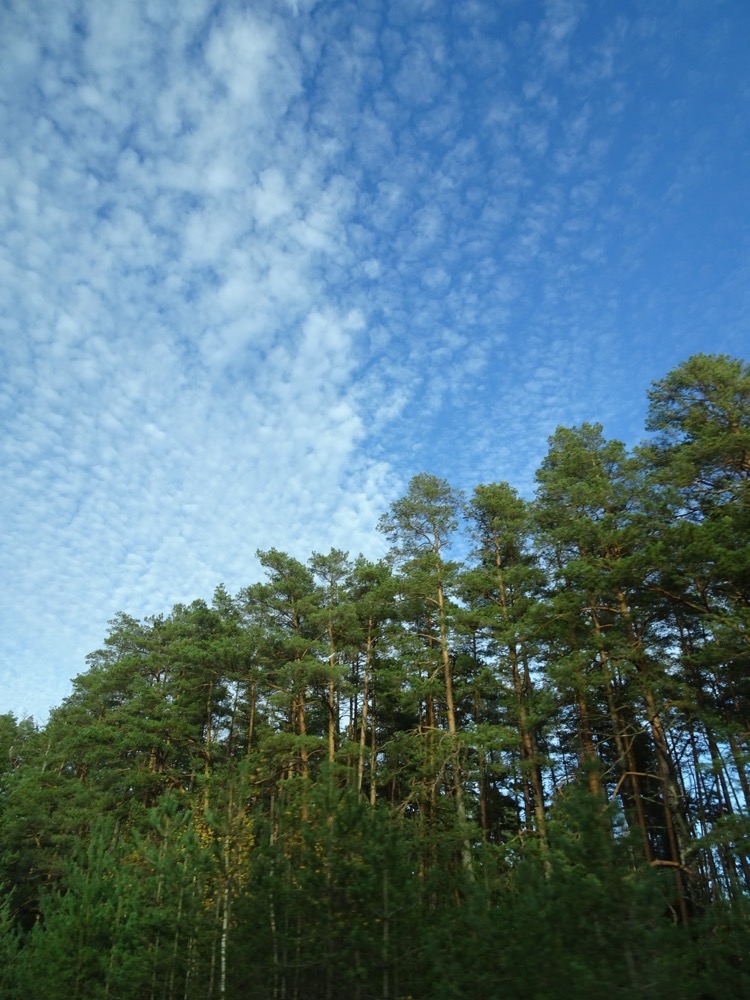 Ooh look, lots of military vehicles and suddenly lo’ and behold another unmanned border between Lithuania and Latvia.
Ooh look, lots of military vehicles and suddenly lo’ and behold another unmanned border between Lithuania and Latvia.


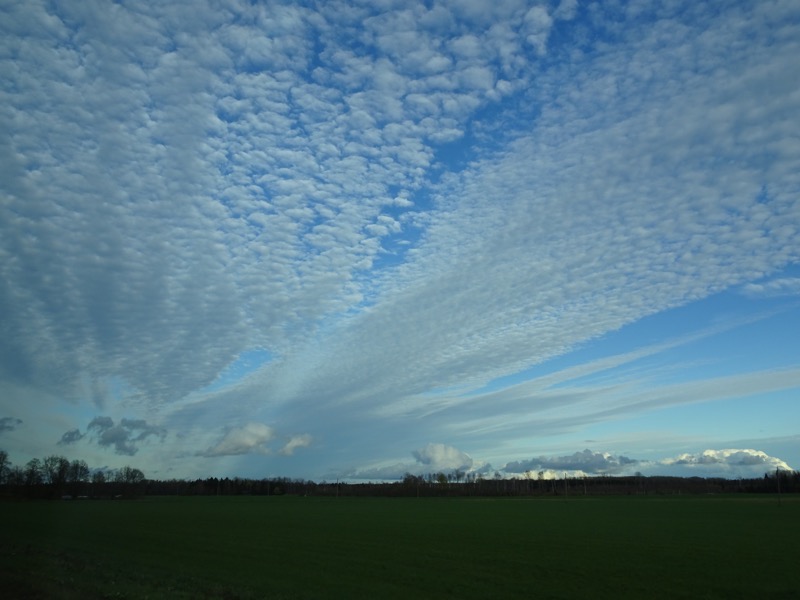 Look at this, I mean look at it:
Look at this, I mean look at it: 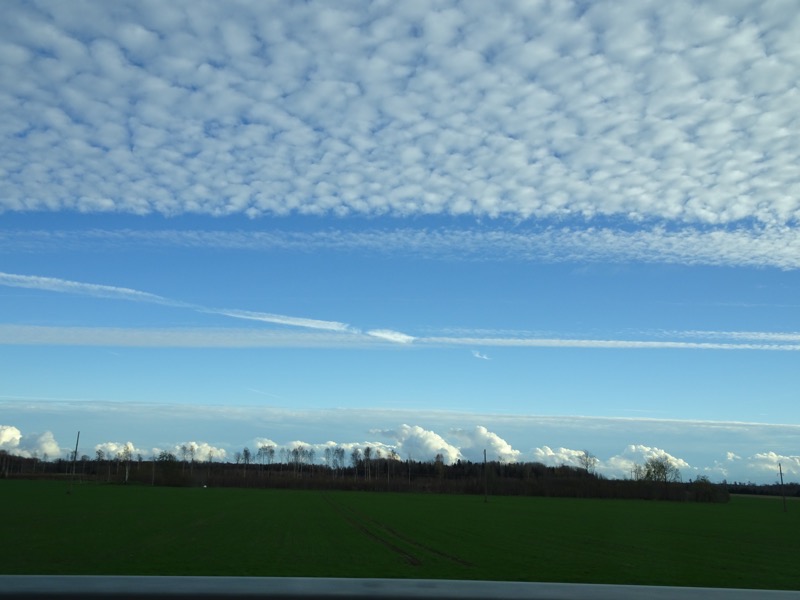 God bless the 4Gs. <3
God bless the 4Gs. <3 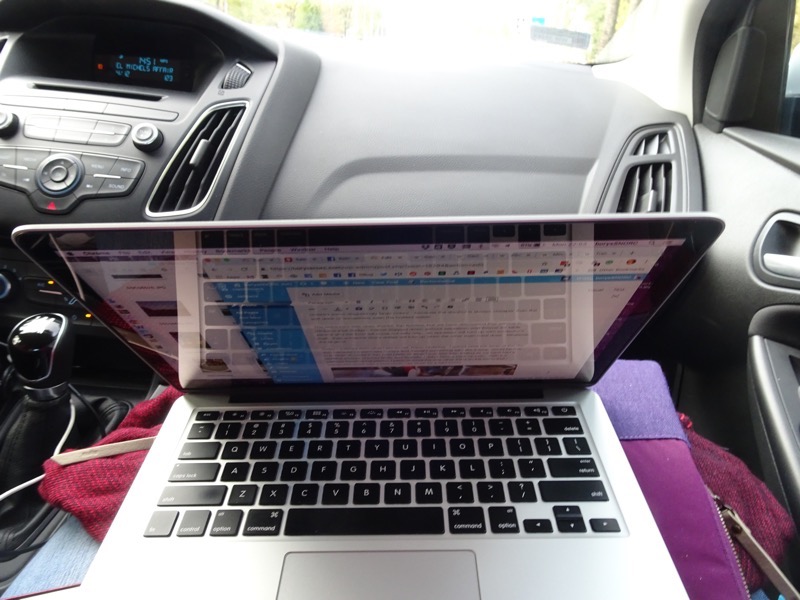
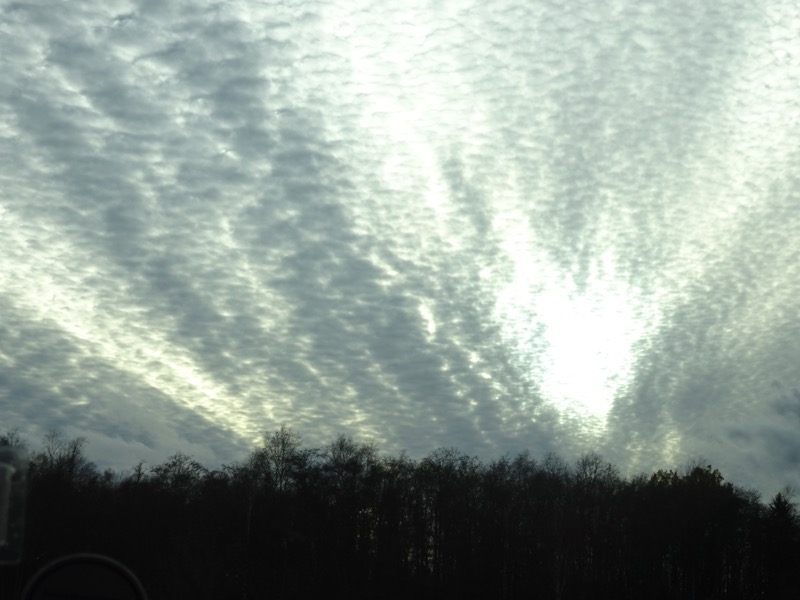
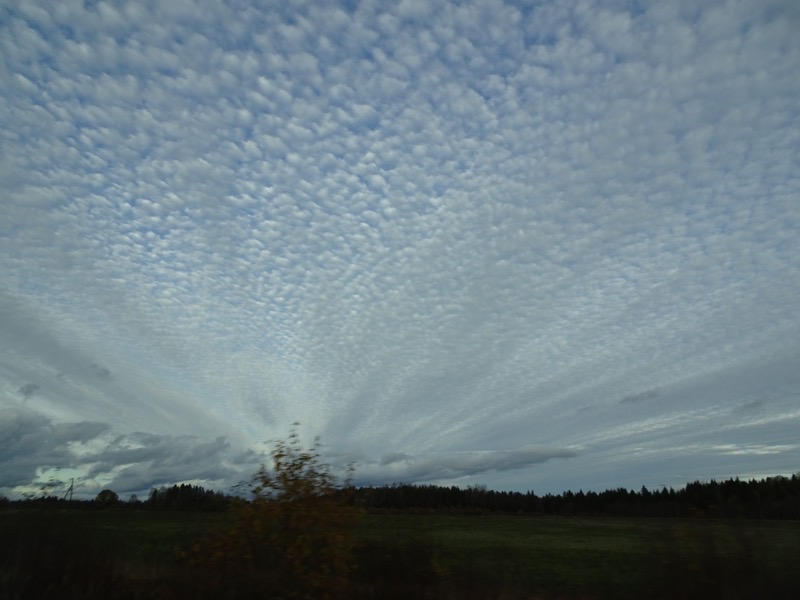
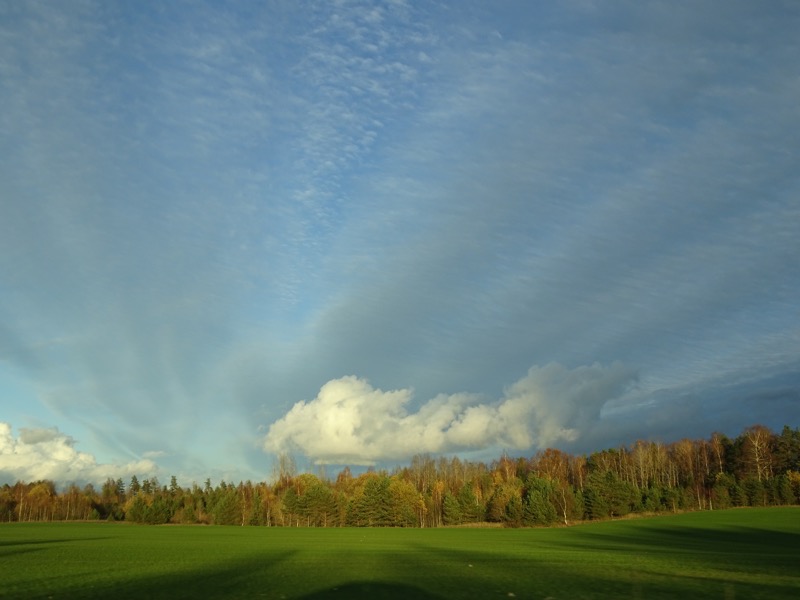 Stunning landscapes as we drove through the Lithuanian and subsequently Estonian countryside. Here lies the real benefit of not flying.
Stunning landscapes as we drove through the Lithuanian and subsequently Estonian countryside. Here lies the real benefit of not flying.
 First area we head towards was towards the Vilnius Cathedral where we first encountered Gediminas. I thought he was King Gediminas but apparently no, he was Grand Duke Gediminas of Lithuania (c1275 – 1341) which is a pretty fancy title imho. Gediminas is believed to have founded the political entity that was Lithuania and is credited with expanding its territories from the Baltic to the Black Sea. He is one of the most important persons in early Lithuanian histor – he built the capital, Vilnius, and establishing a dynasty that at one point ruled over parts of Poland, Hungary and Bohemia.
First area we head towards was towards the Vilnius Cathedral where we first encountered Gediminas. I thought he was King Gediminas but apparently no, he was Grand Duke Gediminas of Lithuania (c1275 – 1341) which is a pretty fancy title imho. Gediminas is believed to have founded the political entity that was Lithuania and is credited with expanding its territories from the Baltic to the Black Sea. He is one of the most important persons in early Lithuanian histor – he built the capital, Vilnius, and establishing a dynasty that at one point ruled over parts of Poland, Hungary and Bohemia. Nearby is the The Cathedral Basilica of St Stanislaus and St Ladislaus of Vilnius or the Vilnius Cathedral which is the main Roman Catholic Cathedral of Lithuania and considered the heart of the church and Catholicism Lithuania.
Nearby is the The Cathedral Basilica of St Stanislaus and St Ladislaus of Vilnius or the Vilnius Cathedral which is the main Roman Catholic Cathedral of Lithuania and considered the heart of the church and Catholicism Lithuania.


 It is thought that the Lithuanian King Mindaugas (he first known Grand Duke of Lithuania and the only King of Lithuania) ordered the construction of the first cathedral on this site in 1251, after he converted to Christianity and appointed a bishop to Lithuania. Remains of an archaic quadratic church with three naves and massive buttresses were discovered beneath the current structure in the late 20th century. After Mindaugas karked it however, in 1263, that cathedral went back to being a place of pagan worship again.
It is thought that the Lithuanian King Mindaugas (he first known Grand Duke of Lithuania and the only King of Lithuania) ordered the construction of the first cathedral on this site in 1251, after he converted to Christianity and appointed a bishop to Lithuania. Remains of an archaic quadratic church with three naves and massive buttresses were discovered beneath the current structure in the late 20th century. After Mindaugas karked it however, in 1263, that cathedral went back to being a place of pagan worship again.  This being Europe and all, the cathedral has a convoluted history. Around 1387, Lithuania officially converted to Christianity, they started building a second larger Gothic cathedral with five separate chapels. This one burnt down in 1419 and they planned a new larger Gothic cathedral in 1429 for the coronation of Vytautas who was suppposed to become King of Lithuania. His coronation never happened but the walls and pillars of that third Cathedral have survived to today and it has three naves and four circular towers at its corners. In 1522, the cathedral was renovated, and a bell tower was built outside on top of an old castle defensive tower. Another fire destroyed the cathedral in 1530, so it was rebuilt again around1534 – 1557 and more chapels and crypts were added. The cathedral was burnt again, built again, fell to Russian troops, was destroyed and restored several more times by more famous dukes and kings… and all that before the Soviets got hold of it in the 20th century.
This being Europe and all, the cathedral has a convoluted history. Around 1387, Lithuania officially converted to Christianity, they started building a second larger Gothic cathedral with five separate chapels. This one burnt down in 1419 and they planned a new larger Gothic cathedral in 1429 for the coronation of Vytautas who was suppposed to become King of Lithuania. His coronation never happened but the walls and pillars of that third Cathedral have survived to today and it has three naves and four circular towers at its corners. In 1522, the cathedral was renovated, and a bell tower was built outside on top of an old castle defensive tower. Another fire destroyed the cathedral in 1530, so it was rebuilt again around1534 – 1557 and more chapels and crypts were added. The cathedral was burnt again, built again, fell to Russian troops, was destroyed and restored several more times by more famous dukes and kings… and all that before the Soviets got hold of it in the 20th century. Chapel of Saint Casimir:
Chapel of Saint Casimir:
 During the Soviet regime the cathedral was converted into a warehouse of all things, and masses were not celebrated here again until 1988. In 1989 its offical status as a cathedral was restored and it has been Vilnius’ main cathedral since that time.
During the Soviet regime the cathedral was converted into a warehouse of all things, and masses were not celebrated here again until 1988. In 1989 its offical status as a cathedral was restored and it has been Vilnius’ main cathedral since that time.


 In the square in the front of the musuem is a monument to King Mindaugas, the founder of the Lithuanian state.
In the square in the front of the musuem is a monument to King Mindaugas, the founder of the Lithuanian state. Inside we discovered many antiques, antiquities and odd things, none of which seemed to have been curated with any real theme? intent? or cohesion? It was all very odd.
Inside we discovered many antiques, antiquities and odd things, none of which seemed to have been curated with any real theme? intent? or cohesion? It was all very odd. Urn, 4th century, Southern Italy:
Urn, 4th century, Southern Italy:
 Lithuanian sledge, c.1700-1750.
Lithuanian sledge, c.1700-1750. Sarcophagus received as a gift by Museum of Antiquities in 1899 from Prince Chlodwig Karl Viktor Hohenlohe, then German Chancellor. Originates from Egypt (obviously) but no mention of date, location or what tomb it came from?
Sarcophagus received as a gift by Museum of Antiquities in 1899 from Prince Chlodwig Karl Viktor Hohenlohe, then German Chancellor. Originates from Egypt (obviously) but no mention of date, location or what tomb it came from?
 Obelisk with samples of Russian materials, 19th century.
Obelisk with samples of Russian materials, 19th century.
 Maria Mnishek (1588-1614, wife of the Czars of Russia, Lzhedmirty I and Lzhedmirty II (did she remarry his brother? her son? his cousin? who knows?) Unknown artist, 1609.
Maria Mnishek (1588-1614, wife of the Czars of Russia, Lzhedmirty I and Lzhedmirty II (did she remarry his brother? her son? his cousin? who knows?) Unknown artist, 1609. Vytautas the Great, Grand Duke of Lithuania from 1401 to 1430.
Vytautas the Great, Grand Duke of Lithuania from 1401 to 1430. Iron window bars, Lithuanian 16th century (no idea where from?).
Iron window bars, Lithuanian 16th century (no idea where from?).
 Guild’s chest (which guild?!), Lithuanian 17th century.
Guild’s chest (which guild?!), Lithuanian 17th century.

 Banner of the Immaculate Conception Fraternity at the Vilnius Bernadine Church, 1600-1650s… in bad need of conservation and repair.
Banner of the Immaculate Conception Fraternity at the Vilnius Bernadine Church, 1600-1650s… in bad need of conservation and repair.
 Lithuanian pew, 1683
Lithuanian pew, 1683
 Chest with heraldic device of the Korff and Osten-Sacken families, Latvian c.1680.
Chest with heraldic device of the Korff and Osten-Sacken families, Latvian c.1680. Hook to Drag Plague Victims, Vilnius, earl 18th century… no other information about plague?!
Hook to Drag Plague Victims, Vilnius, earl 18th century… no other information about plague?! Persian helmet, Turkey, 17th – 18th centuries.
Persian helmet, Turkey, 17th – 18th centuries. Chair, first half of the 17th century.
Chair, first half of the 17th century. 
 Tablet woven sashes, Lithuanian Minor and South-west Lithuania early 19th century.
Tablet woven sashes, Lithuanian Minor and South-west Lithuania early 19th century.


 Dowry chest, middle Lithuania, late 19th century.
Dowry chest, middle Lithuania, late 19th century. Spinning wheel, middle Lithuania, late 19th century, early 20th century.
Spinning wheel, middle Lithuania, late 19th century, early 20th century. Toy musuem:
Toy musuem:



 Recreated guest room in a typical Zemaicai house in the early 19th century.
Recreated guest room in a typical Zemaicai house in the early 19th century.  Kitchen/pantry:
Kitchen/pantry:
 Living/Dining rooms:
Living/Dining rooms: Wooden religious monument tops, various regions, 19th century.
Wooden religious monument tops, various regions, 19th century.

 St George…
St George… St Florian…
St Florian…
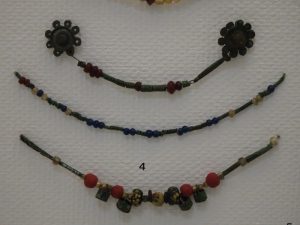
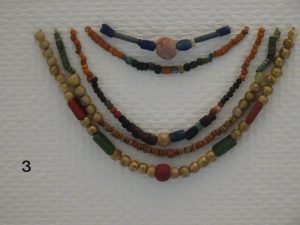
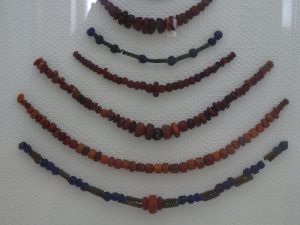
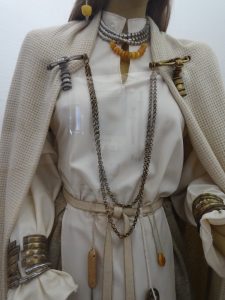
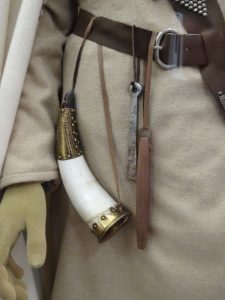
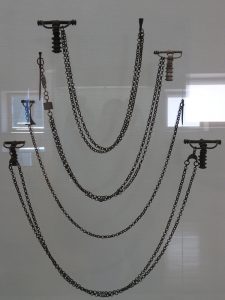
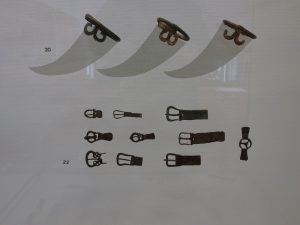
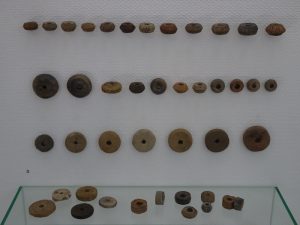
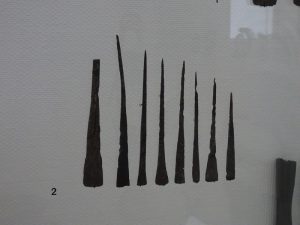
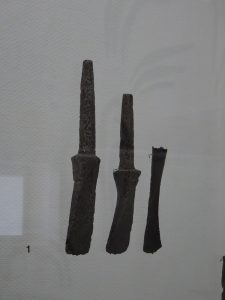
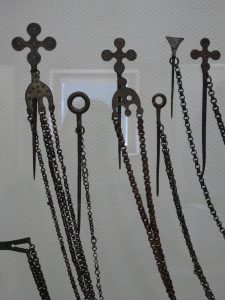
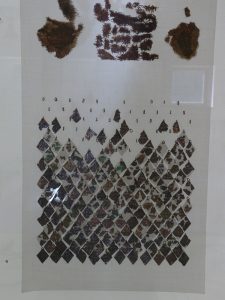
 It’s a seriously shitty climb.
It’s a seriously shitty climb. Almost to the top:
Almost to the top: The tower normally houses a museum exhibiting archaeological findings from the hill and the surrounding areas and has models of Vilnius castles from the 14th to the 17th centuries, and some armaments, and other iconographic material of Old Vilnius – normally. However, on this occasion, most of the complex is closed for restoration due to what seems to be a rather nasty landslide and part of the castle starting to look like it’s going to slide down into a river?
The tower normally houses a museum exhibiting archaeological findings from the hill and the surrounding areas and has models of Vilnius castles from the 14th to the 17th centuries, and some armaments, and other iconographic material of Old Vilnius – normally. However, on this occasion, most of the complex is closed for restoration due to what seems to be a rather nasty landslide and part of the castle starting to look like it’s going to slide down into a river? Towards the university grounds:
Towards the university grounds: Gediminas’ Tower:
Gediminas’ Tower: After we made our way through the castle complex, most of which was behind scaffolding, we clambered carefully back down the cobbled hill – because of course if you are going to go tits up, it will be while going downhill and went for a walk around the bottom of the castle tower base. I simply can not get over these gorgeous autumn colours.
After we made our way through the castle complex, most of which was behind scaffolding, we clambered carefully back down the cobbled hill – because of course if you are going to go tits up, it will be while going downhill and went for a walk around the bottom of the castle tower base. I simply can not get over these gorgeous autumn colours. 

 The tower from Cathedral Square:
The tower from Cathedral Square: Presidential Palace: This building is the central part of the former Governor’s Palace. The first palace was built here in the 15th century and used as the Vilnius bishops’ residence until 1795 when it was given to the governor-general. It currently holds the President’s official offices.
Presidential Palace: This building is the central part of the former Governor’s Palace. The first palace was built here in the 15th century and used as the Vilnius bishops’ residence until 1795 when it was given to the governor-general. It currently holds the President’s official offices. After this, we went hunting for a bit of lunch at a place called Būsi Trečias. Something local, affordable and hopefully not too far. Trip Advisor can be great for finding restaurants and it served us well last night, but sometimes it can be a bit hit and miss. We found a restaurant called and immediately ordered some disgustingly large ciders – because the alcohol is always cheaper than the soft drink or sometimes even the bottled water!
After this, we went hunting for a bit of lunch at a place called Būsi Trečias. Something local, affordable and hopefully not too far. Trip Advisor can be great for finding restaurants and it served us well last night, but sometimes it can be a bit hit and miss. We found a restaurant called and immediately ordered some disgustingly large ciders – because the alcohol is always cheaper than the soft drink or sometimes even the bottled water! yale ordered what was called a ‘Village Pan’ and was full of potato, bacon and mushrooms, gherkins and god knows what else. It was okay in the end, yale more than happily assisted in polishing off the pork hock (well the chunks of it that weren’t fat and bone that is).
yale ordered what was called a ‘Village Pan’ and was full of potato, bacon and mushrooms, gherkins and god knows what else. It was okay in the end, yale more than happily assisted in polishing off the pork hock (well the chunks of it that weren’t fat and bone that is). After lunch, we went for a quick wander down the main street of the Old Town to see what the other tourists are doing today. It was fairly quiet – I think that is the benefit of being here off-peak. Not many monument hogging selfie obsessed tourists around these parts.
After lunch, we went for a quick wander down the main street of the Old Town to see what the other tourists are doing today. It was fairly quiet – I think that is the benefit of being here off-peak. Not many monument hogging selfie obsessed tourists around these parts. Souvenir shops are the same the world over aren’t they? Full of stuff no one needs and hardly anyone wants. I collected my pins and we moved one.
Souvenir shops are the same the world over aren’t they? Full of stuff no one needs and hardly anyone wants. I collected my pins and we moved one.

 I was trying to take a photo of this amazing building, and couldn’t find a good vantage point to capture the brickwork. It was only after I took about four pictures that I realised he was getting annoyed at me taking his photo (and not dropping coins in his hat I dare say), whereas the truth was, I’m standing there thinking, ‘Why has that guy plonked himself and his ugly purple trolley right in front of the only building in the street that I want to photograph!?’
I was trying to take a photo of this amazing building, and couldn’t find a good vantage point to capture the brickwork. It was only after I took about four pictures that I realised he was getting annoyed at me taking his photo (and not dropping coins in his hat I dare say), whereas the truth was, I’m standing there thinking, ‘Why has that guy plonked himself and his ugly purple trolley right in front of the only building in the street that I want to photograph!?’ Wine bar on the corner near our B&B.
Wine bar on the corner near our B&B.
 We had decided to spend the last few hours of the day going for a drive out to the Trakai ‘medieval castle’. Was surprised to see hot air balloons up at 3pm in the afternoon – at home, it seems to be an early dawn activity.
We had decided to spend the last few hours of the day going for a drive out to the Trakai ‘medieval castle’. Was surprised to see hot air balloons up at 3pm in the afternoon – at home, it seems to be an early dawn activity. Trakai is a very touristy village near the castle, that seems to have sprung up to serve the tourists that come to visit the place. Full of bright coloured buildings, cafes and gift shops.
Trakai is a very touristy village near the castle, that seems to have sprung up to serve the tourists that come to visit the place. Full of bright coloured buildings, cafes and gift shops.

 Like so many of the other historic places we have visited this trip, the castle suffered several major catastrophes over the ensuing centuries including – an attack by Teutonic Knights in 1377 and a power struggle between Jogaila and Vytautas the Great for the title of Grand Duke of Lithuania after the assassination of Kęstutis. The castle was besieged by both sides of that spat, but soon after they reconciled and the major phase of construction started and continued until 1409, which was just before the Battle of Grunwald (between the Teutonic Knight and the Polish/Lithuanian Forces), after which the castle lost its relevance as a strategic military fortress.
Like so many of the other historic places we have visited this trip, the castle suffered several major catastrophes over the ensuing centuries including – an attack by Teutonic Knights in 1377 and a power struggle between Jogaila and Vytautas the Great for the title of Grand Duke of Lithuania after the assassination of Kęstutis. The castle was besieged by both sides of that spat, but soon after they reconciled and the major phase of construction started and continued until 1409, which was just before the Battle of Grunwald (between the Teutonic Knight and the Polish/Lithuanian Forces), after which the castle lost its relevance as a strategic military fortress. The castle is mainly built out of red Gothic bricks. Stone blocks were used only in the foundations and for some of the upper parts of buildings, towers and walls. It has been decorated with glazed roof tiles, burned bricks, and (some very dodgy) stained glass windows. Its overall style after the second construction phase could be described as Gothic with some Romanesque features.
The castle is mainly built out of red Gothic bricks. Stone blocks were used only in the foundations and for some of the upper parts of buildings, towers and walls. It has been decorated with glazed roof tiles, burned bricks, and (some very dodgy) stained glass windows. Its overall style after the second construction phase could be described as Gothic with some Romanesque features. After the Battle of Grunwald, the castle was no longer of any military importance, so it was turned into a residence for the Grand Dukes of Lithuania. The caste was redecorated, frescos were added and foreign emissaries were welcomed in the Ducal Palace.
After the Battle of Grunwald, the castle was no longer of any military importance, so it was turned into a residence for the Grand Dukes of Lithuania. The caste was redecorated, frescos were added and foreign emissaries were welcomed in the Ducal Palace. Grand Duke Vytautas the Great died in the castle in 1430 leaving it in the hands of Sigismund Augustus who used it as a royal summer residence until 1511, and it was redecorated in a Renaissance style. Later the castle served as a prison and during the wars with Muscovy in the 17th century, the castle was damaged, but this time was not reconstructed and it gradually fell into disrepair.
Grand Duke Vytautas the Great died in the castle in 1430 leaving it in the hands of Sigismund Augustus who used it as a royal summer residence until 1511, and it was redecorated in a Renaissance style. Later the castle served as a prison and during the wars with Muscovy in the 17th century, the castle was damaged, but this time was not reconstructed and it gradually fell into disrepair. in 1888, the Imperial Archaeological Commission planned were made to rebuild the castle and in 1905, the Imperial Russian authorities decided to partially restore the castle ruins. During World War I, Germans brought in their restoration specialists, who made several attempts to rebuilt the castle and then between 1935-1941, parts of the Ducal Palace walls were rebuilt. Up until WWII, Lithuanian and Polish conservationists worked on castle project, but all work stopped when the war was raging all over Europe. After WWII, a major reconstruction project was begun in 1946 with actual restoration work started in 1951–1952. The major portion of the reconstruction was eventually finished in the 1960s with the goal of reconstructing the castle in a 15th century style to be a major tourist attraction, which has resulted in a cross between Hampton Court Palace and Bli Bli Castle. :/
in 1888, the Imperial Archaeological Commission planned were made to rebuild the castle and in 1905, the Imperial Russian authorities decided to partially restore the castle ruins. During World War I, Germans brought in their restoration specialists, who made several attempts to rebuilt the castle and then between 1935-1941, parts of the Ducal Palace walls were rebuilt. Up until WWII, Lithuanian and Polish conservationists worked on castle project, but all work stopped when the war was raging all over Europe. After WWII, a major reconstruction project was begun in 1946 with actual restoration work started in 1951–1952. The major portion of the reconstruction was eventually finished in the 1960s with the goal of reconstructing the castle in a 15th century style to be a major tourist attraction, which has resulted in a cross between Hampton Court Palace and Bli Bli Castle. :/







 … Some not so genuine, like these lovely c.1970s post-modern stained glass windows (thankfully the lime green diagonal design is not so apparent in these photographs).
… Some not so genuine, like these lovely c.1970s post-modern stained glass windows (thankfully the lime green diagonal design is not so apparent in these photographs).


 Recreated stained glass windows that date all the way back to 2006.
Recreated stained glass windows that date all the way back to 2006.
 Photos of the Castle before the major renovations started in 1940s.
Photos of the Castle before the major renovations started in 1940s.
 Other areas of the castle contain collections that have been donated to the Trakai Island Castle for display. Collections of official seals, pipes, Russian enamelware, taxidermied animals, and all sorts of other crap* are stored here (*weirdly gifts that appear to have been given to Lithuanian government officials over the last decade are all on display… weird plates from China in 2012, and just weird shit that has nothing to do with a 15th century castle).
Other areas of the castle contain collections that have been donated to the Trakai Island Castle for display. Collections of official seals, pipes, Russian enamelware, taxidermied animals, and all sorts of other crap* are stored here (*weirdly gifts that appear to have been given to Lithuanian government officials over the last decade are all on display… weird plates from China in 2012, and just weird shit that has nothing to do with a 15th century castle).



 Still, it was quite a nice visit and it is so beautifully situation, it is well worth a look. I wouldn’t’ recommend checking it out in the middle of summer though, unless you were going to run in first thing in the morning or last thing in the afternoon and maybe get the place half empty – you can tell by the traffic flow that is set up, that it is probably a madhouse during peak season.
Still, it was quite a nice visit and it is so beautifully situation, it is well worth a look. I wouldn’t’ recommend checking it out in the middle of summer though, unless you were going to run in first thing in the morning or last thing in the afternoon and maybe get the place half empty – you can tell by the traffic flow that is set up, that it is probably a madhouse during peak season. After this, it was back to Vilnius for the evening and another night at the crazy Bernadinau B&B. Vilnius has been lovely… didn’t find the G-Spot though.
After this, it was back to Vilnius for the evening and another night at the crazy Bernadinau B&B. Vilnius has been lovely… didn’t find the G-Spot though. Some cute churches, and everything all sweet and fabulous…
Some cute churches, and everything all sweet and fabulous…  Until we encountered kilometres and kilometres of trucks all lined up in a dead stand still. For a while we thought it might be some sort of rolling blockade protest – people around here seem to be constantly protesting something. Or perhaps they were all lined up waiting for a weighbridge station, given how politely they were all lined up on the right and letting the cars pass them. We then came across this – the lane we had been travelling also at a dead stop of cars. Bugger, we thought – it was obviously the queue for the Polish/Lithuania border. So we pulled up behind the blue car in the photo below…
Until we encountered kilometres and kilometres of trucks all lined up in a dead stand still. For a while we thought it might be some sort of rolling blockade protest – people around here seem to be constantly protesting something. Or perhaps they were all lined up waiting for a weighbridge station, given how politely they were all lined up on the right and letting the cars pass them. We then came across this – the lane we had been travelling also at a dead stop of cars. Bugger, we thought – it was obviously the queue for the Polish/Lithuania border. So we pulled up behind the blue car in the photo below…  At this point, one of the truck drivers (most of whom were not in their vehicles) came over and told us to drive around. He pointed to the licence plate of the blue car, Belarussian, and he gestured for us to go around (our vehicle obviously had Polish plates on it). So we dutifully went around and ended up at the top of the queue:
At this point, one of the truck drivers (most of whom were not in their vehicles) came over and told us to drive around. He pointed to the licence plate of the blue car, Belarussian, and he gestured for us to go around (our vehicle obviously had Polish plates on it). So we dutifully went around and ended up at the top of the queue:
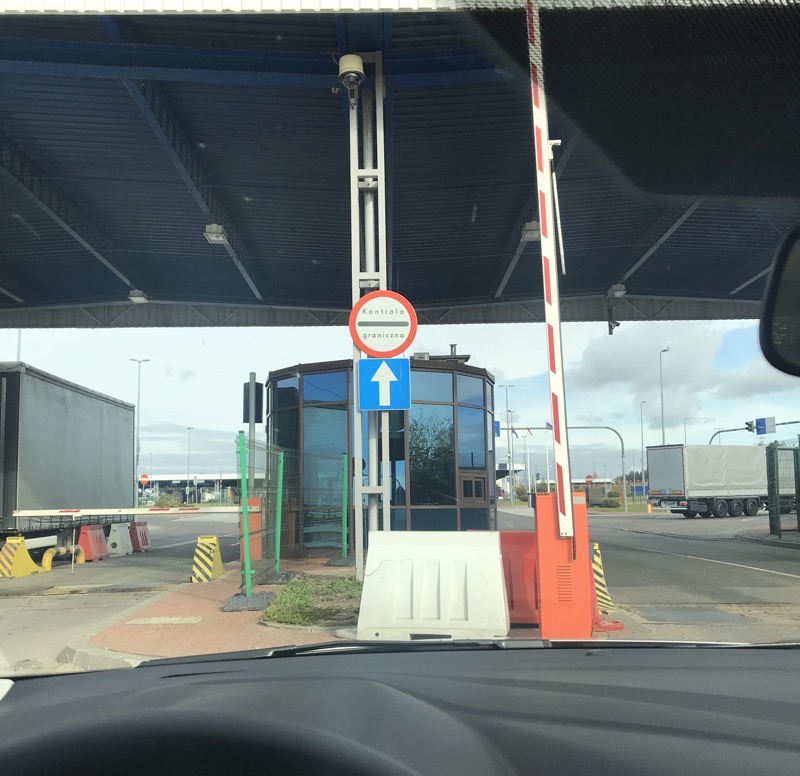 Whereupon it became obvious that we were in the middle of the military checkpoint to enter Belarus! Which meant we were miles from where we were supposed to be, and well and truly inside the borders of Belarus! Fark!
Whereupon it became obvious that we were in the middle of the military checkpoint to enter Belarus! Which meant we were miles from where we were supposed to be, and well and truly inside the borders of Belarus! Fark! Now we knew when we set out that there were two routes to get us to Vilnius, one of which was slightly shorter and chopped through the corner of what is effectively the dictatorial presidential state of Belarus and the other which went only through the border between Poland and Lituania. Now, guess which route yale somehow programmed into Wayz…?
Now we knew when we set out that there were two routes to get us to Vilnius, one of which was slightly shorter and chopped through the corner of what is effectively the dictatorial presidential state of Belarus and the other which went only through the border between Poland and Lituania. Now, guess which route yale somehow programmed into Wayz…?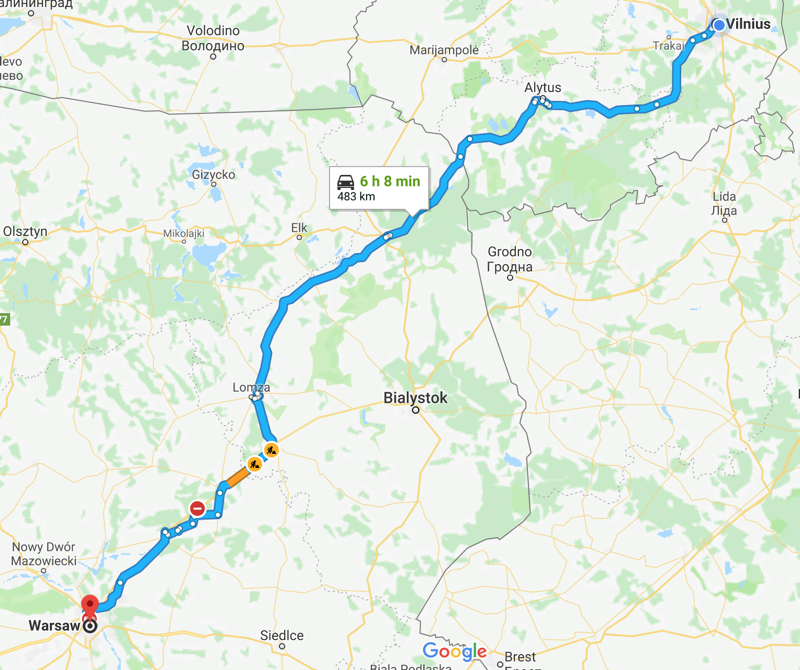
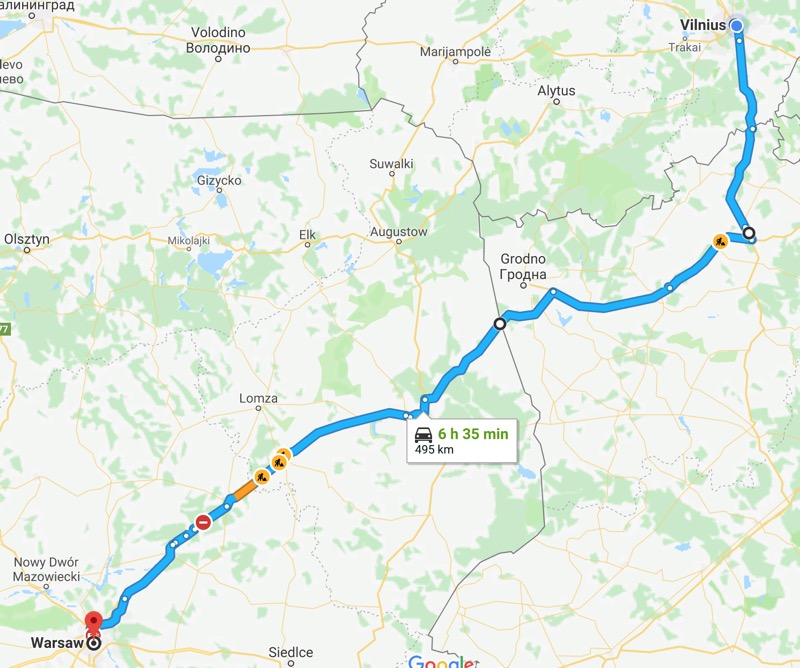
 The countryside was simply stunning though – there is a beautiful quality to the light here (once you get out of the cities).
The countryside was simply stunning though – there is a beautiful quality to the light here (once you get out of the cities).
 Honestly, I grabbed these shots out the car window as we sped past and they have not been altered or had filters added or anything.
Honestly, I grabbed these shots out the car window as we sped past and they have not been altered or had filters added or anything.

 Stopped at a servo for a fortifying something something after our little run in with the Belarus Border Force guys.
Stopped at a servo for a fortifying something something after our little run in with the Belarus Border Force guys.


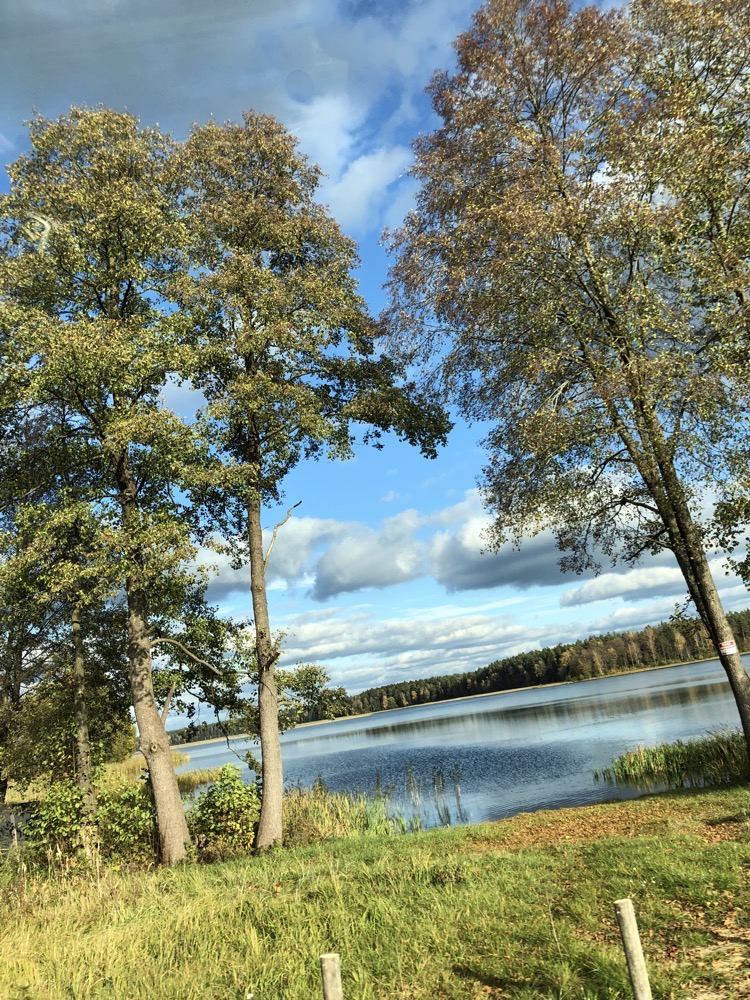

 WWII memorial in a little town on the way.
WWII memorial in a little town on the way.
 Oddly, the Polish/Lithuanian border was far more like what we had been expecting – almost non-existent. Being both part of the Schengen Agreement, there is pretty much borderless exchange between the two countries. We did see some guards in a jeep on the side of the road, but they weren’t doing anything at all.
Oddly, the Polish/Lithuanian border was far more like what we had been expecting – almost non-existent. Being both part of the Schengen Agreement, there is pretty much borderless exchange between the two countries. We did see some guards in a jeep on the side of the road, but they weren’t doing anything at all. The delay set up back a little arriving into Vilnius, but we arrived found our B&B and got settled pretty quickly.
The delay set up back a little arriving into Vilnius, but we arrived found our B&B and got settled pretty quickly. The B&B is in an old building with massive oak beams, exposed brick and stuccoed walls and old chunky furniture, right in the middle of the city.
The B&B is in an old building with massive oak beams, exposed brick and stuccoed walls and old chunky furniture, right in the middle of the city. 

 After our adventure just driving here today, we decided to try and find some local food for dinner. yale scoped out this place on Trip Advisor and it had the two most desireable elements we could have asked for, 1) great reviews and 2) mega close proximity. Because it had been a long day already.
After our adventure just driving here today, we decided to try and find some local food for dinner. yale scoped out this place on Trip Advisor and it had the two most desireable elements we could have asked for, 1) great reviews and 2) mega close proximity. Because it had been a long day already. We walked in and there was a wait for a table. The restaurant didn’t appear to be very big so we were a bit disheartened and I was considering looking for other options, when it became apparent that there must be more space off to the side of the entrance and perhaps downstairs as well. We didn’t have to wait too long for a table and were led downstairs through a veritable rabbit warren on cosy dining spaces.
We walked in and there was a wait for a table. The restaurant didn’t appear to be very big so we were a bit disheartened and I was considering looking for other options, when it became apparent that there must be more space off to the side of the entrance and perhaps downstairs as well. We didn’t have to wait too long for a table and were led downstairs through a veritable rabbit warren on cosy dining spaces. First things first – a drink! This place does paddles of brandy tasting so we thought we’d give that a go.
First things first – a drink! This place does paddles of brandy tasting so we thought we’d give that a go.
 From the left, very drinkable with cherry flavours, quite sweet with honey overtones, something akin to metho, disgustingly strong liquorice shit, and slightly less strong but equally disgusting liquorice shit! Still, most of it went down just fine.
From the left, very drinkable with cherry flavours, quite sweet with honey overtones, something akin to metho, disgustingly strong liquorice shit, and slightly less strong but equally disgusting liquorice shit! Still, most of it went down just fine.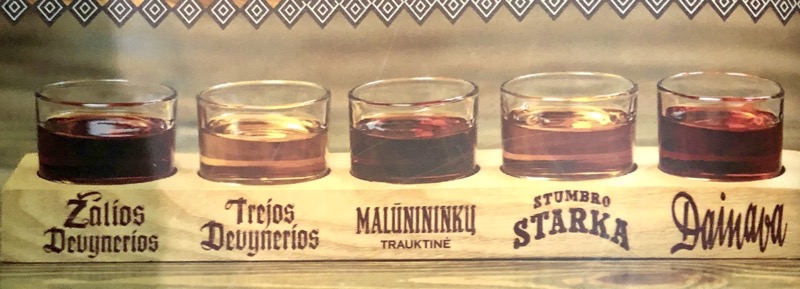
 For entrees, everything looked really good on what is an extensive menu. We ordered a few plates to try – fried cheese with bell peppers (effectively jalapeno poppers – which seemed odd for Lithuanian cuisine, but my knowledge there is quite limited).
For entrees, everything looked really good on what is an extensive menu. We ordered a few plates to try – fried cheese with bell peppers (effectively jalapeno poppers – which seemed odd for Lithuanian cuisine, but my knowledge there is quite limited).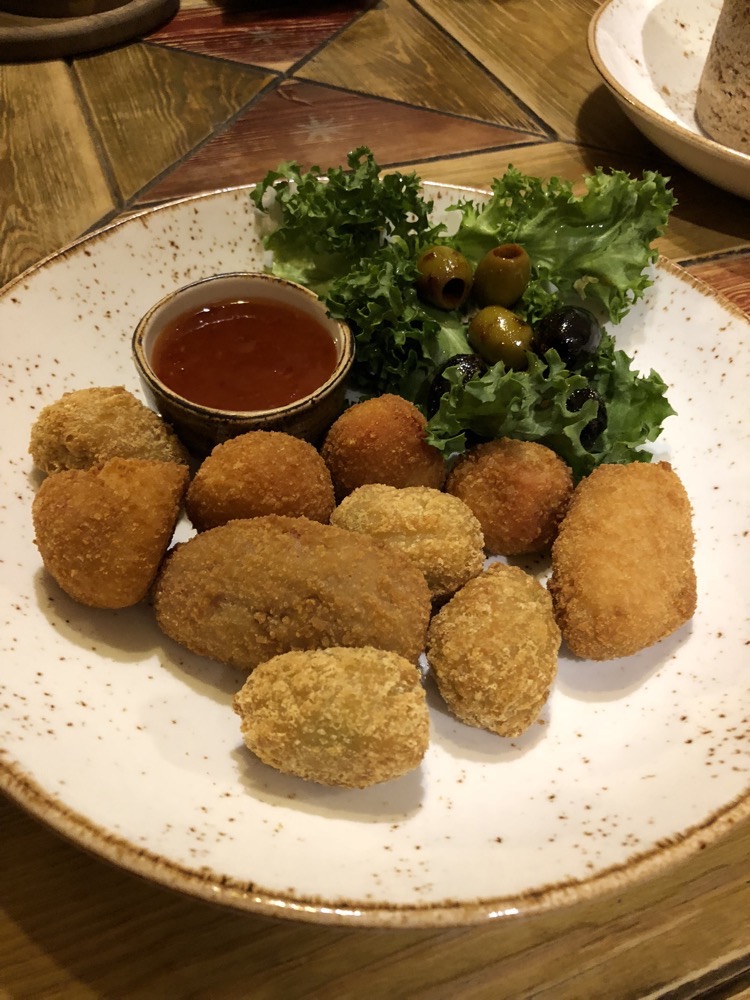 Next we tried the ‘thick and creamy wild mushroom soup’… which I tried and exclaimed “I hate this place! Best mushroom soup I have ever had, and it’s in bloody Lithuania!”
Next we tried the ‘thick and creamy wild mushroom soup’… which I tried and exclaimed “I hate this place! Best mushroom soup I have ever had, and it’s in bloody Lithuania!” yale also ordered a second entree of meat dumplings served with sour cream and some sort of nutty soupy broth stuff. It was very tasty – somehow just the right amount of salty.
yale also ordered a second entree of meat dumplings served with sour cream and some sort of nutty soupy broth stuff. It was very tasty – somehow just the right amount of salty. We had finished the brandy tasting paddle and the beers etc, so yale ordered a couple of meads and a homemade vodka. On the left honey mead, the vodka (average, but we may have been spoiled of late) and some god awful herbal mead shit that was 75% alcohol! Man that stuff is strong.
We had finished the brandy tasting paddle and the beers etc, so yale ordered a couple of meads and a homemade vodka. On the left honey mead, the vodka (average, but we may have been spoiled of late) and some god awful herbal mead shit that was 75% alcohol! Man that stuff is strong.
 Dinner consisted of venison meatballs served with spinach mashed potato, loads of beetroot and a cranberry/blueberry sauce. Delicious.
Dinner consisted of venison meatballs served with spinach mashed potato, loads of beetroot and a cranberry/blueberry sauce. Delicious. And yale had some enormous dumpling things filled with mean and drowning in a thick mushroom sauce.
And yale had some enormous dumpling things filled with mean and drowning in a thick mushroom sauce. After dinner (and all those strong drinks) we barely managed to find our way out of the hidden tunnels of amazing foody goodness.
After dinner (and all those strong drinks) we barely managed to find our way out of the hidden tunnels of amazing foody goodness.


 We want to get a full day to check out Vilnius tomorrow and both of us have laundry that needed attending to so we head back to the B&B for what was supposed to be an early night but it is already getting close to midnight. Again.
We want to get a full day to check out Vilnius tomorrow and both of us have laundry that needed attending to so we head back to the B&B for what was supposed to be an early night but it is already getting close to midnight. Again.